
#14 The Work Style Magazine — # 14.2014 — Europe ¤ 12.50, US $ 15.50, World ¤ 18 — Poste Italiane - Spedizione in abbonamento postale - 70% - LO/MI A worldwide observatory on work style changes Work Style 11 Time 22 Nepotism: A Blessing or Curse for Organizations? 28 It’s All About Behaviors 34 Avoiding the Pitfalls of Performance Evaluation 46 Searching for the Right Person 80 Opticals Are the New Black 85 HR Events for Work 93 Food for Work 166 Why Libreville Works 168 Show Me Your Honne! TakeYour Time
































































































































































































Work Style — #14.14 Work Style — #14.14
Colophon
#14 issue, Fall 2014
International publisher
GWH SA owner of Work Style
Via Dufour 2, 6901 Lugano, Switzerland T 0041 22 548 00 06
W www.theworkstylemagazine.com E welcome@gwhswiss.com
US address: The Work Style Magazine 2578 Broadway, Suite 150 New York, NY, 10025
Italy address The Work Style Editorial Board
Via Cesare Balbo 4, 20136 Milan, Italy T 0039 02 367 56898 0039 380 6936502
Printing: Italgrafica, Via Verbano 146, 28100 Novara, Italy. At Work Style we care about the environment, so we print our magazine on 100% recycled paper.
Periodical magazine registered at the Milan Court
Chairman: Mirko Nesurini
Editor in chief: Rosario Imperiali d’Afflitto
Editor: Marta Scetta
Foreign editor: Pina Draskovich
Section editors: Allan Hall, Chiara Tentori, Cristina Milani, Emmanuel Maindron, Francesca Morelli, Luca Brunoni, Martha Tintin, Nigel Phillips, Palle Ellemann, Peter Conrad, Roberto Benzi, Sam Nallen Copley
Section illustrators: Agata Karelus, Brian Taylor, Doug Cowan, Eelco Van den Berg, Goñi Montes, Hanna Melin, John Joven, Natalie Andrewson, Patt Kelley, Paul Davis, Sergio Membrillas
Cover illustrator Beppe Giacobbe
Authors’ illustrator: Alessandro Baronciani
Other illustrators Alex Mathers, Nico189, Stephanie Wunderlich, Xavi Ramiro, Yolanda Oreiro Photographers: Barbara Pavie, Dario Invernizzi, Darren Greenwood, David Rodríguez, Dolph Cantrijn Paolo Mazzo, Désirey Minkoh, Hans Peter Ebner, Isadora De Pasquale, Keith Barraclough, Reiko Nonaka, Roberto Benzi, Valeria Squillante
100 Work Cities
Filippo De Bortoli, Paolo Mazzo 100workcities.com
Advertising / Subscriptions
Roberta Donati
E roberta@gwhswiss.com T 0041 22 548 00 06
9 Introduction Here-and-Now
11 Thinking Out of the Box Time and Anxiety
• It’s All a Matter of Prioritizing by David Solly
• Pressure and Challenges are Stimuli by Emma Donaldson – Feilder
• A Waste of Time and Attention by Scott Eblin
• Time and Anxiety Matter by Steve M. Cohen
13 Thinking Out of the Box Time and Responsibility
• From Activity to Productivity by John Murphy
• “God Chronos” Can be Beaten by Luiz Serafim
• Delegate Tasks and Trust Staff by Philip Nardone Jr.
• Being a Team is Better by Wendy Capland
THINKING OUT OF THE BOx
In our fast-paced world, our perception of time has changed significantly, and we often feel like days should have 48 hours.
15 Thinking Out of the Box Time and Value
• Learning From Differences by Lisa Bull
• Familiar Patterns Versus New Trends by Liz Wiseman
• The Youngest, the Smartest by Praveen Puri
• The More Experience, the More Value by Steve McKee
17 Thinking Out of the Box Time and Technology
• It Takes a Little Discipline by Barbara Tagliaferri
• The Backbone of a Working Life by Kristelle Siarza
• Better Technology, Better Working Life by Marisandra Lizzi
• More Efficient and Productive by Tony Lopresti
2BEST PRACTICES
22 Meritocracy
• Nepotism: A Blessing or Curse for Organizations? by Margaret Y. Padgett associate professor of management at Butler University, Indianapolis (USA)
• Nepotism: Fast Track to a Wrong Hire! by Andreea Hrab, recruitment partner at Cross Border Talent, Brasov (Romania)
24 Recognition
• Creating Value for Others Through Recognition: Not Easy, But Worth It! by Christine M. Riordan provost at University of Kentucky, Lexington (USA)
25 Health
• Cervical Spondylosis and Office Workers by Francesca Morelli, Work Style, Milan (Italy)
26 Coaching
• Keep Your Employees Happy by Allan Hall Work Style, Berlin (Germany)
28 Training
• It’s All About Behaviors by Marc Ruysschaert controller of learning services at Ricoh Europe, Antwerp (Belgium)
30 Compliance
• Assessing the Risk of Corruption by Silva Annovazzi, senior associate at Grimaldi Law Firm, Milan (Italy)
32 Legal
• Database: A New Profitable Resource by Pina Draskovich, Work Style, Lugano (Switzerland)
• E-mail Marketing and Privacy: The Privacy Policy Framework in Europe by Diego Fulco partner at netforLegal, Milan (Italy)
34 Performance
• Avoiding the Pitfalls of Performance Evaluation by Palle Ellemann Knudsen, Work Style, Bagsvaerd (Denmark)
36 Attachment and Pride
• Creating Employee Motivation by Nigel Phillips Work Style, London (UK)
38 Communication
• #Whereismyflight? by Luca Brunoni, Work Style, Neuchâtel (Switzerland)
39 Culture Integration
• The Legacy of the Heart by Alex Di Martino Work Style, London (England)
40 Change Management
• From Technicalities to Hydrobiology by Roberto Benzi, Work Style, Milan (Italy)
44 Unusual Job
• The Voice-Over: Giving Life with your Voice by Martha Tintin, Work Style, Lugano (Switzerland)
46 Joining the Company
18 Psychology
In working world professionals are called upon to face a new challenge: being more flexible and more skilled in managing time and organizing tasks.
• The Perils of Time Pressure by Craig Dowden, founder and president of Craig Dowden & Associates, Toronto (Canada)
• Run, Run, Run! by Ronald Riggio Henry R. Kravis Professor of Leadership and Organizational Psychology at Claremont McKenna College, Claremont (USA)
• Searching for the Right Person by Federica Milani Work Style, Milan (Italy)
4 Work Style — #14.14 Work Style — #14.14 5
1
Others contributors:
Marta Demarteau hydrobiologist at AQUON Institute, Goirle (The Netherlands), Anna Khaude CEO at Affordable Yoga, Paris (France), Elio Cristiani, craftsman, Milan (Italy), Francesca De Lucchi owner of Divina Piadina, Milan (Italy), Doug Reynolds, senior vice president of assessment technology at DDI, Pittsburgh (USA), Carol Olsby principal at Carol Olsby & Associates Inc., Washington (USA), Evelyn Grace C. Sorongon vice president and managing director at John Clements Consultants Inc., Manila (Philippines), Guy Beaudin senior partner at RHR International, Toronto (Canada), Roger Del Pozo, director of acting admissions at the New York Film Academy, New York (USA), Carmen Gambín general manager at Escuela del Doblaje (Dubbing School) of DL Multimedia, Madrid (Spain), JP Orr head of voice production and training director at The Showreel, London (UK), Joanna Ruiz voice-over actor, Cardiff (Wales),
53 Design for Work
54 People to Watch:
• Brendt Barbur
Founding partner of Bicycle Film Festival New York (USA)
•Jane Lu CEO of Showpo Smeaton Grange (Australia)
• Jodie Fox
Founder of Shoes of Prey Sydney (Australia)
• Kimihito Okubo
Founder and principal at One to World Tokyo (Japan)
• Sacha Beverley Gallery owner at Sacha Beverley Art & Design Surry Hills (Australia)
• Marta González Tarruella Fashion and lifestyle blogger Madrid (Spain)
• Nicolás Ovalle
Co-founder of Banana Split Montevideo (Uruguay)
• Stephani Carter
Principal at EcoAmmo Edmonton (Canada)
• The INDEX & Workspace at INDEX Product Design Awards honors manufacturers and designers for excellence and innovation in product design for the residential and commercial sectors.
.. for Work: 70 Movies
• Locke and Chef 72 Books
• 40 books reviews
• 6 original interviews with the authors 79 Our Choice
• Free time ideas 80 Fashion
• Our choice of… Men’s Opticals 85 HR Events
• HR events worldwide 93 Food
• We reinvent the “lunchbox” in a more modern and healthy way. Four lawyers test their cooking skills, preparing four recipes.
102 Rules and Passion
• Slingshots, It Ain’t Easy
4
106 Country Guide The Netherlands
• "The Bulb Fiction": The Art of Dreaming Naturally by Emmanuel Maindron, Work Style, Nantes (France)
126 3 Work City Guides
• Abu Dhabi (UAE)
• Libreville (Gabon)
• Medellín (Colombia)
127 Into the City
WHERE TO WORK
• Naples Reviewed by Chiara Tentori Work Style, Lecco (Italy)
135 Discovering the Cities
• Australia: Untamed Nature by Cristina Milani Work Style, Lugano (Switzerland) and Paolo Mazzo, Work Style, Milan (Italy)
166 Focus on Africa
• Why Libreville Works by Sam Nallen Copley Work Style, Paris (France)

168 Focus on Japan
• Show Me Your Honne! by Peter Conrad, Work Style, Tokyo (Japan)
EditorialThe history of mankind is marked by continuing outbreaks of war, but one unstoppable battle, even though apparently not bloody, has always accompanied man in his struggle for existence: the war against time. Man, with his actions, fills the small container of his life, and every action needs time to unfold; we know that time is short but we do not know the exact amount available to each of us. This causes feelings of fatalism, insecurity, anxiety and helplessness that hinder the achievement of the objectives we set, both at home and at work. Time, despite being a simulation brought on by human relativity, as Einstein taught us, is such a powerful fiction as to threaten to strongly influence our lives until it gets hold of ourselves, of our freedom. That is why the rapport between time and action has gained a strategic value for all of us and values modern technology greatly, because information and communication technology is an instrument that makes us capable of doing more in less time, as both the entrepreneur and the person on the street are aware. Who will win this competitive challenge? The bionic man who will extend his life span and reduce the time allocated to sleep?
Or, conversely, the cultural life that will convince us of the primacy of human nature in everything, even in the passage of time and its inevitable end? And what if it were not a real war, the one against the clock, but mere evidence of the need for better management? For example, learning to delegate, being clear about what we intend to do, knowing how to assign the appropriate priority to our actions, taking care of one thing at a time instead of glorifying multitasking, or finally taking advantage of the downtime that abounds in our day. Not forgetting that we ourselves, as individuals, are entitled to take time.
Rosario Imperiali
José Muciño,photographer, Mexico City (Mexico), Jörg Sprave, director of crossfunctional group at Loewe Technologie, Burgkunstadt (Germany), Nathan Masters CEO at Simple Shot, Asheville (USA), Hugo Tristão teacher, Sintra (Portugal), Roberto Benzi photographer, Milan (Italy), Michael McClure stay-at-home father, Otterbein (USA), Lee Silva metalsmith, Visalia (USA), Rob-Jan de Jong founder at Vongolo Consulting, Amsterdam (The Netherlands), Anne Baber co-founder of Contacts Count, Kansas (USA), Jacob Morgan, co-founder of FOW Community, San Francisco (USA), Richard Axelrod leading consultant at The Axelrod Group, Wilmette (USA), Emily Axelrod leading consultant at The Axelrod Group, Wilmette (USA), Jim Kouzes dean’s executive fellow of leadership, Leavey School of Business at Santa Clara University, San Francisco (USA), Betsy Polk co-founder of The Mulberry Partners, Raleigh – Durham (USA) Maggie E.
Chotas leadership development consultant
and coach, Raleigh – Durham (USA), Hayley England press officer at The Palladium, Dubai (UAE), Alice McCool, campaign officer at Transparency International, London (UK), Kenneth Bridger creative director and brand image manager at InLigo, Atlanta (USA), Anna Guschina senior client consultant at Nielsen, Moscow (Russia), Luke Archer, founder and director at Betterfly France, Lyon (France), Erik Van Riet CEO at Great Place to Work® Netherlands, Amsterdam (The Netherlands), Bart Van Heesch and Emilie Kröner artists and gallery owners, Amsterdam (The Netherlands), Sjaak Verkade head of communications at W.A.M Pennings, Noordwijkerhout (The Netherlands), Doesjka Van Haaster-Hoveling financial director at Van Haaster Nevada, De Zilk (The Netherlands), Örjan Hulshof, marketing manager at De Ruiter, Amstelveen (The Netherlands), Wout Oor sales manager at Olij, De Kwakel (The Netherlands), Rokus Hassefras, marketing manager at Lex+,
Kudelstaart (The Netherlands), Steef Van Adrichem commercial director at Anco Pure Vanda, Wateringen (The Netherlands), Esther Bodde HR manager at FloraHolland, Aalsmeer (The Netherlands), David Raftos assistant professor, Maquarie University, Mosman (Australia), James Fisher founder and CTO, Vast Solar, Forbes (Australia) Bruce Tyrrell, owner, Tyrrell’s Wines, Pokolbin (Australia), Marcus Bridges cellar door manager, De Bortoli Wines, Pokolbin (Australia), Penny Henley, owner, Emu Logic, Tooraweenah (Australia), Glen Nagle, CASS visitor center, Narrabri (Australia), Steve Sammes general manager, Gold Coast City Marina & Shipyard, Coomera (Australia), Peyman Moghadam, research scientist, CSIRO, Brisbane (Australia), Emeli Hernández research scientist, CSIRO, Brisbane (Australia), Mary-Lou Pelling, owner, Willtony Brahman & Performance Horse Stud, Theodore (Australia), Lex van Horssen, press officer, FloraHolland.
THE SURVEY
EXPAT EXPLORER REPORT 2014 BY HSBC
Swiss appeal
Always wondered what living and working in a foreign country is like? HSBC focuses on expat life worldwide in its seventh annual survey. The Expat Explorer survey is one of the largest and longest-running global expat surveys (in 2014 it surveyed 9,288 expats from over 100 countries through an online questionnaire).
Key findings
• Switzerland, Singapore and China are the leading destinations for a balanced expat lifestyle in 2014, taking the top three spots in the Expat Explorer league table. Switzerland ranks as the top country for a balanced expat life, providing the means to build a good career while allowing expats to enjoy a life outside work and to raise their family abroad. Not only are Switzerland-based expats enjoying the good climate and pleasant scenery, with the country home to the sportiest expats, but over half of the expats there also say they have a better work/life balance than they had at home.
• The Emerging and Growth-Leading Economies otherwise known as the “EAGLEs”, are proving popular for the seconded expat
6 Work Style — #14.14 Work Style — #14.14 7
PRIVATE EYE
3
P. 31
Section Map
It’s All a Matter of Prioritizing • Pressure and Challenges are Stimuli • A Waste of Time and Attention • Time and Anxiety Matter •
Learning From Differences •
Familiar Patterns Versus New Trends •
The Youngest, the Smartest • The More Experience, the More Value •
Time and Anxiety
Time and Value
Take Your Time Psychology Shortage of Time
Time and Responsibility Time and Technology
• From Activity to Productivity.
• “God Chronos” Can be Beaten.
• Delegate Tasks and Trust Staff.
• Being a Team is Better.
• It Takes a Little Discipline
• The Backbone of a Working Life
• Better Technology, Better Working Life
• More Efficient and Productive
Here-and-Now
Yogis believe that it's not that past or the future that matter, but living the present with as much awareness as possible, being able to fully embrace life and to live the here-and-now moment. Our daily lives are full of commitments, tasks and responsibilities that distract us from the very moment we are experiencing, leading us to regret the past or to feel anxious about the upcoming future. Since the ancient times up to the contemporary era, mankind has always experienced an endless challenge against the unstoppable process of time passing. From the old man fighting against the fading of the light at dusk with fire, to the new man trapped in a “technology-vs.-time” machine, which gives endless opportunities but also takes more - more energy, more concentration, more performance. Breaking the night barrier, electricity has led in the past two centuries to unprecedented development and progress, making our days virtually unlimited. We have reached the opportunity to live and work nonstop, 24 hours a day, at a more and more hectic pace. But once we've achieved this goal, shouldn’t the real objective be quality, and not quantity, time? In such a complex and fast-paced world, only those able to be flexible and adapt themselves instantly are destined to survive. How does this relate to the ever-changing and highly demanding modern work environment? Sixteen professionals and two psychologists debate the value of effective time management. In fact, time is a value, not a rival to defeat.
of the
8 Work Style — #14.14 Work Style — #14.14 9
Thinking Out
Box Run, Run, Run! The Perils of Time Pressure
It’s All a Matter of Prioritizing
by DAVID SOLLY
I like to sort tasks into four “drawers” on my desk. In drawer #1, I put those tasks that it’s critical are done “right now,” and in drawer #2 I put those things that are important but not crucial that complete quickly. Getting some of these tasks out of the way relatively quickly gives a sense of accomplishment, reduces the feeling of being overwhelmed and reduces stress and anxiety.
I also check this “drawer” frequently during the day and try to accomplish some of the short tasks in short periods of time.
In drawer #3, put those tasks that have significance but are likely to take large blocks of time to complete. Finally, in drawer #4, I put those tasks that, while they need to be done, are not mission-critical. Self-talk often helps to reduce anxiety. Much of the pressure that we experience is self-imposed. We need to take it a little easier on ourselves. Another very effective remedy is just getting the task done rather than worrying about it or fretting over it. Anxiety is an emotion that we experience as a result of our thought processes. In reality, nothing or nobody actually makes us anxious. What we think about situations and people or people’s actions and reactions is what makes us anxious. The key is to control our thoughts and thought processes.• [W rockies.edu]
DAVID SOLLY is a professor at the School of Professional Psychology at the University of the Rockies and a member of the APA.
Pressure and Challenges are Stimuli
by EMMA DONALDSON – FEILDER
In my opinion, there are some useful ways to deal with time and feelings of stress and anxiety. use a combination of electronic diary scheduling and a “to-do” list system to plan what I am going to do when and how long to allow for different pieces of work (and flex my plans as needed). This planning system helps me manage deadlines and be organized. To help with anxiety and the emotional aspects, use mindfulness – meditate daily to help develop my mindfulness skills. Having said that, pressure and challenge are stimuli and can help us perfom, feel motivated, and so on. Anxiety is an emotional response that is natural and generally manageable on a shortterm basis; however, our bodies respond to anxiety by generating the physiological fight-flight response, and it is not healthy to be exposed to this on a long-term or chronic basis. Leaders need to find the best way to manage their own emotions: no one solution is going to be effective for all. In addition, leaders need to manage people in ways that prevent the pressure their team is under from becoming stress.•
Thinking Out of the Box Time and Anxiety
A Waste of Time and Attention
by SCOTT EBLIN
An ounce of prevention is worth a pound of cure. I do my best to plan ahead and say no to things that are small pebbles instead of big rocks on my list of priorities. To do that, have to know what my big rocks really are. I get a clear idea of that through a weekly review of my calendar and to-do list and by asking, “What do really need to get done to make this a great week?” Over the years, I’ve learned that the big rocks are not just work related. They also include routines around family, friends and self-care.
My day begins with 30 minutes of reading and meditative breathing. That helps me stay focused throughout the work day. It ends with enough yoga to make me sweat. That helps release whatever tension has built up during the day. Anxiety is not just a negative experience, it’s a waste of time and attention. In the workplace, if leaders show up anxious so will everyone else.•
Time and Anxiety Matter
by STEVE M. COHEN
Some people are actually stress seekers. I am one. If don’t have enough to do get lethargic. Having multiple things going on in my work life actually stimulates me to do and be better. When I am faced with anxiety or worry about a particular matter, I try to figure out the worst outcome and then begin to accept that worst outcome. Of course, that process of acceptance takes time and fortitude. Once have accepted that there is going to be a financial cost or another consequence to a decision or mistake that I have made, begin the “journey” toward accepting that cost or consequence. Once that has been accepted, the anxiety is diminished. Leaders – employers and supervisors –can be instruments of anxiety reduction for employees. It starts with awareness that others are experiencing anxiety or stress. It’s a very common condition that can be overcome through a human approach rather than looking for problem-solving resources.•
[W affinityhealthatwork.co.uk]
EMMA DONALDSON-FEILDER is an occupational psychologist and director and co-Founder of Affinity Health at Work.
[W scotteblin.com]

SCOTT EBLIN is an executive coach and speaker who holds the designation of Professional Certified Coach from the ICF.
[W laborgroup.com]
STEVE M. COHEN is president and partner of Labor Management Advisory Group, Inc. and HR Solutions: On-Call.
Work Style — #14.14 11
Illustrations on pages 10, 12, 14, 16 by Paul Davis London, UK
Thinking Out of the Box Time and Responsibility
From Activity to Productivity
by JOHN MURPHY
There is so much clutter and waste in our lives that if we learn to prioritize what we really need and what is really valuable we discover we have plenty of time. I was taught at a young age that “if you want something done right you should do it yourself.” This then became a paradigm in my life. Thus, it became my truth even though it is most certainly not a fact. It wasn't until I learned that I had alternatives, different beliefs that could adopt, that I changed this. Now, by letting go of many of my tasks and responsibilites – either through elimination or delegation – I have empowered myself to take on much more important responsibilites. My work improves society. I do not separate these important responsibilities. My work is also integrated with my family, my health and wellbeing, and my play. Everything we do is connected to something else. By raising our own consciousness and focusing on the things that matter most in life, we are impacting the world. To me, this brings great motivation even when I may be required to perform tasks I do not really like.•
“God Chronos”
Can be Beaten
by LUIZ SERAFIM
The best way of dealing with “God Chronos” is to build a highperformance team, develop a strategic vision and priorities, and delegate responsibilities. When first started leading a team, remember trying to take on all the challenging responsibilities on my own. That proved to be an unhealthy mistake. Things changed when priorities were set, owners were designated and allied partners from other areas were invited to help on key projects. Despite time constraints, I never understood those people who only dedicate their energy to work. As well as my demanding routine as 3M’s head of marketing, am a piano player, a teacher on MBA courses, an innovation speaker, a mentor for Endeavor entrepreneurs and a member of the board of a philanthropic hospital for child cancer. Life is not worth living if you are just playing the same keys every day without connecting to society in a broader way. But you need good sense to decide which projects are worthy of being taken on, a good family that understands at busy times, and a special company that really supports the value of work-life balance.•
Delegate Tasks and Trust Staff
by PHILIP NARDONE JR.
As the president and founder of PAN Communications, a public relations firm that is nearing its 20th anniversary, I’ve seen many instances of delegation. I encourage all staff members, from VPs to junior employees just out of college, to delegate. When done well, delegation creates success for everyone involved.
In order to lead, senior team members need to delegate down and trust their staff. Doing so allows them to focus on the critical and more strategic aspects of a client program. As an adjunct professor at Syracuse University’s Newhouse School of Communications, I teach my students to have a voice and manage expectations. The most important question an entry-level staffer should ask is, “When do you need it by?” If they receive a response that’s unrealistic given their workload, they then have an opportunity to negotiate a new deadline, or delegate the task back up. I consistently advise my staff to practice proactive expectation setting. By organizing meetings from the onset, the team can see what is coming their way. This also provides an opportunity to delegate roles and ownership, share tools that the group can leverage for success, and set expectations, including check-in dates, milestones and progress.•
Being a Team is Better
by WENDY CAPLAND
To me, the best way to meet daily responsibilities is to schedule everything. mean everything, on the calendar, from morning meditation and exercise to work commitments. I give many things on my calendar more time than I think they will take so have time to fit everything in. may schedule a work conference call from 10 to 11am and then not schedule anything else to start until 11.30. That way, I can go over by a few minutes if I have to and have time to do some follow-up after the conference call while it’s still fresh in my mind. But sharing resposibilities could be a good solution too. There is evidence and lots of research that show that doing almost anything as part of a team gives you a better result than you could get on your own. Way better. The only downside is that it takes more time. The best way to find a trade-off for responsibilities at work is to be flexible and have an open-door policy to listen to issues and concerns. For instance, many companies now have kegerators in their kitchen for Friday afternoon relaxation and social time, along with Ping-Pong tables for in-house competition and fun.•
[W venturemanagementconsultants.com]
JOHN MURPHY is a business consultant and award-winning author. His clients include GE, Hilton and BMW.
[W 3m.com endeavor.org]
LUIZ SERAFIM is the head of marketing at 3M Brasil and has been an innovation speaker since 1998.
[W pancommunications.com.syr.edu]

PHILIP NARDONE JR is president and founder of PAN Communications, a public relations firm founded in 1995.
[W visionquestconsulting.com]
WENDY CAPLAND is chief executive officer of the business consulting firm Vision Quest Consulting and a speaker.
Work Style — #14.14 13
Learning From Differences
by LISA BULL
Older, more experienced workers want to know that what they bring to the workplace is respected and valued, and that organizations look at their experience as an asset and not a liability. This generation has worked hard for many years and has persevered in a career. Younger employees often look for a workplace that values worklife balance and provides many options for their work schedule and approach. In my opinion, managers can use the strengths of each generation for the benefit of the organization by recognizing, appreciating and harnessing their different strengths in support of organizational goals and objectives. All generations have the skill and ability to deal with today’s work challenges, but one of the biggest differences is in the way that the generations want to be recognized and rewarded. For example, millennials have a need for frequent and regular feedback, and workplace flexibility is one of the most important qualities they look for.•
Familiar Patterns Versus New Trends
 by LIZ WISEMAN
by LIZ WISEMAN
When work necessitates high levels of physical skill (such as for surgeons, athletes and entertainers), deep experience enhances performance. However, in the knowledge economy, particularly in fast-cycle industries (such as technology) and those facing disruptive change (such as education and healthcare), experience can be a liability and being new and unencumbered by past knowledge can be an asset. In my opinion, experienced workers are skillful at marshaling resources, finding simple solutions and focusing on solving the right problem. However, experienced workers can easily become comfortable and begin to settle into familiar patterns and thus can misdiagnose new problems and fail to see important trends. Long-experienced workers are well suited to high-stakes work, where a single mistake can be game-ending, and to situations where there is only one right way of doing something, while inexperienced workers are well suited to new business ventures.
For me, new professionals stepping into management roles have an opportunity to redefine the role of leader and have a liberating effect on the workforce. Newcomers will also bring a belief that leadership can surface from anywhere and not just trickle down from the top.•
Thinking Out of the Box Time and Value
The Youngest, the Smartest
by PRAVEEN PURI
The upside of experienced workers is that they are very productive. They can solve issues quickly. The downside is that they may be resistant to change, reluctant to try a different approach, and they may not be familiar with more effective methods that are used outside the company. Usually, a long career in the same business or industry can be considered a surplus value because the worker experiences how different companies deal with the same challenges and is more likely to know the most effective methods for accomplishing tasks.
An experienced worker is faster and more efficient when working with current methods and processes, but a younger worker is more open to change and newer methods. During my career, I have seen and worked with both kinds of long-experienced workers. have seen older workers who are priceless assets because they have mastered complex software applications and processes. They solve issues quickly, and frequently serve as mentors to younger workers, helping them to accelerate their learning.
On the other hand, have seen workers who are resistant to new methods and new technology. For example, the pattern is reversed for mobile technology – the younger workers master it quickly and painlessly while the long-term workers struggle to learn and incorporate it.•
The More Experience, the More Value
by STEVE MCKEE
The advantages of a long career at the same company are many. Once someone masters the systems, culture and mission of a company they can increasingly focus on adding value. Plus, in an age where employee loyalty seems to have all but disappeared, someone who is committed over the long haul to a company can earn a great deal of trust, which can open up longer-term opportunities for them, such as equity. If there is a downside, suppose it would be getting stale or bored – but that’s a choice, not an inevitability. However, a long career in the same business industry is not a guarantee of reliability and expertise, for tenure can also be a function of mediocrity and/or the ability to play internal politics. But the longer one works in a single sector or business, the deeper one’s expertise is likely to be. Which means the greater the potential value one can provide. Young workers tend to have more energy and enthusiasm. Experienced workers tend to add more value. In my opinion, the optimum setup is to have an appropriate mix of each. As in sports, a business can’t become a dynasty without employing both seasoned stars and promising rookies. The more experience gain the more value can add and the more confident am in my ability to add value, which makes my clients more confident in me. We all win.•
[W ceridian.com]
LISA BULL is director of training and development of LifeWorks, Ceridian.
[W lizwiseman.com]
LIZ WISEMAN is a best-selling author and the president of the Wiseman Group.
[W puriconsulting.com]
PRAVEEN PURI is a management consultant and executive coach.
[W mckeewallwork.com]
STEVE MCKEE is president of McKee Wallwork & Company and a Businessweek.com columnist.
Work Style — #14.14 15
It Takes a Little Discipline
by BARBARA TAGLIAFERRI
The impact of technology on my working life is huge. Working at Deloitte means working for a globally connected network of member firms in more than 150 countries; the Italian network employs about 3,600 professionals spread across 19 cities. The numbers and the geographic extent of the network necessarily require real-time communication and sharing, which is possible exclusively through corporate tools of integrated communication. Technology allows me to have more elasticity: I can finish urgent tasks from home or avoid traveling for hours to attend meetings with colleagues from other offices. My devices and a good connection are enough to take me anywhere, saving a lot of time. am a “techno-enthusiast,” and the benefits that technology offers in terms of real-time updates and information retrieval are definitely a huge advantage in my opinion, especially for someone like me who works in the communications field. However, it is true that nonstop connection can turn into an unhealthy frenzy of control; it is no accident that we speak of an era of “techno-stressed” people. It definitely takes a little discipline to recognize the difference between the real emergencies that require an immediate response and the things that can wait and don’t need to interrupt my personal and private time.•
The Backbone of a Working Life
by KRISTELLE SIARZA
wouldn’t have a career if it wasn’t for the advancement of technology and its impact on communications. However, in my job, technology can’t replace human interaction on social media, so keeping up with notifications and alerts keeps me busy on a day-to-day basis. An advantage of technology in my workplace is being able to respond immediately and monitor social media effectively. A disadvantage of technology is its instantaneous nature: one wrong move can impact the overall campaign message. The enter button can be your friend or your enemy. take the time to review any communication before it’s published online. I do my best to stay efficient every day. I save time on everyday tasks because technology allows me to automate. Because of great developments in hardware and software, saving time at work has helped our clients achieve their communication goals, and when I’m not working technology helps me stay connected to family and friends. From reading blogs about my friends to posts from family on Facebook, technology keeps me “in the know” with the people so close to me.•
Thinking Out of the Box Time and Technology
Better Technology, Better Working Life
by MARISANDRA LIZZI
My generation had the incredible opportunity to see the birth of the internet. It is touching to say that because I’m speaking of something that has the power to change the world and, above all, to change our lives.Technology allows us to stay connected. This means we can work almost anywhere and at any time, but it must not cause addiction to our work or performance anxiety. The internet can have a positive or negative impact depending on how we use it. The “always on” approach was made possible by digital technology and is now amplified by smartphones and tablets, which cancel downtime, waiting, moments of inactivity. Among the advantages there are the possibilities to work everywhere and to always be up to date. The Web saves time and boosts the ability to listen, but what’s even more important is that it thrives on sharing and collaboration. In my opinion, every digital innovation must have as its main objective the improvement of our personal and professional lives. If it does not, it means we are using it wrong. Again, believe in the possibility of using technology to improve the quality of our lives. We cannot expect that a well-integrated way of working will fit into fixed blocks of time. •
More Efficient and Productive
by TONY LOPRESTI
use technology extensively in my work life. This includes using my own company’s product, Intellinote, to capture work information and collaborate and communicate with my team, as well as using technologies such as e-mail, Web conferencing and VOIP. Taken together, they allow me – and my team – to be much more productive and accomplish more every day. I don’t really think that technology has extended the time I spend on tasks, but I think that it has made me more efficient and productive, so on a per-task basis I spend less time…but because of that, now have the ability to work on and complete many more tasks than before, so my calendar is as full as or even fuller than before. As with anything, there is certainly the potential to abuse technology at work – to procrastinate, to while time away, or to create the illusion of work by overcommunicating or by creating busy-work. But, in my view, for the most part the advantages – which include the ability to research and capture information, collaborate and communicate, and make faster decisions – far outweigh the disadvantages. Leveraged correctly, technology definitely saves everyone a lot of time. But if it’s abused in situations that are wanting in focus and discipline, it has the potential to take over or “occupy” time that would be spent differently.•
[W deloitte.com]

BARBARA TAGLIAFERRI is the communications director at Deloitte Italy.
[W garritypr.com @MissKristelle]
KRISTELLE SIARZA is a social media and online marketing professional at the Garrity Group and an instructor at the University of New Mexico.
[W mirandola.net ipresslive.it]
MARISANDRA LIZZI is a freelance journalist, PR and founder of iPress, the first Italian professional network for journalists and press offices.
[W intellinote.net]
TONI LOPRESTI is co-founder and CEO of Intellinote, the cloud-based team productivity platform.
Work Style — #14.14 17
The Perils of Time Pressure
by CRAIG DOWDEN

We live in a society that values being busy. A typical response to “How are you?” is either “Busy,” “Swamped,” or “Things are so crazy right now.” The less time you have, the more important you seem. This mentality is particularly evident in workplaces, where the number of hours worked is often assumed
Psychology Shortage of Time
to signify one’s value as an employee. In these cases, employees often sacrifice work-life balance to prove their dedication to their organization. However, research shows that lacking free time or feeling consistent time pressure can significantly impact how we interact with other people – and how we perform at work. When we are too busy, we pay less attention to the world around us and we are less likely to fully engage in our tasks at the office.
A classic study highlights the impact of time pressure on helping
USA
By RONALD RIGGIO
Run, Run, Run!
The world in which we work today is fast paced. Improved technology allows us to communicate at lightning speed and to be more efficient and productive. As a result, the demands on our time are great and there never seems to be enough time in the day, or days in the week, to get everything done.

A fast-paced work environment can be overwhelming. Change is constant. New products come and go. In many organizations and in many jobs there is great uncertainty and a lack of structure. Entrepreneurial start-ups and creative jobs and organizations (advertising, marketing, research and development, etc.) all require workers who can deal with ambiguity and the changing nature of the work environment. The result is a very complex, ever-changing environment. There is a psychological construct – a personality dimension – known as “tolerance (intolerance) for ambiguity.” This means that people vary along this continuum according to how comfortable they are with unstructured environments. Some people adapt well to ambiguity and thrive, others have a more diffi-
cult time. Regardless of our ability to handle ambiguity, what can we do in order to adapt to our complex work environments and allow us to do more in less time (or what we perceive as less time)? Here are some strategies:
1. Have a work plan. In the same way that a company has a business plan, a worker needs to have a work plan to help guide and direct work activities. Schedule tasks throughout the days, weeks and months. However, you need to build in flexibility. You can’t let setbacks get you down. Build in some extra time to take care of emergencies or issues that come up that might need your immediate attention.
2. Set goals. Part of your work plan should be the setting of concrete,
behavior. The results are fascinating – time pressure was the only factor that affected the helping responses of the participants. Of those who were told they were late for their talk, only 10 percent stopped to help, compared to 63 percent of participants who were given more time. In fact, some of the “late” participants literally stepped over the “victim” to continue on their way to deliver their talk on the Good Samaritan. Researchers concluded that “ethics become a luxury” as the pace of our lives speeds up. Simply, we believe we can sacrifice ethics because we do not have the time to think of oth-
ers. Although this study is almost 40 years old, it remains relevant as we continue to race through our days at ever-increasing speeds. Similarly, a 2013 study in the British Medical Journal demonstrates the impact of time pressure on our work quality. In this case, researchers presented a group of general practitioners with two different clinical scenarios. In the first instance there was no time pressure, while in the second a sense of urgency was introduced. Interestingly, there were significant differences in the quality of care provided to the patients.
Leaders may do well to consult with their teams about how
much time is reasonably required to complete their various projects. Facilitating an open dialogue about the issue can bring clarity and a sense of calm.
Clarify project timelines and ensure employees are able to meet them. These discussions can also allow team members to focus on the work at hand instead of being distracted and haunted by looming unreasonable deadlines.
Inevitably, some projects will emerge with urgent and immovable timelines. In these cases, sit with your team and talk about how to optimize the time available. Discuss strategies to be more efficient. Think about ways to share the load. This can help
reduce the anxiety associated with elevated pressure.
If additional work is required to complete a time-sensitive project, ensure that people know this situation is temporary. Employees may feel overwhelmed if they believe that high-pressure situations will continue for long periods of time or have become standard practice within the organization. This type of pace is not sustainable. We need to reassure people that this too shall pass. Operating within a time-pressured environment has become the norm, and we need to identify ways to control our time rather than letting our time control us. Our engagement and performance will benefit from time management practices, particularly initiating conversations to reframe time constraints as well as openly discussing ways to manage exceptional circumstances. Make time your friend rather than your enemy. Getting caught up in the race of the world around us can interfere with the core values and passions that drive us. Our professional behavior should reflect our personal principles, and time pressure should not be allowed to change that. Maintaining your values and principles in the face of imminent deadlines can be a challenge, but it is worth it – every time.
18 Work Style — #14.14 Work Style — #14.14 19
Illustration by Goñi Montes, Decatur,
[W
bmj.com claremontmckenna.edu riggio.socialpsychology.org]
A practical, safe and easy to install aluminium blind with stackable shutters, with best values for light, acoustic and thermal insulation.


✔ Apparent advantages.
✔ Low level of maintenance needed.
✔ Compatibility with other products. call us or write to us
Discover Regapak®! A consolidated and innovative product. Use it in your private or public construction projects.
Acoustic insulation
Solid structure isolating from external noises.
Heat insulation
Stop heat exchange with high density PU insulated slats.
Light insulation
Closed = dark. No light passage.
Safe against burglaries
More safety in comparison to other products.
Safe against vibrations
It doesn't produce noises even with strong winds.
Safe in price
Warranty can be extended and 5 years insurance is an option.
Can be installed everywhere.
Excellent for new buildings and renovations.
The product focuses on the sleeping area, where performance is at it best both for quality, efficiency and price. Together with the usual thin sheets venetian blinds (limited to the living area) it grants ideal applications for every environment.
✔ Efficient project: every product in its place.
✔ Wide range of colors.
✔ Excellent for the replacement of old products.
✔ Consolidated and innovative technology.
The exterior immage of the building keeps its unity, the area efficiency a specific advantage that a watchful designer grants to his clients.
measurable goals. Goals should specify which tasks are to be completed and a time frame for completion. Rather than setting firm deadlines, which can lead to pressure and stress, allow a period of time to reach goals. For example, you might have an “ideal” date/ time for completing a project, a “realistic” completion date, and an “absolute” deadline.
3. Reward and celebrate small wins. Research suggests that we work best and are best motivated when we have smaller, achievable outcomes. Take a break after reaching a goal or completing a part of a project. Pause and reflect and recognize your accomplishment. Then, move forward with renewed energy.
4. Organize your work day. Develop a consistent daily work schedule and stick to it. If a typical work day consists of some writing tasks (e-mails, reports), some one-on-one meetings and some data processing/record keeping, set aside specific times each day to complete each category of task. The regularity of a consistent schedule ensures that each category of work will be completed and makes it less likely that certain tasks will be overlooked.
5. Learn to delegate effectively. Learn which tasks can be delegated and which need your personal attention. The worker who tries to do everything alone is not only overloaded and overstressed but is doing a disservice to subordinates by not allowing them to be challenged and to grow by taking on important work duties. It is also important to supervise when delegating so that your subordinate doesn’t get lost or frustrated. Guidance is important.
“When we thought for the first time about Regapak® we wanted to bring to the market a long-lasting high quality product with a low demand for maintenance and compatible with all the customary building techniques and versatile with regard to the ample range of shading products. We kept on updating it, today it is innovative, consolidated and a best-selling item in Switzerland.”
Fabio Regazzi, Chairman Regazzi Holding
6. Don’t make work harder than it actually is. Much time pressure is self-induced. We set unrealistically high goals or standards for ourselves and feel that we should be doing more. Remember that tasks typically get completed in a step-by-step manner. Focusing on each step, rather than on the entire project, can cut down on feelings that there isn’t enough time in the day and keep us from feeling overwhelmed.•
And T hen ...
As with every other aspect in our life, time can be “good” or “bad,” our best friend or our worst enemy. It can be the most precious resource or the most terrible nightmare, depending on how we look at it. If people were able to stop trying to escape (from childhood, being anxious to grow up) or, conversely, fighting against time passing (against a valuable maturity, against wrinkles on our faces), but lived the present at its fullest, that would mean awareness and acceptance of nature’s primacy. Man is impatient and inconstant, but he is also creative, curious and willing to learn and adapt himself to the very many exciting challenges he faces in life. That signifies, maybe not always but surely often, that he can find his way to a balance between restlessness and discipline, through developing an overall vision, planning and prioritizing, setting goals, acting step by step in his personal and professional life. Of course, using every possible smart device modern technology provides us. Life is full of wonderful and inspiring opportunities. Make the most of it, here and now.
20 Work Style — #14.14 Work Style — #14.14 21
Thinking Out of the Box
Regapak® the best blend of quality and design.
www.regapak.ch Regapak Der Faltrollladen Regapak
The stackable roll shutter Regapak L’avvolgibile a pacchetto
Best Practices in HR Management Meritocracy
By MARGARET Y. PADGETT
Nepotism: A Blessing or Curse for Organizations?

Nepotism involves giving preference in the hiring process to family members of those who are employed by the organization. Although nepotism can occur in any organization, it is most commonly seen in family-owned businesses where children or relatives of the owners are often hired into key positions.
Hiring people either partially or entirely because of their family connection is controversial and often viewed negatively because it contrasts with the emphasis on merit-based decision-making that is widely valued in many Western business organizations. Despite these negative attitudes, Adam Bellow, author of In Praise of Nepotism, argues that nepotism is frequently practiced in the US (and other countries) and provides many examples of nepotism in politics, business, entertainment and sports. While nepotism conflicts with the Western values of egalitarianism and selfreliance, it is more consistent with the collective values that predominate in many Asian and Latin American countries. In collective cultures, which emphasize taking care of in-group members, hiring family members is seen as a natural way to conduct business.

ALL IN THE FAMILY So, is hiring family members a good business practice? Some experts have suggested that it is because family members are likely to have higher levels of loyalty and commitment to the business and thus work harder to ensure its success. Stanford University business professor Jeffrey Pfeffer advocates nepotism as a way of creating “communal organizations,” which he believes will generate greater employee engagement and commitment. Additionally, research has found that fam-
ily-owned businesses have cultures that are especially conducive to high performance, perhaps because they often have a more long-term orientation than public firms.
BUT WITH RISKS
Despite these potential benefits to practicing nepotism, there may be some hidden costs. Research has found that the perceptions of unfairness engendered by nepotism may result in lower job satisfaction, organizational commitment and trust in the organization among employees, as well as lower motivation and increased likelihood of quitting. Additionally, research shows that the beneficiaries of nepotism are often perceived negatively by others in terms of both their competence and likeability, which may result in coworkers having less confidence in their decisions and being less willing to support or invest energy into implementing those decisions.
NEPOTISM IN PRACTICE
How nepotism is practiced varies. The qualifications of family members can be given a great deal of weight in the hiring process or very little. And family members may be hired immediately into top-level positions or required to start at the bottom and work their way up. In light of this variability in practice, what recommendations can be offered? The findings from my own research (in a Western culture) suggest that family members should only be hired if they are the most qualified candidate for the position and that their qualifications need to be clearly evident to those with whom they will be working. Kathy Wiseman, founder of Working Systems, a consulting firm specializing in family businesses, recommends holding family members to higher standards than other employees in order to demonstrate to
co-workers that they deserve their position. Finally, creating a nepotism policy to manage the process of hiring family members can also be beneficial. A policy requiring that any family-related conflicts of interest be disclosed and prohibiting employees from influencing the hiring, promotion or disciplinary process of a family member will maintain both the actual and perceived fairness of personnel decisions and lessen the potential negative consequences of hiring family members.•
Andreea is a recruiting partner at Cross Border Talent. She has long-term experience in HR and is based in Brasov, Romania.
By ANDREEA HRAB
WORD TO THE ExPERT NEPOTISM:
Fast Track to a Wrong Hire!
“Nepotism” is defined as “the act of offering special advantages and privileges to friends and relatives, using your personal influence in an abusive manner.”
“Meritocracy” is defined as “1. A system in which talented persons are chosen to be promoted based on their good work results; 2. A management team chosen to have this function using intellectual criteria.”
For many years the hiring process in Romania had a simple critical criterion: you had to be the wife/ son/daughter/nephew and so on of
a person working in the institution or company you wanted to get the job in, and that was enough to get through the whole recruitment process successfully. Too often other personal skills did not matter. Then, starting with 1990, after the revolution – when the communist government fell – things started, slowly but surely, to change. Multinationals invaded the market and brought with them a refreshing perspective on many things, starting with recruitment and finishing with training and retention. And this is how “meritocracy” started to be talked about and valued, especially by young employees and managers who were craving the opportunity
to prove themselves by working, not by marrying. Being employed in an institution or company where nepotism is highly prevalent, especially in high-level positions, can be one of the most frustrating professional experiences an employee can have. Imagine how is it to work as the subordinate of a top manager’s wife who is completely incompetent and lazy – you have to do all the work and she gets the pay rise and the praise for your work. I have witnessed this and it is no fun at all; it is a cause of high levels of turnover. No matter how good the intentions of the hiring manager are, nepotism has, in my view, an
almost exclusively negative impact on the organization, on employees’ performance and motivation, and on general productivity levels.
Nepotism is not good for anyone –neither the company or the team, or for the hired relative (not even when he/she deserved the job and performs well).
The only advantage can think of is when an HR team is under extreme pressure to hire someone with a specific profile and nepotism can save the day. Applied cautiously, it can help to bring valuable people into the company.
In Europe there are no specific laws to help employees or candidates who feel unjustly treated to assert their rights, but some companies
have implemented policies to reduce the negative impact of nepotism while still allowing it. If smartly applied, nepotism can become a source of good candidates without negative implications, but it is still not a recommended HR policy. Unfortunately, in public institutions in small towns and also in a couple of major companies in some parts of the world nepotism is still the main criterion for hiring, promoting and rewarding employees, and it will take years to change this to match the standards of western European countries.
22 Work Style — #14.14 Work Style — #14.14
[W stanford.edu workingsystems.com]
Yolanda
Barcelona, Spain
Illustration by
Oreiro,
KEYWORDS ➜ Controversy ➜ Hiring by Connection ➜ Most Qualified Candidates ➜ High Performance ➜ Costs
Creating Value for Others Through Recognition: Not Easy, But Worth It!
Often we think about recognition as the formal programs implemented by companies to reward employees for good performance.
While these formal programs are effective motivators, we each have the ability to make a positive difference and create value for others on a daily basis through informal recognition.
THE STARTING POINT
Recognition starts with us, as the givers, wanting to provide a positive environment for our colleagues through our own actions, attitude and words. Social psychologists often refer to this positive stance as a concern for the rights, feelings and welfare of other people. Behaviors often include feeling empathy and concern for others and behaving in ways to recognize and praise other people. Research has long shown its benefits: higher performance, greater self-worth, an enhanced sense of belonging, lower stress and an increased sense of wellbeing. Furthermore, when our motivations to recognize others derive from our own volition rather than from obligation, we create greater value
for the recipients through a better quality of behaviors from us and a greater sense of closeness to us. In his research, University of Virginia Professor Edward Hess found that many high-performing leaders shared the characteristics of being peoplecentric, valuing service to others and believing they had a duty of stewardship to others. Hess noted that common behaviors among these leaders included treating people with dignity, helping them with projects, providing constructive feedback, not interrupting, listening intently, smiling, saying please and thank you, acknowledging individuals’ contributions, and accepting mistakes from others and admitting their own mistakes. These leaders also did not engage in negative counter-behaviors that devalued others such as abusing, humiliating, excluding or otherwise diminishing people through words and actions.
SUPPORT FROM PEERS
Research has also suggested that it is not only bosses and leaders who have a strong influence through recognition, but coworkers can too. Co-worker recognition contributes strongly to feelings of group cohesiveness and job satisfaction. In an era characterized by harsh economic realities, 24/7 work demands, rapid change and increased levels of stress in all areas of our lives, it has never been more important for leaders to think about their employees and for co-workers to think about each other. A 2012 study by the Society for Human Resource Management found that while 51 percent of supervisors felt they did a good job recognizing their employees, only 17 percent of employees at the same organizations felt that their supervisors did a good job recognizing them.
By CHRISTINE M. RIORDAN
KEYWORDS
➜ Stewardship ➜ Sense of Belonging ➜ Lower Stress ➜ Simple Actions ➜ Peoplecentric
Best Practices in HR Management Health

 By FRANCESCA MORELLI
By FRANCESCA MORELLI

Cervical Spondylosis and Office Workers
It is estimated that 9 out of 10 adults will have some degree of cervical spondylosis by the time they are 60, but the disease also affects younger people.
FEELING VALUED IS A MUST
A main contributor to employees leaving organizations is not feeling valued and appreciated. A study of over 1,700 employees conducted in 2012 by the American Psychological Association indicated that more than half of all employees intended to search for new jobs because they felt underappreciated and undervalued. Often, people don’t know how to provide recognition effectively or they think narrowly about how to provide the recognition. Additionally, sometimes personal jealously or fear gets in the way – thinking that recognizing someone else may diminish one’s own contribution and value.
TAKE YOUR TIME
Recognition also takes thought, time and effort. Everyone wants others to appreciate them, their work and their efforts no matter what level in the organization. Moreover, most people enjoy being valued every day. We all have the capacity to create value for others daily through our actions and words and the power to make others feel important and appreciated. Frequent recognition sends a strong message that we value the relationship with others and that they are important to the organization and us. A simple thank you, a note of appreciation, telling someone they have done a good job on a task, including them in a project, asking them for their input, providing personal development, training and cross-training opportunities, and having them attend professional meetings can create value for others. Providing a word of encouragement after a mistake or failure, helping and supporting others with a difficult situation or keeping the commitments that you made to them is crucial. Employees want leaders who have their best interests at heart – in good and bad situations – and who encourage and support them.•
Pain and stiffness affecting the neck are the typical symptoms of cervical spondylosis, a disease that is a normal part of aging. With the passing years spinal disks tend to dehydrate and shrink, but other factors – such as genetic causes, neck injuries and occupation, for example – may contribute to its development. Cervical spondylosis, in fact, is regarded as one of the most common occupational disorders: the high possibility of morbidity and continuous stabbing pain are becoming a significant risk for office workers such as IT programmers and computer operators.
CAUSES AND RISKS
With the prevalence of computer use, many modern office workers spend more and more time sitting and working at a computer to complete their daily tasks. Apart from driving, taking the elevator to the office and at lunchtime, office workers almost always sit in front of a computer and may spend seven or eight hours each day virtually motionless. It is not hard to see why office workers often feel pain in the back or neck. “The stabbing pain,” says Dr. E.C. Benzel of the Department of Neurosurgery at the Cleveland Clinic Spine Institute, “is mostly caused by lack of mobility and physical activity. In order to prevent cervical spondylosis, all one needs to do is take more exercise or move more, and not have a static posture during working hours. The best choice is to relax oneself through walking, making a cup of coffee or even gazing into the distance every one or two hours.” But incorrect posture during daily working hours may also have a negative effect on cervical health, leading to more and more younger people developing cervical spondylosis. “It is necessary to pay more attention to having the correct posture
when sitting and operating a keyboard,” continues Dr. Benzel. “Most office workers ignore this when at work, but if you pay attention to it, it can improve your wellbeing when using a computer and help to maintain your physical condition.”
PHYSICAL ExERCISE
After finishing work, it is useful to take some exercise to keep oneself in good health. “Physical therapy may be effective for restoring the range of motion, flexibility, and core strength. Moderate sports exercise is the most effective and direct way to help build good physical attributes,” states the specialist, “especially for those modern office workers who seldom play sports. Yoga, basketball, swimming, jogging and walking can be convenient choices to enjoy the best effects of sport. As well as helping to relax oneself away
from the stress of work, it is also a way to strengthen the muscles of the whole body and neck.”
REMEDIES
Rest and exercise to strengthen the muscles of the neck constitute the first line of treatment for cervical spondylosis. “If they are not enough, therapeutic interventions,” declares Dr. Benzel, “may be necessary – applying heat or ice to the neck, especially if the neck muscles are sore, or having patients wear a neck brace or lay in traction for a time to realign the vertebrae of the neck. As for treatment, nonsteroidal anti-inflammatory drugs also play a role in treating cases of cervical spondylosis that do not require surgery, while severe pain may prompt prescriptions for cortisone injections, opioids and muscle relaxants.”•
24 Work Style — #14.14 Work Style — #14.14 25
Best Practices in HR Management Recognition
[W apa.org shrm.org virginia.edu]
Illustration by Agata Karelus Warsaw, Poland
[W my.clevelandclinic.org]
Illustration by Sergio Membrillas, Valencia, Spain
➜
KEYWORDS ➜ Pain
Stiffness ➜ Physical Therapy ➜ Hot or Cold ➜ Exercising
By ALLAN HALL
Keep Your Employees Happy
There was a time when employees came to work, endured all manner of internal rows and conflicts, and went home to kick the dog, snarl at the wife or hit the bottle. Perhaps all three. But corporations have pulled themselves out of feudal times and now rely heavily on problem-resolution policies and management, not just for the sake of the sanity of the workforce but also for the benefit of the bottom line.
“Maintaining a positive work environment is one of the most effective, productive and beneficial things a company can do,” said award-winning journalist and author Bob Rosner, cowriter of the American syndicated column “workplace911.”
“It can be difficult to maintain a positive attitude in the workplace. In fact, sometimes it can seem like Mission Impossible. But instead of falling victim to the negative work attitudes that surround you, make an effort to buck the trend. Look for the good in your coworkers and your workplace. By learning how to communicate with co-workers effectively, you will gain recognition as a force of positive attitude in the workplace.”
THANKS IS AN IMPORTANT TOOL
He stresses giving thanks as an important tool for resolving problems – indeed, even heading them off before they occur. “Thank co-workers for the work they do that makes your job easier – including the peers, managers and office assistants,” he said. “Even thank the security guard for making you feel safe at work. Cultivate a thankful, positive attitude in the workplace, and in return you’ll notice a change in how co-workers treat you.”
“Acknowledge a job well done. One of our favorite ways to create positive energy at work is to give a ‘Most Valuable Player’ award. Once a month, stage a vote for the office MVP, asking each voter to include why their nominee should get the award. You can even have employees vote on what the award will be, from premium parking to a tiara or crown. A favourite quote of ours is: ‘A dead battery can’t charge a dead battery.’ Stop complaining about negative
work attitudes and lend your own energy to creating a more positive attitude in the workplace. Be the office live wire!”
SUPPORT NEEDED FOR FULL POTENTIAL
At the ITS school based in Hong Kong, problem-resolution policies form part of the curriculum for business studies students. It says that merely possessing good problem-solving skills does not make people automatically use them to the benefit of the organization. They need encouragement, support and guidance in applying them to the organization’s problems. An ITS spokesman said, “As organizations grow they develop more complex management structures, which create hierarchies of responsibility and authority. Although this is important to the efficient management of the operation it can create barriers to people using their problemsolving skills. There are several steps that can be taken to avoid these barriers while maintaining efficient management:
• Reduce the constraints imposed on individuals by making rules and normal procedures and practices more flexible;
• Avoid anything which may frustrate an individual’s attempts to apply their enthusiasm for problem-solving;
• Give individuals responsibility for their work and the way they complete it, so that there is less double-checking and they have the freedom to develop more effective ways of working;
• Provide systems which allow people to see their ideas through from conception to execution;
• Ensure that procedures for interdepartmental communication allow individuals access (when warranted) to
the information and resources of departments other than their own to give authority to every member of staff to suggest solutions to other people’s problems.”
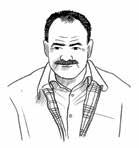
GIVE REWARDS AND SETTLE YOUR CONFLICTS
And it too is a firm believer in the rewards system, believing that it promotes “originality and innovation. Research has shown that many people who leave a company to develop their business ideas do so because their attempts to do it within the company have been frustrated and not because their financial reward is insufficient. Their main incentive is achievement rather than money.”
KEEP IT POSITIVE
As well as maintaining a happy, and thus productive, working environment, companies large and small want conflict settled as quickly as possible to avoid litigation that can send costs spiralling into the stratosphere. Sven Voege, an employment specialist in Berlin, Germany, said, “The thought of legal action because of a spat at work terrifies bosses. Therefore it is in their interests – and the interests of individuals because of both the costs and the stress involved – to have conflict resolution before it gets anywhere near a tribunal or a courtroom.
“In Germany there is a shamful, almost institutionalized, bullying that goes on in many workplaces. By some estimates this costs companies in the region of five hundred to a billion euros a year to settle. This is an awful lot of money that would be better spent improving workplace efficiencies and paypackets.
I advise companies, above all, to cre-
ate a positive atmosphere at work, one where employees are treated fairly and not with disdain, where there is no sarcasm or Chinese whispers about performance. Some people will always have to be eliminated: I simply advise that they should therefore be stabbed in the front, not in the back.”
He offers a five-step guide to workplace positivism to head off conflict:

1. Promote communication. Good communication is the cornerstone of an effective working environment. Promoting two-way communication between peers and across hierarchical lines, establishing a strong network of communication, and having an open-door policy automatically make working much
KEYWORDS
easier and more effective for everyone. Make sure all contributions are valued.
2. Empower employees. By giving as much freedom to employees as possible you empower them to work how they want to. People like a certain amount of freedom, and work is certainly no exception. All studies show this nurtures a positive, problem-free environment.
3. Reward them. See above.
4. Create a team spirit. And nurture it. Statistics show that people are at their most efficient when they work in teams – a phenomenon called synergy, which states that the combined output of a team is more than the output of each individual added together. When people work in teams, they see themselves as a group that works towards
the attainment of a common goal, rather than individuals competing against one other.
5. Provide a positive physical working environment. Light, space, ambient temperature, air quality, noise levels, the quality of the furniture – these are all real, physical things that go toward creating a happy workplace. Employers, he said, ignore these at their peril. The Smart Business Trends website, which chronicles workplace trends, concurs, adding, “It is also essential to know that organizational culture – and indeed working environment –‘comes from the top.’ An entrepreneur’s big responsibility is to create, develop and nurture the right kind of working environment for everyone to function in the organization.”•
26 Work Style — #14.14 Work Style — #14.14 27
Best
Practices in HR Management Coaching
Illustration by Natalie Andrewson Charlotte, USA
➜
➜
➜
➜
➜
Happiness
Positive Environment
Problem Resolution Policies
Team Spirit
Communication
[W
itseducation.asia smartbusinesstrends.com workplace911.org]
By MARC RUYSSCHAERT
It’s All About Behaviors
It is important that companies, whether big, medium or small, understand that behavior has a deep influence on engagement. Behavior is the expression of personality, values, attitudes and interests, among other factors.
The way people behave can tell you what they will need to remain engaged. It is of fundamental importance for a company that employees are always engaged enough or things can go wrong. When employees are engaged, sickness, absenteeism, customer complaints and employee turnover will decrease, and the positive effect will be that productivity, profit and added value will increase. When employees are actively disengaged it is the other way around. They can be seen as apples and companies as baskets. When you pick a new apple you have to make sure it is a good one as a rotten apple, even if only slightly, will ultimately rot all the others.
BEHAVIOR AND SKILLS
Assessments are important when recruiting, even if at the end of the day the most important thing remains the individual’s technical competences and skills for that specific job.
The Life Orientation (LIFO) method is a great tool for not only gaining knowledge about preferred behaviors but also making people aware of who they are, how they behave in interactions with others and how they influence the behavior of others. The LIFO methodology is used to recognize behavior and is divided into three sessions. During the first session, the candidates complete a 20-30 minute online questionnaire about their preferred behavior in certain situations. They’ll be asked about normal situations and also stressful
situations because often our reactions will differ in each. The second session consists of a 60-90 minute coaching interview with reports from the first session to hand to verify that the answers match. In 85 percent of cases they do match and people really recognize themselves in the answers; only the 15 percent remain skeptical. This methodology can be used not only as a recruitment tool but as a team-building tool as well. The third session usually consists of classroom training with the team to learn more about how behavior can influence others and to understand their reactions to that behavior.
This methodology is used successfully by Ricoh, a Japanese global provider of technology and services that transform business-critical document processes, with offices in 200 locations and more than 107,000 employees worldwide. Ricoh decided to incorporate this method in its leadership, sales and teambuilding programs. Ricoh even shares this program and knowledge with its customers, thanks to Ricoh Learning Services Europe.
A BUNCH OF METHODOLOGIES
LIFO aside, there is a variety of other assessment methods available on the market, such as MBTI, SHL and PAPI (cubiks), but the problem with these is that in the end their validity is low, meaning they aren’t helpful in providing a 100 percent perfect match from a behavior point of view.
Another very powerful method is creating an excellence profile. You measure with your selected tool the characteristics of the three best and three worst performers in a certain job role, and you compare the candidates for that role on the scale that you have thus es-
tablished for all of the characteristics in your tool.
Behaviors that you aim for vary depending on the type of job available, but generally if you are, for example, hiring someone to work in a company’s finance department, you’ll probably make the right hire if you bring in someone who is meticulous, precise and gets a bit angry and frustrated if the numbers aren’t right but will go all the way until those numbers match. On the other hand, if you’re hiring someone in the sales and marketing department, you’ll want to look for someone who is perhaps not so meticulous but is able to look at the bigger picture and likes to move on things quickly. These are things that you can see better during interviews because when candidates take the first test online they’re in front of a computer, in a room, by themselves, and are not in a stressful situation. For example, if they are applying for a sales or marketing job and can’t present themselves in an interview then they are probably not a very good candidate for that position but might be the perfect candidate for a position in the finance department.

Therefore it is very important that companies always match online tests results with the outcomes of face-to-face interviews; the two results must be somewhat similar – if they aren’t, there is something wrong.
The STAR (Situation, Task, Action, Result) format is a job interview technique used by interviewers to gather all the relevant information about a specific capability, competence or skill that the job requires. During this assessment the interviewer will put people in a certain situation or refer to a real situation in
the past and ask for their specific role, actions and results, then from the answers the interviewer assesses whether that reaction is acceptable or not in the future job role.
Ultimately, companies must recognize that some behaviors are an allergy to other behaviors; this is why it is of crucial importance that companies are able to put together acceptable behaviors –to avoid possible problems.
HIRING SUCCESS AND UNSUCCESS
In the life of every recruiter there are successful and unsuccessful hires, although the final hiring decision is always made in the end by management.
One time, I remember that I had left a director with three candidates. They had very similar skill sets but different behavior patterns and personalities. Therefore I suggested he should be careful when hiring, but we often,
as humans, pick those who have very similar personality and behavior types to ourselves (and that is the most dangerous thing possible), so he went for the one who was good but who had to be treated carefully as his personality was too similar to the director’s. Well, six months later the director came to me saying, “Marc, you were right! I don’t know what to do. I can’t manage that person and I’m feeling that he is the one managing me!” As recruiters, we see things during the process and we try to advise as best as we can. In the end, the person left the company, and that’s how it normally goes. If it’s a bad hire either the person will realize and see they’re not a good fit or the company will lay them off.
A bad hire is not a huge problem if that person stays for a short time, but if they somehow end up staying for a long time the company will have a big problem.
The primary risk is that the individual who was wrongly hired will start to become disengaged, and if you’re unlucky they will disengage others as they’ll be complaining all the time. The secondary risk is that they will stop responding to management as they are supposed to, and that insubordination will raise some issues. The third risk is losing customers who have to deal with the disengaged employee. The fourth risk is the low level of productivity that this person will show. Finally, hiring badly has a huge cost implication – think of the recruitment costs, the training costs, and then having to do it all again within a short period of time.
Recruitment is not just about getting someone on board but is about finding the right person who will want to stay on board. This is why companies must always do follow-ups after 6 and 18 months to ensure that the person is still a match.•
28 Work Style — #14.14 Work Style — #14.14 29
Best Practices
HR
in
Management Training
Personality is only important when it influences certain “professional” behaviors. For a company it is more important to understand and measure how a person will behave in a particular situation than what their personality traits are.
[W ceb.shl.com mbticomplete.com papi3.com ricoh.com]
KEYWORDS
Illustration by Nico189 Milan, Italy
➜ Behavior ➜ Assessment ➜ Bad Hire ➜ Match ➜ Good Apples
KEYWORDS
By SILVA ANNOVAZZI
Assessing the Risk of Corruption
Corruption is a distress undermining democracy. It damages social justice and the rule of law. Corruption is closely intertwined with the exercise of power, whether public or private. Whoever has power is generally more likely to abuse it.
SYSTEMIC CORRUPTION CAN HAVE GREATER COSTS
The harm of corruption is everywhere: the latest EU anti-corruption report from the Commission to the Council and European Parliament confirms that, at a European level, three-quarters of respondents (76%) think that corruption is widespread in their own country. The countries where respondents are most likely to think corruption is pervasive are Greece (99%), Italy (97%), Lithuania, Spain and the Czech Republic (95% in each). Also, according to this research, a quarter of Europeans (26%) consider that they are personally affected by corruption in their daily lives. Around one in twelve (8%) says they have experienced or witnessed a case of corruption in the past twelve months. Bribery and corruption cost the European economy an estimated 120 billion euros per year.
On the political front, corruption is a major obstacle to democracy. Offices and institutions lose their legitimacy when they are misused for private advantage. This is harmful in established democracies but even more so in newly emerging ones. In some countries, corruption occurs primarily through campaign contributions that oblige politicians to repay major donors with favors.
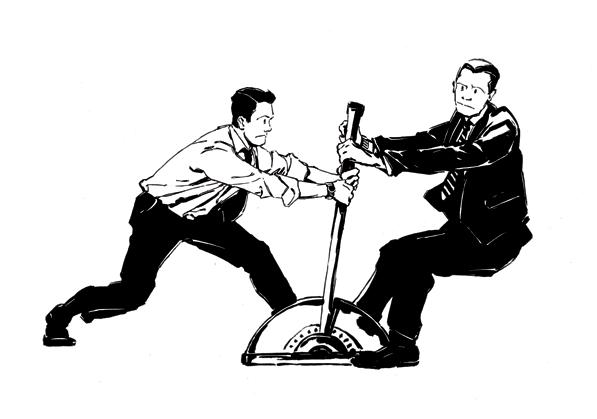
On the economic front, corruption depletes national wealth. Corrupt politicians invest scarce public resources in projects that will line their pockets rather than benefit communities, and prioritize high-profile projects such as dams, power plants, pipelines and refineries over less spectacular but more urgent infrastructure projects such as schools, hospitals and roads. An example can be found in what recently happened in India: a few days after an underconstruction bridge collapsed in
Bihar’s Muzaffarpur district, former Deputy Chief Minister Sushil Kumar Modi referred to the incident not as “an isolated incident, but as a breach of people’s faith in the regime, which is steeped ‘neck deep’ in corruption.”
Corruption also hinders the development of fair market structures and distorts competition, which in turn deters investment. Very recently, the Italian energy giant ENI was investigated on suspicion of possible international corruption.
In 2011, ENI paid the Nigerian government US$1.092 billion to secure joint ownership of the oil block along with Shell. Prosecutors now claim the entire amount was in fact a mega bribe because ENI executives knew that US$800 million of that money was passed on to Malabu Oil and Gas, a company believed to be owned by a former Nigerian oil minister who was convicted of money-laundering in France in 2007.
BUT WE HAVE GOOD NEWS
Anti-corruption laws have been enacted over the past decades to prevent the growing phenomenon of corruption.
The US started many years ago: the Foreign Corrupt Practices Act (FCPA) is a federal law, known primarily for its two main provisions, which address accounting transparency requirements under the Securities Exchange Act of 1934 and bribery of foreign officials.

To be in line with the legal instruments of international organizations (the ONU Convention, the OECD and the Council of Europe), the UK adopted the Bribery Act 2010 (BA). Extraterritoriality is one of the most important aspects of the BA, which applies not only to UK companies but also to foreign companies that carry out part of their business in the UK regardless of where the company is incorporated. Italy is one of the last countries to adopt a new anti-corruption law, whose main feature is its applicability to both the public and the private sectors.
Due Diligence
ANTI-CORRUPTION DUE DILIGENCE
A common trait in anti-corruption laws is that they are mainly preventive and, among other things, they suggest the adoption of a prudent approach toward business investments. They strongly recommend due diligence activities to assess whether a specific analysis of corruption risks has been performed and whether a specific anti-corruption compliance program has been implemented. Indeed, all investors who are interested in opportunities in countries associated with a high risk of corruption now have anti-corruption due diligence on their agenda.
Anti-corruption due diligence involves identification of any potentially illegal conduct linked to violation of the relevant legislation. Moreover, it addresses the evaluation of the risk of corruption inside and outside the company and the appraisal of the effectiveness of anti-corruption compliance programs and internal controls in place. In other words, investors evaluate compliance programs and their level of perceived corruption as a result of the business environment and the company’s business model.
In addition, a key turning point for a complete assessment is the existence of an internal officer (or a team) who performs the task of preventing and controlling the risk of corruption, gathering information flows from finance, accounting, legal and internal audit departments. The result is that, more than ever, it is now essential for companies wanting to increase their market attractiveness and their value to implement internal control measures to prevent the risk of corruption. On the other hand, looking at the picture from the investors’ side, wise and conscious investments cannot disregard a preliminary business decision grounded in the evaluation of the outcome of anti-corruption due diligence.•
THE SURVEY
Almost three times as many expats in EAGLEs such as Brazil, Turkey, India, China, Mexico and Taiwan say they were sent by their company, highlighting a trend for corporations to take advantage of these growth hotspots by relocating their employees abroad.
• Asia is home to the highest earning expats, who are almost three times more likely to earn over $250,000 p.a. than their counterparts in Europe (14% compared with 5% in Europe).
Within Asia itself, the survey found that China is the preferred choice for these high-flying expatriates, with four times as many expats in China (29%) earning over the $250,000 p.a. mark compared with the global average (7%).
• Rental rates and volatile house prices are a big concern among expats based in the Middle East - 44% of expats there say fluctuations in rental prices pose a risk to their financial wellbeing and over a fifth (22%) say changes in house prices pose the greatest threat to their financial health.
• Almost a third of expats (31%) who took part in the survey say that they moved abroad because they wanted to have a new challenge. This reason is as common a driver of expatriation as "improving quality of life" and "moving to be with a partner or family," and is only topped by "better job prospects" (38%). The region that most attracts these challenge-seeking expats is Asia, with over two-fifths (44%) of respondents living there citing this as a key driver. Two-thirds (66%) of expats in Japan and just over half in Taiwan (52%) and Vietnam (52%), followed by Malaysia, Thailand and China, say this is one of the main reasons they moved.
• Canada takes the crown as the top expat retiree spot, with three times more expat retirees than the global average (31% compared
with 11% globally), followed by New Zealand (28%) and the United States (26%).
• New Zealand ranks first in both the Expat Experience and Raising Children Abroad league tables, with parents noticing the improved health, wellbeing and safety of their children, as well as believing they are bringing up more confident and well-rounded individuals.
• Canada and the United States offer expats an easy setup and great quality of life, certainly helped by the familiarity with the language. Roughly three-quarters of expats in both countries (73% in the United States and 76% in Canada) comment on the ease with which they integrated into the local community, weighing in above the global average of 65%.
• Japan is a safe place to raise a family abroad. Japan’s crime rate has always been relatively low, but this year official figures show that it has dropped even lower. Official Organization for Economic Cooperation and Development (OECD) figures ranked Japan as the safest country in the world in terms of crime. The organization attributed an ageing population, better safety technology and less use of cash as the reasons for lower crime rates.
• Expats rate Taiwan’s healthcare system as one of the best in the world in terms of affordability and quality. Nearly three times as many expats say they spend less on healthcare than they used to (67% compared with the global average of 27%) and almost two-thirds (64%) say they enjoy the higher quality of healthcare available in Taiwan.
To see how your country compares in this year’s Expat Explorer survey, visit the interactive tool: [W expatexplorer.hsbc.com]
Contents reproduced with permission from the Expat Explorer Report, published in 2014 by HSBC Expat.
30 Work Style — #14.14 Work Style — #14.14 31
Best
Practices in HR Management Compliance
[W eni.com hub.coe.int justice.gov oecd.org un.org] Illustration by Doug Cowan, New York, USA
➜
➜
➜
➜
➜
Harm
Transparency
Assessment
Laws
By PINA DRASKOVICH
Database: A New Profitable Resource
Database marketing emerged in the 1980s as a new, improved form of direct marketing. Then, with new technologies enabling customer responses to be recorded, direct-response marketing was in the ascendancy, with the aim of opening up a two-way communication, or dialogue, with customers.
The database sector functions differently from country to country. In France, for example, the sector has three main players. Some work with generic databases, while others prefer to specialize and work with sectorial ones. In order to improve and differentiate their services, these companies need to enter into partnerships with external companies that will render their services more complete. “Companies such as Comscore, which analyzes online behavior, and Kantar Media, which provides data on investment in advertising and press releases to find out where the name of a brand or a company was used, for example, are the companies we work with,” says Matthieu De Montgolfier, country manager of TBS Italy.
Italy has many generalist services that provide databases, “So we felt compelled to create the market for specialized marketing and communications databases, as it did not exist,” explains De Montgolfier.
In Germany the sector is monopolized by a few huge multi-specialized providers. “These companies have established themselves in the market in the past few years and operate in a rather opaque way, especially in terms of data acquisition and updates,” explains Alexandre Arslan, country manager of TBS Germany. “As for the area of operation of TBS’ FCA (File of Communication Actors), in Germany we have only one competitor offering a database of contacts, companies and brands, primarily through paper directories and more recently through an online directory,” concludes Arslan. As Alejandro Zbarsky, country manager of TBS Spain, admits, there is no real competition in Spain in the field of advertising. He explains, “The existing databases are general and not up-
dated by a team of professionals, and also the databases of media outlets and agencies are rarely kept up to date.”
CREATING A QUALITY DATABASE

In order for a database to be of good quality it must be as complete and up to date as possible, and this is a very difficult goal to achieve per se.
“To create a quality database we employ quality people, do a thorough daily analysis of the different sources of information, and stipulate partnerships with existing companies in the market,” explains De Montgolfier. “The analysis
is carried out by telephone. Companies and agencies are called to either confirm the data that’s already in our possession or to update it in case something new came up,” he states. Another important feature of a quality database is that it should not only include full names but also explain their work, so that in the end the communication you wish to send will sound much more appealing as it can be better customized. Zbarsky agrees as he exclaims, “The only way I know is our model: invest in a pool of qualified archivists who update the database daily.”
Illustration by Brian Taylor, Stafford, USA
“
KEYWORDS
Big Data
Privacy Laws
HERE COME THE DIFFICULTIES
A good-quality database of 5,000 companies requires a good team and many hours of work, and in Italy it can cost up to 175,000 euros per year,” asserts De Montgolfier. Certainly with fast-paced lives, increased job mobility and the advent of technologies, one big problem companies in the industry have to face is that the type of information they offer is not static but dynamic – people change roles, addresses, phone numbers and companies, so the ultimate task for these companies is mainly to make sure the information is always up to date as well as continuing to find additional details to help customers in their search for information. In Germany, creating a database is very difficult as only the public data of an individual can be registered and sold. Updates can only legally be done by mail or phone by contacting the company directly. “Other solutions like e-mail or direct phone contact are not legal,” explains Arslan. “A company like ours needs a team of seasoned multi-specialist filing clerks, ready to endure the high number of ‘nos’,” claims Arslan, adding, “In order for a contact to be recorded in a database like ours, with personal data, it is necessary that the subject has previously agreed to the storage, use, maintenance and resale of the information; this is why it is very difficult for a new database to access updated information with such legislation.”
WHAT ABOUT PRIVACY?
Privacy laws are the same throughout Europe, except for France and the United Kingdom where, in business-to-business, there is no need for people to authorize the publication of their e-mail address.
De Montgolfier says, “In Italy, only around 10 percent of the people that we contact don’t want to be part of our database, and in that case we tag their information with the code OPT OUT so that our clients know that the missing info is not our responsibility.” In addition to the need for authorization, there is another significant detail – by law, even if a person has given consent for
By DIEGO FULCO
WORD TO THE ExPERT E-MAIL MARKETING AND PRIVACY
The Privacy Policy Framework in Europe
In EU countries, e-mail marketing is expected to respect the privacy restrictions established by the 2002/58/CE European directive – recipients must give their prior consent (exceptions aside) and have the opportunity to unsubscribe.
The most relevant exception to the prior consent rule refers to e-mail marketing to customers, both business-to-business (B2B) and business-to-customer (B2C), in particular when it relates to products and services similar to ones already bought by that customer.
The European directive and individual European states’ laws allow e-mail marketing without prior consent when messages contain information about products or services similar to those already bought by that customer. Neverthless, these messages should be introduced by a clear and complete privacy note and give the customer the opportunity to unsubscribe at any time. As for B2C e-mail marketing, European countries’ laws agree in asking for prior consent. However, for B2B e-mail marketing, some countries such as Italy apply the same rules as for B2C e-mail marketing –they require prior consent even
their e-mail address to be entered into the database, the company who bought it cannot contact them directly. “If our customer wants to start an e-mail marketing campaign they will have to do it through us.” In Germany, legislation is strict and must be respected at all time, Arslan confesses. “We respect the privacy guidelines to the letter and do not record or resell data that has not been subjected to an acceptance form,” and he adds, “This is why those who want to can directly register their personal data in the database.”•
if the recipient is a company or a professional. This isn’t the case in other countries, such as the UK, which permit e-mail marketing without consent if addressed to professional or corporate accounts as long as: a) the communication is pertinent to the recipient’s business; b) the identity of the recipient is clear; c) the recipient is informed of the commercial purpose of the e-mail; and d) the recipient has the opportunity to unsubscribe from further messages. As for privacy policy, it is applied according to the law of the country where the company using the data is headquartered, rather than the location of the recipient. A company based in Milan that wants to use e-mail marketing must respect Italian rules even when the recipients of the e-mail marketing are citizens of other European countries. To identify who must inform and obtain consent, one should look at the buyer (that is to say, the brand with commercial aims) and not at the service (that is to say, the company supplying the marketing services). However, as many companies find it difficult to maintain their own database of names of those who have consented to receive marketing e-mails, they often outsource this to specialist companies. These companies are responsible for sending e-mails for their customers through a service communication that hosts advertising space for their customer brands.

In this way, the company that wants to use e-mail marketing doesn’t buy or rent e-mail addresses from the supplier, but advertising space in the supplier’s communication (newsletter or DEM ). So the company has no need of specific consent from the recipients but just needs guarantees about privacy from the supplier included in the contract.
It’s important to pay attention to the choice of supplier, reading their terms, conditions and guarantees carefully, as all across Europe there are high fines for spamming.
32 Work Style — #14.14 Work Style — #14.14 33
Best Practices in HR Management Legal
[W tbsgroup.it]
➜
➜
➜
➜
➜
Partnership
B2B
Consent
Best Practices in HR Management Performance
By PALLE ELLEMANN KNUDSEN
Avoiding the Pitfalls of Performance Evaluation

Many companies have implemented some kind of performance evaluation system. Traditionally, the main reason for using such systems was to determine the size of bonuses, but performance evaluation is increasingly used as a management tool and a development tool for the individual employee.
CHOOSING THE METRICS
Companies implementing performance evaluation for bonus allocation discovered that it actually had an impact on employees’ focus on work. Most energy and focus would be directed where the money was. This should not necessarily be a huge surprise, but it leads to one important overall learning point: be careful what you measure, as you might get it! Choosing performance metrics for evaluation is the key to a successful system because it will guide people’s energy and focus. When you choose some metrics, you also decide not to include others. These may not be as important as the ones you do include in the performance evaluation, but they may still be things that need to be done in everyday work. Performance evaluation is one of those challenges in which the complexity just continues to grow the more you dive into it. The more detailed and customized you make the evaluation for each employee, the more management control you lose across the organization and the more the possibility to consolidate data for company-wide analysis is reduced. When everyone has individual performance metrics, it is difficult to benchmark employees, and top managers have difficulties steering the focus of employees from the management level. The value of a performance evaluation system also depends on the level of trust in the organization and to what extent people provide honest feedback. Performance evaluation systems will often collect feedback from co-workers, direct reports and managers, and this should not end up as either a back-slapping or a back-stabbing exercise.
GETTING THE RIGHT PICTURE IS DIFFICULT
Performance reviews are often criticized for “sugar coating” – that people (in particular co-workers) paint an overly positive picture of performance. People may do so in order to avoid conflict or with the strategic rationale that “If I provide positive feedback on my co-workers, they may give me positive feedback too and we will all look good in front of management.” A recent survey by Globoforce and the Society for Human Resource Management showed that 45 percent of HR leaders don’t think annual performance reviews are an accurate appraisal of employees’ work, and 42

percent don’t think employees are rewarded fairly for their job performance. This is obviously a significant challenge, when close to half the HR leaders, who are responsible for these performance evaluation processes, do not think they are a good tool. Take into account as well that it can be a massive investment of time and energy when 8 to 12 people in an organization are asked to evaluate a single person. In an organization with 500 people, this is an investment of more than 1,600 hours if an average of ten people spend 20 minutes for each person. This is just taking into account the time spent on filling out the feedback surveys and not all
MUSIC IS BACK IN CHAMBER
Milano Haus Musik is an association presenting small instrumental and vocal ensembles, with or without piano, who perform in the coziness of private homes. Groups of friends and strangers are lost in listening, united by the pleasure, passion and curiosity for music. This intimate setting allows participants to be in touch with musicians, listening to their instruments’ sounds as well as their voices, who describe the musical path for the evening, narrating and explaining the features of the selected songs.
To sign up or for further information write to
[E milanohausmusik@gmail.com]

01 Violinist.
02 Violinist and pianist.

Photos by Valeria Squillante
the other time spent on giving instructions and providing feedback and the energy devoted to speculating about the results. In low-trust organizations, the latter can be significant and a performance review process can add to the gossiping and back-stabbing taking place. That does not mean that performance review cannot be valuable for low-trust organizations; on the contrary, it may be a fresh new way of engaging with employees and giving them direction if management understands how to carry out the process in a constructive way. But in these cases it is important to be cautious with the data quality, in particular in the beginning, when people in low-trust organizations tend to respond more tactically than honestly. If the performance evaluation process turns out to be trust-building, data quality should improve over time as people provide more honest feedback. Performance evaluation can go from a simple quantitative metric that may be applied for large groups in the organization to more customized metrics with significant qualitative input. The quantitative metrics are often easy and cheap to collect but are sometimes considered inaccurate and somewhat “half the story” about performance. On the other hand, customized metrics based on qualitative input, such as peer assessments, are much more cumbersome to develop and manage and the subjectivity of the data can be questioned.
Maxim Sytch and D. Scott DeRue, in the article “Ditch Performance Reviews? How About Learn to do Them Well?”, offer three tips to improve the value of performance reviews:
• Reduce subjectivity by incorporating several viewpoints from peers, direct reports and senior managers.
• Give constant feedback so it does not come as a big surprise.
• Separate evaluation and development so a heated discussion or reaction to feedback does not impact negatively on a more forward-looking development discussion.
The second recommendation, which relates to the frequency of feedback, is essential for the outcome of the performance evaluation process and how it
fits within the culture of the organization. Developing a culture in which it is normal and widely accepted to give and receive honest feedback is important in order to have real conversations about performance and how the development of each individual in the organization can support the goals of the company. Honest and constructive feedback requires, though, good management and communication skills and a culture in which it is acceptable to make mistakes. This can be developed through training and by removing punishment for making mistakes, instead seeing them as opportunities for improvement.
DIMENSIONS OF PERFORMANCE
Manuel London and Edward Mone describe in their book chapter “Performance Management: Processes that reflect and shape organizational culture and climate” how performance management processes, including performance evaluations, have different dimensions for the individual employee, the team and the organization. Management needs to consider all three dimensions when designing a performance evaluation system. The researchers stress that it is important to under-
stand performance within the cultural context of the organization and to be aware how performance management impacts the organizational climate. Too much focus on individual performance can have a negative impact on the employee’s energy and focus on the team and how that fits with the culture and goals of the organization. Given the complexity of performance evaluation, it is essential that companies keep in mind what the goal of the whole exercise is. If there is an element of bonus allocation based on the evaluation, it will put a strong focus on fairness –exactly what is measured and how. If it is mainly a development tool to support and build conversations on individual performance, it may allow for more customized measures that should, however, be linked to the culture and goals of the team and the organization. Independent of the goal, performance evaluation is difficult to get right and must be understood and managed as an integrated part of the culture – it may be a trust builder or a trust breaker. There is no neutral ground.•
34 Work Style — #14.14 Work Style — #14.14 35
[W globoforce.com scottderue.com shrm.org]
Illustration by xavi Ramiro, Barcelona, Spain
➜
➜
KEYWORDS ➜ Metrics
Evaluation ➜ Sugar Coating ➜ Feedback Frequency
Communication
By NIGEL PHILLIPS
Creating Employee Motivation
KEYWORDS ➜ Fika ➜ Socialization ➜ Value ➜ Belonging ➜ Synchronization
Yes, some work for the love of it, others for personal fulfillment, and some like accomplishing goals that make them feel they are contributing to something greater, something of importance, a personal mission that can be achieved through meaningful work.
REMUNERATION IS THE CORNERSTONE
What does this all mean for an employer who wants to instill a sense of pride, a strong feeling of motivation in a short period of time? Your company has a brand, a mission, and you need to instill a love of this as soon as possible. Others truly love what they do or the clients they serve. Some like the camaraderie and interaction with customers and coworkers. Other people like to fill their time with activity. Some workers like change, challenge and diverse problems to solve. Motivation is individual and diverse. Money pays the bills and so pretty much everyone works to attain it, through salary, bonuses, benefits, remuneration – whatever. It would be wrong to underplay the importance of money as motivation for people who work. So, decent remuneration must be the cornerstone of a successful company that wants to recruit and retain committed workers; companies must provide a living wage and then work on additional motivation issues.
MOTIVATION BESIDES MONEY
Studies by the American Psychological Association, dating from the 80s, show people want more from work than money. While managers predicted the most important motivational aspect of work would be money, these reports said personal time and attention from the supervisor were the most important
facets. In a recent Workforce article, reward and recognition guru Bob Nelson says, “More than anything else, employees want to be valued for a job well done by those they hold in high esteem.” He adds that people want to be treated as if they are adult human beings.
Basically, people want things that are quite straightforward and these include:
• Control of work: the ability to influence decisions; clear and measurable goals; clear responsibility for a complete, or at least defined, task; job enrichment; and recognition for a job well done.
• To belong to the in-crowd: this includes things such as receiving timely information and communication; understanding management’s rationale for decision-making; team and meeting participation opportunities; and visual documentation and posting of work progress and achievements.
• The opportunity for growth and development: this includes education and training; career paths; team participation; succession planning; cross-training; and field trips to successful workplaces.
• Leadership: people want clear expectations that provide a picture of the outcomes desired, with goal setting and feedback and an appropriate structure or framework.
CHOP-CHOP! LET’S PROMOTE MOTIVATION
In order to promote motivation quickly and surely among new employees, it is worth looking at best practices from other cultures. I recently came across a headline that read: “In Sweden, the more people holidayed at the same time, the greater the rate at which anti-
depressant prescriptions decreased.”
Spend a day or more in a Swedish office and you’ll probably experience the startling phenomenon of the “fika,” the moment when everybody – senior or junior, female or male – gathers for coffee and cake. Hierarchies are set aside, and people discuss work and non-work matters alike. The ritual isn’t compulsory, but it isn’t exactly optional either: take your coffee break at a different time and eyebrows may be raised above designer spectacles. Not that “coffee break” is a translation most Swedes would accept: apparently, fika means much more.
“The only thing a Swede likes more than having a fika,” writes Stockholm-based journalist Oliver Gee, “is talking about the word fika and how you’ll never find it in English.”
ExTENSIONS OF FIKA
The idea of fika can be extended. A team led by Terry Hartig, a health researcher at Uppsala University, found that when Swedes take time off, antidepressant prescriptions go down. Hardly surprising… but the interesting part involved the timing of those vacations: the more people holidayed at the same time, the greater the rate at which prescriptions decreased. Synchronized time off – or what Hartig calls “collective restoration,” of which the fika is a small, daily example – made the whole country happier. It even influenced retirees, despite their not having jobs.
It’s not hard to guess why collective restoration is so powerful: it’s easier to nurture relationships with family and friends when they’re on leave, too; meanwhile, if the office is deserted while you’re trying to relax, you’re spared anxious thoughts about tasks piling up, inboxes filling, or scheming colleagues trying to

steal your job. Still, the implications of the Uppsala findings are controversial. They suggest that to maximize happiness, we need what Hartig refers to as “social regulation of time”: strong traditions or laws about working hours and holidays to make it more likely we’ll all do the same thing at once.
THE NEED TO GO SOCIAL
Few notions could be more antithetical to what most of us, these days, take to be the most satisfying way to work.
The ideal modern job is one where you set a schedule that fits with your family life, taking holidays and certainly coffee breaks when you choose, perhaps
even criss-crossing the globe with your laptop as a “location-independent professional.” Any attempt to strengthen communal boundaries, like that French effort to limit out-of-hours e-mail for some workers, is derided. Yet collective restoration, like other beneficial social rituals, may require sacrificing some of that freedom. As Judith Shulevitz makes clear in her book The Sabbath World, the idea of a sabbath has persisted not just because a day off is good but because it’s the same day off for everyone. Freelancers love being able to start and finish earlier, skip the rush hour, then go shopping when the supermarkets are empty. But Hartig’s work is a reminder that this comes with a cost.
Community depends on synchronicity. And this is why it’s hard not to envy fika-goers: in surrendering total coffeebreak self-determination, the Swedes have gained something much more valuable. Even if you can never quite get them to tell you, in English, what that is.
Giles Ward-Best is CEO of Solar Energies UK, a Bournemouth-based company that employs 70 staff and has an annual turnover of £2 million. Ward-Best says, “There are two things that motivate people: money and kudos. People like it when their sales look good compared to others, it makes them feel important.” When it comes to retaining and stimulating staff, he says he offers incentives such as a recent trip to Butlins in Minehead for an “adult-themed weekend.” “We have also been go-karting and we’ve been on a trip in a speedboat, followed by a comedy club and a hotel; we try to do something every two months. Also I believe quite strongly that taking everyone to the pub on a Friday evening helps team-building a lot,” states Giles. So there you have it then – to create affinity to your company brand, in a short period of time, take everyone down the pub.•
36 Work Style — #14.14 Work Style — #14.14 37
Best Practices
HR
Pride
in
Management Attachment and
[W apa.org drbobnelson.com
uu.se]
We all have different motivations for working, but essentially we all work to obtain something we need. That something impacts on our morale and motivation and quality of life. Of course it is about the money.
olivergee.net solar-energy.co.uk
Illustration by Alex Mathers London, UK
By LUCA BRUNONI
#Whereismyflight?
Few brands can boast 100 percent client satisfaction, and airlines are certainly not among those rare few.
When complaints gravitate around the usual weak spots – disappointing customer service and lack of regard for passengers – the line between imperfection and bad reputation narrows.
FLIGHTS & TRIBULATIONS
Today, disgruntled travelers are stepping up their game; not only do they strike back on social networks such as Facebook and Twitter but they are also using a new weapon: creativity.
UNITED BREAKS GUITARS
An engaging “social” complaint about a real airline deficiency can hit hard. When musician Dave Carroll posted a YouTube music video titled “United (Airlines) Breaks Guitars” (his guitar was mishandled during a flight and customer service responded poorly to his claim), it instantly became an anthem for every traveler who ever had a luggage complaint go unheard: today, the video has almost 15 million views.
Unsurprisingly, as Carroll explains, United “Were unprepared to handle a social media wildfire. (They) have been criticized by customer service and social media experts around the world for both what they did and did not do properly. While the conversations were taking place online, United typically responded with traditional media releases.” Airline travel and customer complaints go hand in hand, especially since the boom of low-cost flying. In 2014, a lengthy rant aimed at Ryanair appeared on James Lockley’s Facebook page; the post, infused with humor and satire, has been shared thousands of times on Facebook and Twitter and landed on the pages of major newspapers worldwide. Needless to say, it didn’t do wonders for Ryanair’s reputation, as the company has already been under fire for its “no apologies” approach to budget flying.
SIx-MINUTE RELIEF
Carroll and Lockley decided to wage war only after their initial complaints had been unsatisfactorily addressed. Keith Pape, a


traveler who was “turned down for standby” while attempting to catch an earlier flight from Texas to LA, might have been tempted to do the same, but his tweet to the airline customer service @AmericanAir – “Just told my ticket doesn’t allow me to sign up standby for earlier flight. That is stupid” – was answered within six minutes and a solution for his problem was rapidly found. Stephanie Scott, a social media specialist at American Airlines, explains, “Our social customer service team monitors our social communities 24 hours a day, 7 days a week, for incoming mentions. When we see a complaint, our goal is to respond within 10 minutes and be empathetic in asking for details.”
CUSTOMER SERVICE 2.0
Airline customer service is tricky because passengers are often in stressful situations and emotions run high. Twitter allows them to express their frustration in a public forum but still puts them in direct contact with the customer service team.
“It allows travelers in transit to get in touch with their airline in a much easier way,” says Raymond Kollau, founder of Airline-
trends.com, “and provides customers with a magnified voice that can have a huge impact on an airline’s reputation.” Airlines also appreciate Twitter’s efficiency: messages tend to get straight to the point, removing the added stress of a conversation at the customer service counter, where many other people are usually standing in line, tapping their feet. “The airlines are using social media like they are using the phone, for one-to-one issue resolution,” said Ragy Thomas, chief executive of Sprinklr, a social media technology provider. “It’s unrivaled in its efficiency.”
GIVE IT A TRY
Next time you’re at an airport and something goes wrong, don’t rush to the other corner of the terminal to join the hell-onearth customer service line. And before you go home upset and decide to record a YouTube video damning the company for all its faults, keep in mind that an alternative lies right in your pocket. As more than 200 airlines now use social networks, the solution to your dilemma might just be one little tweet away.•
Best Practices in HR Management Culture Integration
 By ALEX DI MARTINO
By ALEX DI MARTINO
The Legacy of the Heart
Creativity
For every job we do, paid or unpaid, we connect to the project we are dealing with – with the tasks and people involved in it – in a very special way. I personally think that it is a connection that involves our “heart” because of the many emotional variables included in any job. For this reason, I wanted to know what happened to the volunteers of the London Olympics held in 2012 – those thousands of “hearts” who shared their time and skills with so many other individuals, providing enthusiastic support to the Olympic activities.
In Autumn 2012, in issue 10 of this magazine, I wrote about the London Olympics volunteers and their incredible adventure. Two years later, I spoke again to a couple of them to find out what kind of legacy
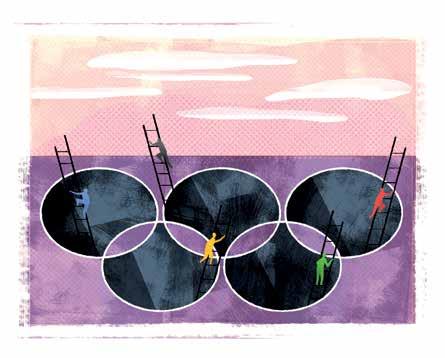
they actually experienced after the event. “It is mostly a matter of the heart for me,” says Shelley Walters from Duluth, MN, USA, now 22, on her way to graduate in veterinary science. “As I said at the time, I love the idea of ‘offering’ something for free. It is something that makes me feel free, untied. Free to give, without expecting anything back. And this is an act of love. And life always gives you something back, in different ways,” continues Shelley. “I haven't been offered a paid job directly from LOGOC [the London Olympic organizer], no, not at all. But I got so much from that experience in terms of enthusiasm, confidence, exposure and so on, that I felt my life literally catapulted forward as I came back home.”
“Sport was never important in my life, something I didn’t pay attention to particularly,” says Nikki Gill, who has a background in the insurance industry. “But now my entire life is about sport! As I said, I volunteered for the Paralympics and I was in the ‘scoring team’ for fencing. The pressure was incredible. Imagine sharing the responsibility of a match result. But thanks to this activity, the training I received, the terrific exposure, I developed the best confidence and courage of my life. Something I never experienced before. That experience definitely left a significant mark on my life.”
Nikki, who has two daughters (Harminder, 19, and Jessica, 11), now has a completely new horizon stretching in front of her eyes.
Harminder has a heart condition and needs to carry a pacemaker, but this hasn’t stopped her or Nikki becoming involved with different activities related to sports. Like, for example, her volunteer work with STARS, a heart charity.
“But one of the facts that had an impact on my life,” continues Nikki, “was to see the incredible attention from the media and the public that Harminder created when she became an Olympic torchbearer. The fact the she has got a heart condition and yet didn’t retreat in front of that opportunity inspired so many people and brought a wonderful opportunity for Harminder: a work experience placement at the UN in Geneva!”
I admire the life force that shines out of these former volunteers. And I think that there is a sort of “do ut des” at some level, so that what we give is given back to us in some form. But I also think that sport has got a special power to create resilience, positivity, stamina and discipline. And what kind of work wouldn’t benefit from some of that? •
38 Work Style — #14.14 Work Style — #14.14 39
Best Practices in HR Management Communication
KEYWORDS ➜ Social Complaint ➜ Monitoring ➜ Efficiency ➜ Resolution ➜ Mentions [W aa.com airlinetrends.com davecarrollmusic.com un.org
united.com]
ryanair.com sprinklr.com
Illustration by Stephanie Wunderlich, Hamburg, Germany
is probably the most innate and fundamental feature of life. And life – to continue – needs creativity. We create other human beings. We create things and we constantly try to improve them. And this is the spirit of the "makers" – they love making things.
KEYWORDS ➜ Heart ➜ Legacy ➜ Horizont ➜
➜
Enthusiasm
Exposure ➜ Volunteer
Illustration by John Joven Bogota, Colombia
Best Practices in HR Management Change Management
KEYWORDS
➜ A radical change of perspective
➜ Analyzing cyanobacteria samples
➜ An intense fascination for water
➜ Nature has an intrinsic value in itself, not only a monetary one
➜ A macro and a micro perspective
From Technicalities to Hydrobiology
By ROBERTO BENZI
A second new life inspired by a trip to a Norwegian island and a true passion for biology. A courageous path that led Marta Demarteau, a 33-year-old Dutch woman, to move from her job as a technical writer to become a hydrobiologist.
The Netherlands is not just a land that hosts multinational companies such as Shell, Philips and KPMG but also a country committed to promoting research in many different fields.
At Aquon Institute, Marta, who lives in Goirle with her boyfriend and her baby daughter, found her perfect fit working on analyses of water quality.
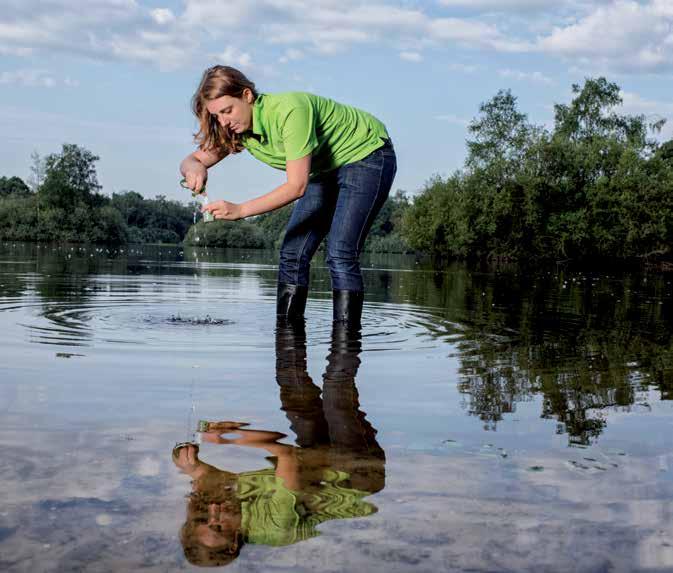
ws From working with programming technologies and technical documents to researching nature: how did you make this change?
md First of all, I had a nagging feeling during my working days… it seemed like I just wasn’t in the right place. I knew I could do more than designing help systems, flyers and courses for IT businesses. I had also worked as a quality manager for a health and safety organization and as a credit manager for a health insurance company – both quite “static” jobs in which I didn’t feel fulfilled. I decided that I needed a radical change of perspective.
Due to a reorganization there were some changes in play and, although I was offered a new job at the same company, I decided to just quit. I had never done such a rash thing on the spur of
the moment. Still, intuitively it felt as if it was the right thing to do. I am a great believer in intuition. Reason is about understanding choices and keeping a healthy financial situation, but intuition is about trusting a “gut feeling” and believing it will get me where I want to be. I couldn’t have been more right.
ws When did this new challenge start and why did you choose to become a biologist?
md My first challenge was an expedition to Spitsbergen by boat, way up in the high Arctic. The trip itself and my stay took over a month, during which I found my true self again, believing that I had to do more with my interest in nature and above all with my special “bond” with water.
After the expedition I started a new course at the Open University called environmental sciences, along with an internship. Well, as it happened, I knew
Sometimes emotional investment is what you need to have a great idea, with no need for big budgets to get things going.
Anna Khaude is the founder and CEO of Affordable Yoga and Affordable Fitness Projects. Prior to this she worked at KPMG and was named employee of the year.
ws What did you do before running a community yoga project?
ak I was working as a management consultant at KPMG in London.
ws What made you change so dramatically from a consulting role?

ak I had almost always imagined myself running my own business and was looking for that perfect idea. For me, the key missing ingredient was the connection between my work and any tangible difference saw was making for the clients on a personal level.
ws
What are you doing now?
ak Now I am running Affordable Yoga. I started in February 2013 and since then it has developed from just a few hatha yoga classes a week to over 30 hours of various styles of yoga and fitness classes all over Paris. We also offer combined workshops and retreats. We plan to expand into other cities within the next year.
ws What was your investment in this career change?
ak I invested in getting a personal training diploma and then a yoga teacher qualification, a laptop and a printer! But the biggest investment was emotional; it was pretty difficult to adjust to the role of an “officially unemployed with no real plans for any kind of start-up idea” person.
ws Are you satisfied now?
Three exciting new life stories:
• Anna Khaude
• Elio Cristiani
• Francesca De Lucchi
ak I work very hard and a lot, but most days are the greatest rewarding and wonderful work experience could have ever wished for, especially when customers tell me that I have helped them battle depression or keep balance when they lost their job.
[W affordable-yoga.com aquon.nl divinapiadina.com eliocristiani.com wageningenur.nl wgs.nl]
someone who could help me. During the expedition to the Arctic I met a marine mammal biologist who arranged an internship for me at the Institute for Marine Resources and Ecosystem Studies, part of Wageningen University on the Isle of Texel in the north of the Netherlands. I took part in research on the haul-out behavior of common seals on the mudflats.
After my internship I found a job analyzing cyanobacteria samples at AQUON, a laboratory that mainly works for the Dutch water boards. I learned a lot
about phytoplankton on the job. After three years I finally got a permanent contract as a hydrobiologist in phytoplankton.
I have always been captivated by the dynamics of nature, so becoming a biologist is no surprise… When I was growing up I was mainly focused on birds and marine mammals. As a teenager I began to photograph my surroundings – urban nature and wild nature. That led to my interest in ecology and ethology, and I was eager to learn more about the living things and land-
scapes that I photographed. I also have an intense fascination for water: snow, glaciers, oceans, pools, fens, and so on. It seemed only natural to me to take the step from arts, culture and commercial work to biology. Looking back, I can’t comprehend why it took so long to make the move.
ws What are your main responsibilities?
md I work as a hydrobiologist in phytoplankton at AQUON, the institute for water research and advice. AQUON is a laboratory for the Dutch water boards
40 Work Style — #14.14 Work Style — #14.14 41
➽
01
in the southwest of the Netherlands, and is the biggest laboratory in our country working on analysis of water quality. My main responsibilities are analyzing samples of phytoplankton in line with the European Water Framework Directive, writing ecological reports and protocols, developing expertise by attending expert meetings and updating our literature database, participating in special projects involving fieldwork and field courses, and promotional work such as giving lectures and training.
ws Which are the most interesting aspects of your current job and what are the challenges?
md Nowadays, I mainly determine species of phytoplankton in samples in the laboratory. It’s always astonishing to find rare or new species. The most interesting part is probably writing the ecological reports – interpreting the results of phytoplankton species in terms of the ecological conditions of a lake or fen hollow. Eventually this leads to giving professional advice to our customers from the Dutch water boards. My challenge is to expand my expertise. In
a few years I want to become a senior hydrobiologist in phytoplankton, and this involves developing my research skills through education – continuing my pre-master’s and later on my master’s in environmental sciences – and by participating in special projects and expert meetings.
ws Did your cultural background influence your career change?
md Possibly it was triggered by the idea of “space.” In the Netherlands it is quite crowded, with lots of noise and other distractions. I tend to look for silence, for open places and the desolation of nature. My cultural background is therefore much different than, say, someone from north Norway with a mountain range in the backyard and no property boundaries. In my career I therefore prefer to go into the field now and again to find “my open space.”
ws Has your relationship with nature changed since becoming a biologist?

md People tend to think that nature and the environment are separate concepts outside of us, like economics and politics. I believe in deep ecology – that na-
ture has an intrinsic value in itself, not only a monetary value. Nature is dynamic, complex, inventive and part of us all – in a quantum perspective – not only outside us but also inside us, at the core of our own existence.
Consequently, my bond with nature has always been intense and my curiosity about how nature works keeps growing and growing.
ws What about the relationship between your work and your passion for travel photography? They are two different ways of looking at nature: through scientific instruments in one case and through a camera in the other.
md The camera can be a creative way to “paint” how we perceive nature in all its beauty, cruelty and roughness. We can only admire what we observe, and photographs are a great way to let someone take a peek at a special place or living entity without actually being there. At the same time, a camera can be a scientific instrument! With our professional microscopes we can examine and photograph algae in water samples. Algae are 3D too, with all different kinds of geometric forms and po-
02
I still want to be part of the corporate world, contributing through projects focused on the individual and taking advantage of artistic expressions like yoga and pottery experiences.
Elio Cristiani, after a successful career in marketing, became a professional potter, following his passion for the charming world of raku pottery.
ws What were you doing before you opened your pottery laboratory?
ec I graduated in economics from Bocconi University with a specialization in marketing, and soon received a job offer from JP Morgan. After that experience, worked in the consumer field for five years, then as head of marketing in the publishing and food industries.
ws What is your current occupation?
ec I have always been keen on pottery, and particularly the raku technique, thanks to an artist friend of mine who introduced me to this wonderful hobby. In 2012, following a difficult period at work, I decided to start my personal artistic project. In January 2012 organized my first pottery course in Milan and last September inaugurated a new artistic space called “manualmente lab,” where people can participate in courses and buy my handmade work.
ws What kind of investment did you make in this change?
ec I have invested 20,000 euros in the laboratory, which means the purchase of furniture and instruments and the rental of the building. To be honest, it wasn't so difficult to start my dream because by 2013 I managed to write off the expenses of starting a business.
ws What are your working projects for the future?
ec I've been working in the corporate sector for several years and I still like it. That's why, even if I've changed profession, I'm going to propose some activities for employees working at companies. It's not traditional consulting, but projects based on yoga and pottery.
Although all the facors that make a perfect job were there, my love of food and cooking became my high road
Francesca De Lucchi is an Italian entrepreneur managing a traditional take-away restaurant called Divina Piadina in the heart of Milan. She founded her company after leaving a promising career in the commercial division of an IT company.
ws What were you doing before you started to manage a “piadineria”?
fdl After graduating in economics at the Ca’ Foscari University in Venice, started working for a company in their commercial division in a managerial role. I was always traveling abroad and was in charge of many tasks, but I also had great rewards.
ws What is your occupation now?
fdl I currently manage a traditional “piadineria” in Milan, the city where live. started this challenge in 2006 and now it is my full-time job, although it allows me to have much more spare time than my previous job at the company. At the beginning it was not easy.
ws What made you change?
fdl I have always been keen on cooking and I have always been attracted by the food service sector. But the main thing that convinced me to change was my desire to spend more time with my family, and especially with my daughter.
ws What investment did you make in this career change?
fdl It was 2006 and compared to now it was quite easy to get 30,000 euros to start a business. Recently have restructured the rooms and, because of the recession, it has been harder to obtain a loan.
lygonal outlines. We are able to capture this characteristic by taking Z-stack images; this is a digital image that consists of layers of photographs, like an MRI scan. If we produce a Z-stack image to capture the algae as a whole, we are able to study the material afterwards, exactly as we encountered them. So I believe photography can be creative
and scientific at the same time, being complementary to each other. And it’s a gateway to show everyone how captivating the world can be, in a macro and micro perspective.
•
ws What is the secret to change management without regrets?
fdl For me, it’s important to have a very entrepreneurial attitude and to be decisive. In my case, this approach has helped me to get what wanted: personal satisfaction and a perfect trade-off between private and working life.
42 Work Style — #14.14 Work Style — #14.14 43
➽
➽
01 Marta Demarteau collects samples of water for analysis
Marta Demarteau tags the samples to take them to the lab
02
Best Practices in HR Management Unusual Job
By MARTHA TINTIN
The Voice-Over: Giving Life with your Voice

Voice-over actors can work on a wide variety of projects. They can be narrators in movies, they can bring cartoon characters to life and they can voice commercials, as well as dubbing movies in foreign languages, especially in countries such as Spain and Italy.
When we go to the movies we usually go to see the big actors who have won numerous awards, however, we often forget about those actors we never see but who are there – the voice actors.
GOING TO SCHOOL
Becoming a voice-over artist always starts with a good acting background, as Roger Del Pozo, director of acting admissions at the New York Film Academy, points out: “The New York Film Academy’s acting for film courses would be the best place to start. Most successful VO actors have extensive acting technique training. All of our actors do extensive voice training as a part of a fully comprehensive acting program.” Joanna Ruiz, a British voice-over actress, says, “There are some really good courses around; one should look for the ones offering accent courses and character courses.” In Spain, the Escuela del Doblaje (Dubbing School), owned by DL Multimedia, offers a 16-month training course, as explained by the school’s general manager, Carmen Gambín, who says, “The course is both theoretical and practical, developing comprehension, diction, modulation and articulation skills in Castilian,” and adds, “The training focuses on both the technique and interpretation as well as the study of the acting register that every acting professional must possess.”
PROS & CONS
Like all jobs, even one that might seem glamorous has its advantages and disadvantages, according to Gambín: “The job is not as well recognized as that of a movie actor, even though many prefer it for this very reason, but the advantages are that you can be any character you want and that as the voice timbre doesn’t change you can be 70 and give your voice to a 30-year-old character; the physical conditions are not as discriminatory as for a camera actor.”
Orr thinks that every job, every script and every client is different and says, “ keeps you on your toes and your brain active, the money can be great, you get to see inside some great studios and to hear yourself on the TV and radio and say ‘That’s me!’” On the other hand, however, Orr thinks it is a very tough market, with lots of voices competing for the same jobs.
In the USA, the advantages of being a successful voice-over actor are numer ous. As Del Pozo says, “It is a very flex
ible, lucrative and creative profession.”


On the other hand, it appears that this field is extremely competitive, meaning that breaking in can be very difficult as the talent level at the top of the voiceover chain is very high. “Competition is fierce,” claims Del Pozo.
Voice-over actress Ruiz says, “Work can be very quiet at times... only the best work all the time,” adding, “The advan-
KEYWORDS
➜ Acting ➜ Practice and Theory ➜ Competitive Market ➜ Soft Skills ➜ Perseverance
Gambín. Many people may have a great voice, but to be an extraordinary voiceover actor one also needs the talent and ability to use that voice effectively. Del Pozo says, “If you think of voice-over work as a sort of music, your voice is your instrument,” and adds, “You have to be able to use that instrument in very technical and specific ways that go way beyond simply having a nice-sounding voice.” Being able to act well is probably the top skill to possess, as Ruiz explains: “A good voice actor is someone who first and foremost can act. As they can’t use the rest of their body they must be really good at expressing things just with their voice as they can’t rely on aids like facial expressions,” and adds, “One must also have a good, strong voice; it must not be quiet and whispery and one must take care not to talk too fast.”
tages are that you get to do all kinds of things, from being a small child in an animation to being a deep- and huskyvoiced woman in a commercial – and for a lot of money!”

THE RIGHT PROFILE
There are many factors that make a good voice actor and having a good voice is just one of them. There is also the ability to take a script you have not seen before and somehow breathe life into it so that you sound like you are improvising. “Being spontaneous is a key skill to have,” says Orr. There are, however, many other skills needed, for example the ability to sound like you are not reading even though it’s known you are, turning up on time, if not early, to every session, and having excellent sight-reading ability. It is clear that a nice-sounding voice is absolutely not enough to be a good voice-over actor, but it’s a great advantage “provided one knows how to use it properly,” says
Other skills needed are a good ear for different sounds, styles and accents as well as being able to change your voice quite a lot. “I listen to different voices and characters all the time and practice different sounds,” confesses Ruiz, adding, “You do have to sound nice, but if you can change the way your voice sounds you’ll be ok as most jobs will want a completely different sound from the last job you did for them!”
If you don’t have a good-sounding voice, don’t panic. You can still make your dream come true, as Del Pozo explains: “If you do not have a traditionally ‘nice’ voice you can still work, provided your voice is specific, expressive and flexible. What is important is talent, intelligence, timing, perseverance and a well-trained and conditioned voice.”


AROUND THE WORLD
The use of voice-over artists varies from country to country. In Italy and Spain, for example, movies are still translated
If you’re based in London a good option could be The Showreel, as JP Orr, head of voice production and training director, asserts: “We offer many courses and demo packages, for example the beginners’ workshop, as well as personal training plans.” [W escueladedoblaje.com joannaruiz.com nyfa.edu theshowreel.com]
and dubbed, but in the USA this works slightly differently. To start with, movies are not dubbed but rather subtitled, and many voices are those of Hollywood actors or other celebrities, such as Ellen De Generes in Finding Nemo, Kat Dennings or Beth Behrs. Del Pozo comments: “Thankfully movies are subtitled in the USA, so there is not a market for actors dubbing movies,” and adds, “Many celebrities do voice-over work because it is so lucrative and easy in comparison to working on camera or stage. They can make a lot of money in a short time and producers hire celebrities so they can take advantage of the instant recognition; for example, when you hear Ellen you immediately recognize her voice and personality. Commercially, producers want to hire celebrities so that the brand is associated with that specific celebrity.”
FINAL ADVICE
According to Ruiz, the best advice would be, “Practice talking along with cartoon characters, read lots of things out loud and listen to commercials, as most successful VO actors are very expressive and great storytellers with technically precise, distinctive, well-trained voices!”
Orr claims, “It’s not only about how you sound but how you make the listener feel that will get you hired again.”•
44 Work Style — #14.14 Work Style — #14.14 45
Illustrations by Gary Venn, Cambridge, New Zealand
Practices in HR Management Joining the Company
By FEDERICA MILANI
Searching for the Right Person
Finding the most suitable employee for a position is not easy. Psychological assessment tools are becoming the key strategy of hiring corporations interested in hitting their business goals and avoiding high employee turnover.
Hiring and training new employees can be an expensive process. This is one of the main reasons why an increasing number of companies around the world are including assessment tools in their effort to accomplish a wide range of objectives and to answer a list of needs inside corporations. Together with the aim of hiring the right person for a position, psychological tests run by international work assessment companies also aim to identify high-potential talent, develop workers’ interpersonal and leadership skills, and set performance goals for staff.
WHY PSYCHOLOGICAL ASSESSMENT?
In today’s job market the purpose of psychological testing is to make more informed hiring decisions, and the easiest and fastest way for companies to do this is to consult outside corporations committed to employee screening with the promise to help companies save on the costs associated with high employee turnover.
“Assessments are used for a variety of purposes. Most commonly to inform selection decisions regarding who should be hired, but increasingly for decisions about who to promote into sensitive roles and to diagnose areas for learning and development prior to moving into more complex roles,” says Doug Reynolds, past president of the Society for Industrial and Organizational Psychology and senior vice president of assessment technology at DDI, a global talent management consultancy. “Well-designed assessments give you an in-depth reading on the work-related capabilities of people, just as a blood test can help give a reading on physical health. Assessment solutions are useful in promot-
ing and retaining top performers and identifying areas for development. In the case of John Clements, we take pride in our heritage as we have been in HR consulting work for the last 39 years.” “In my experience, assessment tools are often utilized when considering hiring new leaders, senior-level promotions, employee career development and overseas assignments,” adds Carol Olsby, principal of Carol Olsby & Associates Inc., based in Washington. “I have spent my entire career with technology companies and assessment tools are often utilized for the recruiting of executives and senior leaders, senior-level promotions, career development and consideration for overseas leadership role assignments,” continues Olsby.
In some cases, psychological testing at companies still appears to be a matter of a “war of talent.” This is the belief of Evelyn Grace C. Sorongon, vice president and managing director of John Clements Consultants Inc., who comments, “As we all know, the war for talent is real and it is best to gear ourselves up and face such a market phenomenon. The talent landscape has also changed. We scramble for talent whenever there are vacancies, and a lot of times we are also unable to keep the talent as we neither need nor motivate the people to perform in accordance with our expectations. It is for this reason that managers of the 21st century should take a serious look at how they conduct their selection and recruitment process. They should also look at whatever assessment tools are available in the market to make the selection process robust and effective.”

A “war of talent,” but also a war against the risk of spending money and wasting time on hiring the wrong person: “Assessment companies help their clients
[W carololsby.com ddiworld.com johnclements.com rhrinternational.com siop.org]
manage risk. A bad hire is expensive in time, money, lost momentum and aggravation. Now more than ever, our clients can’t afford a loss in any of these categories. By reducing the amount of ‘unknowns’ we help our clients make better hires and fewer mistakes,” affirms Guy Beaudin, senior partner at RHR International.
STEPS TO SUCCESS
In the hiring psychological assessment the central questions is: “How well does the candidate fit the profile required for the role?” But it would be a mistake to focus only on this and overlook some other key aspects for a successful assessment.
“The most important thing is how well the assessment was designed. This is a technical area that requires extensive training and expertise,” explains Reynolds. “Ask your assessment providers if they have industrial-organizational (I-O) psychologists on their staff (they should). Ask for a review of the technical support for the assessment tool. Ask for a conversation with the I-O psychologist about the appropriateness for your application. If the tool is well designed, the expert will be very willing to discuss the foundation for the instrument in terms you can understand. Unfortunately, you can’t often tell a good assessment from a bad one by looking at the surface. It’s the underlying statistical work that makes for a strong tool.” Employee potential and resistance to stress are the key elements at RHR International: “A good assessment goes beyond the person’s current skill set to provide a perspective on their ability to handle roles of increased scope and complexity along with the steps that are required to help that individual achieve
their potential. Moreover, as scope and complexity increase, so do stress and scrutiny, which make it more likely that an individual’s derailers will surface. A good assessment will outline an individual’s likely derailers and provide advice on how to minimize and manage them more effectively,” says Beaudin. However, the way to a successful assessment process is not free of obstacles, stresses the managing director of John Clements Consultants Inc.: “For faster and greater productivity, we have embedded computer-based assessment solutions into our selection process. This is a priority step in attracting talents whose interests and discipline are what differentiates them from our generation of manual systems operators. But who says that talent assessment and recruiting is an easy job? Certainly, it requires much effort and a strategic mindset. It also requires a lot of ground work, research and continuous effort to strike the right balance between HR activities versus cost. If one is not careful, costs can skyrocket and the results will not justify putting in place a talent management system.”
A “PASSEPARTOUT TOOL” Assessment companies can provide a significant, positive impact for a full range of public, private and non-profit organizations dealing with many different businesses and situations. “Assessments are used in practically every industry,” confirms Doug Reynolds. “The typical situations where assessments are most useful involve one or more of a few factors: there are far more candidates looking for a job than can be hired, the job is complex enough that not everybody who is hired ultimately succeeds in the job, and/or the job carries a significant amount of risk (either for the company, the person in the job or the public). Senior executives are often asked to go through assessments to get an idea of their fit and strengths/ weaknesses because their work carries so much risk. Conversely, there is not much of a need to assess for instance dishwashers, because most people who would want the job have the capability to succeed and the risks are low if
they don’t.” “When a current consumer goods client announced a merger with another international manufacturer of household cleaning products, they contacted RHR to help with the integration of the two executive teams. RHR recommended top candidates for the top 200 positions within the merged company. Seven years out, the merger was identified as one of the most successful corporate mergers of recent times and one of the few that drove real shareholder value,” explains Guy Beaudin of RHR International. “Also, a venture capital organization had a significant interest in a promising software firm. As directors, they witnessed problems occurring as the leadership transitioned from the CEO/founder to a new CEO. They contacted RHR to assist them. RHR interviewed the founder, the new CEO and the employees to ascertain what was happening. An assessment indicated that the new CEO was not a good cultural fit. The board terminated the new CEO. An RHR-recommended candidate successfully took the company forward.”
WATCH OUT FOR FAILURES
Assessing candidates using psychological tools can hide the risk of running into bad performance and wasting time. Unsuccessful psychological assessments are not excluded at all. “When tools are used that don’t have the required validation work, employers can be liable for damages if the tool unfairly discriminates,” explains Reynolds. “This depends on the laws of the country in which they are used, of course. In many countries, it is important to show a correlation between the assessment and job performance. If this relationship does not exist and the test eliminates people from a legally protected class, then the organization can be forced to change the procedure and pay fines. This is one example of an unsuccessful assessment. Well-designed assessments that fit the job they are used for are your best defense against this situation. Companies must be aware that some assessment tools are not much more than a pop psychology quiz invented by a lay person to market a product.”
“Being just one aspect of the interview
process, assessment could be disastrous,” adds Carol Olsby. “The company also considers the candidate’s interview with the team, employment references, employment history and, if they have received any, personal recommendations from highly regarded individuals. An assessment tool’s results are influential in the candidate evaluation process. For example, if the company has an environment that promotes collaboration and transparent communications and the leading candidate’s assessment reflects low scores on these indicators, this would be highly beneficial information for the company to have when considering the candidate.” “No assessment process is perfect, but all good assessment processes will reduce the risk of a bad hire over time,” is the final conclusion of the senior partner at RHR International, Guy Beaudin.•
• Development Dimensions International (DDI) is a top talent management consultancy founded in 1970. The company today counts 46 offices in 26 countries.
• Carol Olsby & Associates is the company founded by Carol Olsby and offers leadership, operational and tactical solutions in human resources.
• John Clements Consultants is an executive search consultancy founded in 1974 in the Philippines.
• RHR International is an executive search firm with offices in 12 countries worldwide. The company specifies in assessment, alignment and development of senior leaders.
KEYWORDS
➜ Psychological Testing ➜ High Potential ➜ Cost Cutting
➜ Computer-based Assessments ➜ Stress Endurance
46 Work Style — #14.14 Work Style — #14.14 47
Best


48 Work Style — #14.14 Cartoon by Patt Kelley, Boston, USA


50 Work Style — #14.14 Work Style — #14.14 51
Private Eye The Business Side of Style
INDEx Product Design Awards – Dubai (UAE).
DESIGN for Work 1 3
The INDEX & Workspace at INDEX Product Design Awards honors manufacturers and designers for excellence and innovation in product design for the residential and commercial sectors. The competition is open exclusively to companies exhibiting at the 2014 editions of INDEX and Workspace at INDEX exhibitions, and covers a range of awards categories. The awards are divided into 6 categories covering a range of exciting products. For workplaces there are 3 categories: desks and tables, seating, and surfaces and finishes.
The award winners for the 3 Workplace categories are:
1Desks & Tables
WINNER: ASPIRE BY GUIALMI DESIGN TEAM, PORTUGAL
The project developed a desk, ASPIRE, which is available in more than 6 different finishes made from 100% wood veneer, and with small but important quality details such as leather handles and lacquered fronts and/or decorative stripes. The main item is the desk with a side credenza that configures the manager/executive area – his or her territory - and it comes with space for filing, leather extensions on handles and on top of the table, and an optional modesty panel.

2
Seating WINNER: MODELLO BY OFS BRANDS ITALY

Modello is a family of Italian-designed chairs that consists of an arm and armless side/dining chair along with a counter-height and bar-height stool to complete the look. The armchair includes a beautiful chrome arm option, which gives the chair a distinct look with a mix of materials. The stitched pattern design spans the back of the chair adding a special detail. Beautiful from every angle, this design will stand out in any surrounding and make an environment instantly feel warm and rich.
Screens, Partitions & Moveable Walls, Germany WINNER: MONOTOP CLIMATE WALL BY C&P MOEBELSYSTEME GBMH
In cooperation with the Fraunhofer Institute for Building Physics, C&P presented the Monotop climate wall. It enables totally clean, energysaving and healthy cooling. At the same time, the Monotop climate wall is quite eye-catching and enhances the room thanks to its design and functionality. This advanced concept dehumidifies and cools the ambient air without any noticeable or even bothersome air flow. Furthermore, the cooling water film "disposes of" minor air pollutants such as dust or pollen.

52 Work Style — #14.14 Work Style — #14.14 53
2
3
[W indexexhibition.com]
Brendt Barbur

Brendt Barbur (1971) moved to New York from San Francisco 15 years ago to be involved in the arts. Through the years he kept busy with a number of art projects until he was hit by a bus while riding his bike – a horrible experience that drove him to do something positive from it. “I was the victim but I was treated poorly; people said it was my fault because I was stupid to ride my bike in the streets of New York,” he says. Brendt decided that he wanted to do for bikers what had been done for surfers. Today surfers are “cool,” but they were not considered so when the surfing movement started. He started with the idea of making a movie, which soon turned into the Bicycle Film Festival, a cultural event and not a festival about bikes. “The festival operates in a collaborative way; we want to make everyone feel involved. Content is much more important than marketing,” he says. Brendt is currently directing his first movie about a bike race. “This is probably the biggest project of my life,” he says. Brendt loves cooking and going to art shows.


54 Work Style — #14.14 Work Style — #14.14 55
Photos by Keith Barraclough, New York, USA [W bicyclefilmfestival.com]
Watch
“I love what I do, but I have been doing this for 15 years and it is important to explore and not get stale.”
PEoPlE to
Jane Lu



“At first it was very difficult. We didn’t speak the language, but I think my parents, after the Tiananmen protests, understood that China was not the place to bring up a child.”
Jane Lu (1986) emigrated with her family from Beijing to Sydney at the young age of 8. Not knowing the language and culture made the adaptation initially difficult. She understood the meaning of hard work and sacrifices as her parents left everything they knew and their professional careers to work in factories so that they could give her the chance of a brighter future. Jane today is a very young entrepreneur – she owns an online fashion store that was built largely on social media. She recalls, “The idea for Showpo grew from when I was working in my corporate finance job. I shopped online as an escape from my mundane job but struggled to find many stores that provided on-trend yet affordable clothes. I wanted to buy something new to wear for Friday-night drinks that wasn’t going to break my budget as a graduate analyst.” Jane had no money when she set up her new business. “I was completely broke from travels, uni debt, being jobless and from my business failure. Having no funding meant our business has always been a very lean and profitable operation.” When not working, Jane has a love for traveling, having visited 50 countries already. Today, Jane is happy – she has built a career out of her passion and loves coming to work every day.
56 Work Style — #14.14 Work Style — #14.14 57
Photos by Paolo Mazzo, Milan, Italy [W showpo.com
PEoPlE to Watch
“I was solving a problem of my own, hence the idea to create special bespoke shoes for every woman.”

Jodie Fox (1984) was listed among the top 30 most influential Australian women in retail for 2014 at the age of 30 by the magazine Shoes String. This is one of Jodie’s achievements thanks to the great intuition she had in 2009 when she launched the online retail website Shoes of Prey, based in Sydney. “Shoes of Prey is a website where women can design their own shoes,” explains Jodie. “I was solving a problem of my own – I’ve always liked shoes but I never loved them because I couldn’t find exactly what I was looking for: the right color, the right heel height and so on. When I was traveling I found someone from whom I could commission shoe designs. My shoe collection became really exciting, and my girlfriends asked me to create shoes for them too.” Living in the Sydney suburb of Surrey Hills – the city’s main center for wholesale fashion activities, with a mixture of residential, commercial and light industrial areas – Jodie likes spending her days at her favorite café, Single Origin, having breakfast at Kitchen By Mike and cultivating her great passion for design, wine and, of course, fashion. “I’m passionate about inspiring a light in other people,” she says, “and I see my next 10 years being spent on my business, working hard to improve it and hopefully being surrounded by my own family.”


58 Work Style — #14.14 Work Style — #14.14 59
Jodie Fox
Photos by Paolo Mazzo, Milan, Italy [W shoesofprey.com]
PEoPlE to Watch
PEoPlE to Watch

Kimihito Okubo

Kimihito Okubo lives in Tokyo. He’s married and has a 20-year-old daughter. He holds a degree in business administration from WSDA, a prestigious university in Tokyo. After many years in advertising he has developed the idea that although Japan is very avant-garde in technology, what hampers globalization in the country is the attitude of the Japanese. “Japan remains a country based on the product, definitely high quality, but lacks the strategy, a vision for these products, which must fight in an increasingly competitive market," states Okubo. Kimihito is member of the One Young World committee. His professional experience has sparked his desire to do something for his nation. For this reason Kimihito has set up a company called "One World" whose aims are to create international links to encourage greater exchange between Japan and the rest of the world. In addition to this, Kimihito is very busy organizing an international forum that will be held in Tokyo in 2015 for his NGO.

60 Work Style — #14.14 Work Style — #14.14 61
Photos by Paolo Mazzo Milan, Italy [W oneyoungworld.jp]
“In a word? I would like to see youths expose themselves to the world.”
a vision, acknowledge your dreams and pursue them taking active steps.”
Sacha Beverley (1977) was born in Gold Coast, Australia. She has always been very creative. She recalls, “When I was seven, I remember making greetings cards in my bedroom to sell to my mum and family. I was also winning coloring competitions at the age of 8. I guess I was born creative!” When she left school at 17, she started working in hospitality, administration and photography, and at the age of 21 she started traveling around the world while working. She says, “It’s thanks to traveling that I really started having an understanding of myself and others, as well as of what I liked, what I didn’t like and what I was passionate about.” Once back in Australia, she realized that hospitality was not really something she wanted to do in the long run, which made her take a course in interior design. She worked for seven years in the design industry until two factors made her realize that she was ready for another career change, the first one being that while working as an interior designer in London she took a course at the prestigious Central Saint Martins in textile design and fell in love with transporting art onto fabric; the second being the fact that she lost her job, which gave her the final push to take the leap of faith and pursue a career in art. She says, “Losing my job was a blessing in disguise.” Today, Sacha has her own gallery in Southport, considered to be Gold Coast’s business district, which she opened in 2012.



62 Work Style — #14.14 Work Style — #14.14 63
Sacha Beverley
Photos by Paolo Mazzo, Milan, Italy [W sachabeverley.com.au]
“Have
PEoPlE to Watch
PEoPlE to Watch

Marta González Tarruella
“Enjoy the little things in life and never stop dreaming.”
Marta González Tarruella (1980) is a Spanish fashion blogger living in Madrid. She holds a PhD in political sciences but she decided to go for something very different: she runs a blog on hola.com about fashion, lifestyle and horses. “This is my true passion, together with the field where I grew up, because of my father: he was a bullfighter and taught me to love this way of life.” Although she loves horses and country life, Marta lives in Madrid, where she has a very hectic life. She explains, “Running a blog requires dedication, time, resolution and effort,” and adds, “I have to attend many fashion events in Madrid but I also have to go to the countryside every weekend to interview people for Galope magazine.” Marta is one of those lucky ones who has transformed her hobby – horseback riding – into her job. She has been influenced by her hobby since she was a child. She recalls, “I grew up in the countryside and I played many sports with horses, such as jumping and doma clasica, and I also enjoyed herding cattle with my horse. I missed this part of my life a lot when I was studying in New York or working in the European parliament.” Marta also enjoys painting. At present she doesn’t want to think about the long term and has only short-term professional plans.


64 Work Style — #14.14 Work Style — #14.14 65
Photos
David
Albacete, Spain [W
]
by
Rodríguez,
blog.hola.com/marta-gonzalez galopetrofeocaballo.com
Nicolás Ovalle


“Life is like a trip: we always need to make time to do what makes us happy.”
Nicolás Ovalle (1990) has visited 18 cities in two years, mainly in Europe, meeting people and attending training and workshops, before coming back to his country, Uruguay. A year ago, together with his girlfriend, he created the startup Banana Split in his home city of Montevideo, focusing on fashion apparel and launching their first summer collection. “After working at Ogilvy in the digital sector, I decided to quit. At Ogilvy I had a very growing experience, but I’m always thinking about something new. I’m a very dynamic person and at that time I was looking for a new challenge.” Through his company, Nicolás has managed to transfer his personal approach to life to his brand, characterized by a strong belief in fair trade and local development. “For me, life is like a trip: we have to enjoy it and make time for what makes us happy. I really like reading, I’m passionate about movies and when I have a little time I love taking refuge in the little village of Punta Del Diablo, in the north of the country, where I have a house. It’s a lovely small fishing village. When I get up in the morning I always drink coffee from my Italian coffee maker, which belonged to my granny, who was born in Potenza, southern Italy, and this is the best good morning I could have every day.”

66 Work Style — #14.14 Work Style — #14.14 67
Photos by Dario Invernizzi, Montevideo, Uruguay [W facebook.com/shopBananaSplit]
PEoPlE to Watch
Stephani Carter

“My work is my best passion, singing and dancing my best hobbies.”

Stephani Carter (1980) is the founder and principal of Ecoammo, a "for-purpose" sustainability consulting firm based in Edmonton, Canada, committed to providing sustainable building design and construction. “At our company we think that finding solutions to environmental issues is the true key to moving forward and seeing a better future,” says Stephani. “I believe in integrity and in the importance of celebrating individualities in running a business.” Traveling the world for many years because of her job, Stephani realized business should take more care of the environment. “I was disappointed about practices, above all in the building industry,” explains Stephani. “I became more and more conscious of facing these challenges and I think that the world itself is currently going through a transition moment, changing its way of thinking and acting about the environment, even if with baby steps.” Funk songs and swing dances are great passions, and when she has some free time she likes to play at concerts and parties with her band. At the beginning of next year, her company will move to its new headquarters, the biggest green commercial building in western Canada. “If you really want to change the world, you need to live by being an example for other people, and that’s what we are doing.

68 Work Style — #14.14 Work Style — #14.14 69
Photos by Darren Greenwood, Edmonton, Canada [W ecoammo.com]
PEoPlE to Watch
MoVIES for Work
Today, chefs are very popular on TV and in the movies because of the gourmet boom of the past few years. This movie is a fun comedy portraying a world of great passion and humility, seasoned with excellent Cuban salsa. Carl Casper (Jon Favreau) is a talented chef at an elegant restaurant, which becomes famous and successful thanks to him and his team. These people are brought together by their mutual passion, culinary skills and good management. However, as often happens in kitchens, imagination and creativity clash with the restaurant owners, who prefer to offer a tried and tested menu, reassuring customers and maintaining their profits.
When a visit by a famous critic is announced, the chef comes up with an innovative menu, but that’s when the dispute between chef and owner begins. In the end, Carl loses and accepts the classic menu instead of the innovative one that would surely have impressed the critic.
As foreseen, the chef is savaged in the critic’s review for the triteness of his dishes. This sparks a Twitter fight, which ends up face to face in the restaurant. Carl loses his job and is kicked out of the Los Angeles Chefs’ Circle. Carl loses everything, and this is when he decides to start from the bottom with the support of a friend – his sous chef – his Cuban ex-wife and their son, with whom he must also try to salvage his relationship. He leaves Miami – the city that discovered him – with a refurbished food truck and a Cuban-style street-food menu, heading for Los Angeles.The little boy gets a glimpse of his father’s passion, and using his technology skills, typical of his generation, tries to help his father, who had previously been destroyed by the Internet, by encouraging people who want to try his delicacies to follow him and help him regain his success. It is the critic who destroyed Carl who has faith in
him and opens a restaurant for him where he can finally freely express his creativity. Sometimes going back to the start helps to give you different a view of things or regain the vision that you have lost: passion, relationships and satisfaction.
Carl Casper (Jon Favreau)
Some fun on set
The movie poster
Photos are courtesy of NBC Universal.
Characters Jon Favreau (as Carl Casper), Sophia Vergara (as Inez), Dustin Hoffman (as Riva), Scarlett Johansson (as Molly), John Leguizamo (as Martin), Emjay Anthony (as Percy), Oliver Platt (as Ramsey Michel) and Robert Downey Jr. (as Marvin).
Characters Created and Directed by Jon Favreau.
Produced by Sergei Bespalov, Jon Favreau and Karen Gilchrist.

[W chefthefilm.com]
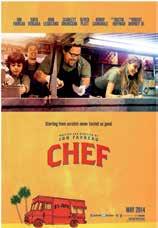

 TONEGUTTI
TONEGUTTI
On a cold London night, Locke (Tom Hardy), a construction site manager working on a huge skyscraper, gets into his black sedan and begins a journey. The film is kind of a road movie, entirely set in a black BMW. It develops through the character’s phone conversations with the people in his life, who ultimately never appear on screen. Locke is an impeccable worker and family man. Once he gets in the car he decides to drive to the Memorial Hospital to attend his third son’s birth: an unexpected consequence of a one-night stand with a stranger who informs him by phone at the beginning of the journey. His decision to go to the hospital is driven by his resentment for his father, who abandoned him. The choice he makes will change his ordinary life in just a few minutes. The movie develops through his drive to the hospital, during which Locke commits to put his working and emotional life in order, just as someone writing his final will and testament would do. His work is key in the movie, which tries to document the character’s sense of responsibility for his task – managing a huge project – and his desire to guarantee the result at any cost, showing that the success of a process is not made by one but by a team. Locke, who has never been absent from work, controlled by his conscience, decides to take a day off at the wrong moment; despite this, he succeeds in doing a good job and supporting his team, solving problems by phone. Obviously, the fact that the protagonist is a conscientious foreman does not help him to keep his job in a world where strict business rules supersede values and the request for a day off without an adequate reason. But Locke is only interested in the project’s success, for himself and his team, showing a loving approach to his work. However, his wife, informed of his betrayal and



decision to recognize the “son of sin,” shows no understanding and collapses in despair; but while her position seems emotionally justified, the corporate executive’s decision to lay Locke off shows how business is emotionless. This is a very good movie based entirely on the skills of the actor, the dialogue and the issues that slowly pile up; a talented man’s life crumbles on
London’s highways, but he does not fall into despair and instead makes a new start, with hope for a new job and an extended family.
01 Ivan Locke in his car 02 Mirror reflection
03 A pensive Ivan Locke
04 Movie poster
Photos are courtesy of A 24 Films.
Characters Tom Hardy (as Ivan Locke), Ruth Wilson (as Katrina), Olivia Colman (as Bethan), Andrew Scott (as Donal), Tom Holland (as Eddie) and Bill Milner (as Sean).
Created and Directed by Steven Knight.
Produced by Paul Webster and Guy Heeley.
[W locke-movie.com]


70 Work Style — #14.14 Work Style — #14.14 71
ChefGourmet cuisine, chefs, Twitter fights: a quest to regain success.
03 02 01 04
02
03
04
04
01 Family business in Cuban salsa
Locke
A man’s drive to understand life with an optimistic approach.
02
03
01
Reviews By FRANCESCA
Primal Teams

[AMACOM, 240pp, $24.95]
Emotion, more than anything else, spells the difference between stellar and mediocre team performance. Fear, anger, frustration and other negative feelings can endanger a group’s dynamic. But positive emotions have the power to transform it into a highperformance engine, where everyone operates at their peak. Their minds sharpen. They find creative solutions. They get great results.
Deb Bright
Exciting New Releases
BooKS for Work BooKS for Work
Find 40 interesting new releases and six unique interviews for fresh ideas on HR and business trends.
The Truth Doesn’t Have to Hurt
[AMACOM, 256pp, $17.95]
Nobody likes criticism. Handled poorly, it too often stings and breeds resentment – and most of us try to avoid it at all costs. The Truth Doesn’t Have to Hurt explains how criticism – crafted carefully and communicated skillfully – can promote trust and respect, motivate individuals and serve as a catalyst for change, showing its ability to turbocharge workplaces and careers.

Taffy Williams Think Agile

[AMACOM, 224pp, $23.00]
Funding falls apart. A similar product is unveiled by a more established company. A key employee jumps ship to work for a competitor. These are the unexpected obstacles that derail even the most promising new ventures.
Entrepreneurs determined to keep up with today’s constantly changing business environment need to stay nimble enough to shift their strategies.
M. A. Soupios & P. Mourdoukoutas
The Ten Golden Rules of Leadership [AMACOM, 144pp, $15.95]

Skills and experience might land you a leadership position, but they don’t make you a true leader. Leadership comes from inside – and the greatest leaders first question themselves before they tackle the world around them. To aid in this critical interrogation, The Ten Golden Rules of Leadership explores ideas from Aristotle, Heraclitus, Sophocles, Hesiod and other great thinkers.
Andrew Miller
Redefining Operational Excellence: New Strategies for Maximizing Performance and Profits Across the Organization

[McGraw-Hill, 256pp, $27.95]
Our world is too complex, too interconnected and too fast-moving for organizations to achieve dramatic results simply by eliminating waste and increasing standardization. True operational excellence is a mindset, and it achieves breakthrough results.
Bernhard Schroeder
Fail Fast or Win Big

[AMACOM, 192pp, $21.95]
Entrepreneurs have long been taught that to be successful they need to spend months perfecting a business plan and finding investors before they can finally launch their business. But with the marketplace changing at lightning speed, this notion is not only outdated, it’s costly. Today’s entrepreneurs must embrace the idea of “failing fast.”
Kevin Short
Sell Your Business for an Outrageous Price

[AMACOM, 240pp, $21.95]
Too many businesses sell for far less than they should. After pouring time, energy and money into their company, owners deserve to squeeze every last dollar they can from that hard-earned investment. Sell Your Business for an Outrageous Price is the playbook they need to win big at the closing table.
Aimee Bernstein
Stress Less. Achieve More [AMACOM, 256pp, $17.95]

With greater workplace demands comes greater stress – and it’s taking a toll on our productivity and wellbeing.
The standard recommendations are to exercise, meditate and eat better. But who has time for yoga poses amid nonstop meetings and pressing deadlines? Executive coach and psychotherapist Aimee Bernstein offers in this book a more effective and realistic approach: embrace the pressure.
ws Why did you write this book?
ab This book takes networking to a new level. It shows individuals how to be more successful, no matter what their job type or job level. And it shows organizations how to encourage employee networking and draw on the power of these networks to accomplish wider goals. It’s a must-read for leaders who want to bring in the business, increase collaboration, innovation and engagement, and take productivity to new heights.
ws Why has networking become an essential professional skill?
ab The old command-and-control style of management is disappearing. In its place, a new kind of environment is emerging. We call it the “network-oriented workplace” (the NOW). To be successful in the NOW era, employees need skills for collaboration. Building trust-based relationships is the only route to collaboration.
ws What are the advantages of networking?
ab When you add networking to your repertoire of skills, you’ll be able to complete some key actions such as: getting the job done faster and better; advancing your career; contributing to achieving organizational goals; and having a bigger impact.
ws What is the role of today’s technology?
Strategic Connections: The New Face of Networking in a Collaborative World [AMACOM, 256pp, $21.95]

With old command-and-control methods replaced by openness and transparency, networking has become an essential professional skill. Unveiling eight indispensable competencies for the new network-oriented workplace, Strategic Connections provides practical advice for building better, more productive business relationships.
ab Put technology in its place. Use it as your complementary – not your primary – mode for connecting. For building trust, nothing beats face to face. If you must build trust remotely, use faceto-face techniques, like storytelling and asking good questions, to encourage people to trust you and to demonstrate your trustworthiness.
ws Why should networking include advanced face-to-face relationshipbuilding skills?

ab In our book, you’ll find the eight networking competencies for the NOW. Our company, Contacts Count, has been training people worldwide in networking skills for 25 years. We developed these competencies working with clients in business, academia, and government. These competencies provide you with all the tools you need for networking inside and outside your organization. Once you master them, you’ll be able to network with confidence and professionalism.•
Let's Stop Meeting Like This [McGraw-Hill, 168pp, $19.95]
Meetings don’t have to be a boring waste of time. Instead, they can be places where participants and leaders can get their work done productively, efficiently and happily. It is not an impossible dream. This book shows how.

Richard and Emily Axelrod’s new book offers a flexible, repeatable process that has already been used to run thousands of productive meetings in all kinds of organizations.
ws Why did you write this book?
dea There are 25 million meetings held per day in the US alone, and millions more worldwide. We heard and experienced our own frustration with meetings. There was a time when Emily spent two hours in a meeting deciding on the color of the trays in a school cafeteria. We believed we had something to offer that was different from the typical meeting advice, which basically says reduce the time and number of meetings you conduct. Meetings are essential to make organizations work. If you want to make meetings productive, you have to do more than reduce and eliminate. You have to look at what goes on inside the meeting.
ws Do people really consider meetings at work a boring waste of time?

dea People don’t consider productive meetings a waste of time. Unfortunately, studies show that 69 percent of meetings people attend are unproductive.
People feel a tension between getting their own work done and the work of the meeting. Meetings become a boring waste of time when you don’t know your role in the meeting, you are unclear about the meeting’s purpose, the discussion wanders and gets off track, one or two people dominate the discussion and, finally, decisions are not reached.
ws Could this model be applied to all kinds of organizations?
dea Yes, we have applied this model in Fortune 100 companies, schools, not-for-profits, government, and with salespeople who use it as a selling framework.•
72 Work Style — #14.14 Work Style — #14.14 73
Jackie Barretta
Anne Baber, Lynne Waymon, André Alphonso & Jim Wylde
Illustrations by Hanna Melin, London, UK
Richard Axelrod & Emily Axelrod
BooKS for work BooKS for work
D.
Geoff Mead
[AMACOM, 240pp, $24.95]
Think you can spot the leaders in your company? Don’t assume that you can identify them by their positions.
What about those employees who consistently step up, like the field agent who solves a previously intractable problem. These are more than “good employees,” these are “hidden leaders” and they are critical to an organization’s long-term success.
Black Hole Focus

[Wiley, 288pp, $25.50]
You’re intelligent, you’re capable, you might even have some pretty impressive academic accolades…but does that necessarily mean you know exactly what you want to do with your life? The answer is no. In Black Hole
Focus, Isaiah Hankel shows professionals how to take their careers and lives by the helm.
[Wiley, 240pp, $32.31]
A rare research-driven book on power by a leading academic. Only a few thousand elite leaders make decisions that shape the lives of 300 million people, but what do we know about them? This book is the result of a seven-year research project based on 550 interviews with senior leaders. It reveals seven key findings about how the powerful access and apply their power in the modern world.
Telling the Story
[Wiley, 320pp, $42.52]
Telling the Story shows how leaders affect our understanding of what is possible and desirable through the stories they tell. It opens a door into the world of narrative leadership: what stories are and how they work; when to tell a story and how to tell one well; and how the language and metaphors we use influence our actions and change how we think about the world.

David Collis
International Strategy and Competition [Wiley, 256pp, $59.54]

The book is a guide to strategic issues business leaders face when competing internationally. Designed for business students, International Strategy – based on the course the author teaches at Harvard Business School – analyzes cross-border operations and the decision-making process for senior managers in global organizations. global business strategy.
Julia Tang Peters
Pivot Points [Wiley, 256pp, $35.71]

Pivot Points identifies the five key decisions that determine leadership success, and brings them to life through the stories of five industry-changing leaders across various fields. The author shares her research on successful leadership and offers a road map to help readers get the results they want. Pivot Points also provides a self-diagnostic questionnaire that highlights warning signs of stalling and underachievement, as well as offering coaching suggestions.
Uplifting Leadership [Wiley, 240pp, $34.01]

The power of uplift enables any organization to do more with less, beat the competition and perform better than ever. Leaders who uplift their employees’ passions, intellects and commitments produce remarkable results. Based on original research from a seven-year global study, Uplifting Leadership reveals how leaders from diverse organizations inspired and uplifted their teams’ performance.
Richard Moseley
Employer Brand Management [Wiley, 224pp, $51.03]

This is a practical guide to implementation, drawing on a much wider range of cases and examples. This book draws on the significant advances in employer brand practice among leading companies to give managers hands-on advice for implementing successful employer brand planning, employer brand definition, and employer brand implementation and specific applications.
Jacob Morgan
The
ws What are the main obstacles to managing people today?
jm The biggest obstacle is abandoning our pre-defined notions and ideas of what it means to manage or lead. Most of the management thinkers or practitioners who developed the approaches that companies use today have passed away. Yet we still run our companies based on their ideas. It’s not to say that previous approaches are bad or wrong, but they need to be updated. Most concepts that companies use to manage today were implemented before things like smartphones and collaboration technologies.
ws What is the meaning of work in the current world and what are the changes both workers and managers must prepare for?


Future of Work

[Wiley, 240pp, $28.91]
Millennials will soon outnumber all other generations in the workforce, new technologies are boosting performance and cutting costs, and workers can work from anywhere at any time. This book explores the new behaviors, technologies and people entering the workforce and how to get the best out of them.
jm Work today is explained as follows: employees are cogs, managers are slave drivers, and work is drudgery. The Future of Work sees a completely different world where employees help drive how work gets done, where managers serve, lead, and empower their employees, and where organizations are distributed entities that focus on more than just profits as measures of success. The Future of Work details 7 principles for the future employee, 10 principles for the future manager, and 14 principles for the future organization. All of these principles provide a picture of where we are going in the future and they are all based on two words: “challenge convention.”
ws What is work going to look like in the coming decades?
jm The next few decades are going to look very interesting from several perspectives. On the technology side we will see things like wearable devices telling us when and where we are most productive, big data will allow us to gain amazing insights into how we work, and artificial intelligence solutions will act as our co-workers. As for how we work, we will definitely see an increase in the freelancer economy. This of course will bring a set of challenges around privacy and security that we will have to deal with.•
Turning Adversity Into Opportunity

[Wiley, 60pp, $11.89]
Between layoffs, corporate bankruptcies, market ups and downs, and an anemic global financial recovery, trust in today’s leaders has plummeted. Yet, even as challenges mount, the best leaders remain resilient in the face of adversity. In this new book, the authors of the legendary book The Leadership Challenge explore how leaders can bounce back and succeed in uncertain, trying times.
ws In your book you talk about challenges for leaders. Which are the most dangerous ones?


jk In our research, when people speak about their personal-best leadership experiences they talk of times that are not “normal,” are not the status quo, and are not about business as usual. Instead, they tell us how they turned around losing operations, started up new plants, installed untested procedures, dealt with conflict and crises, created a new business venture, struggled with poorly performing units, or built something where nothing before existed. The personal-best leadership cases are about firsts, about radical departures from the past, and about doing things that had never been done before.
ws How can leaders succeed in uncertain times like today?
jk The first strategy for succeeding in these uncertain times is to broaden the context. Let people know that others have faced similar adversities in the past and that they’ve not only survived but thrived. You have to get people to see that they too can overcome the difficulties of today and tomorrow. It may not be easy, but it has been done before and will be done again. It’s true of historically admired leaders, and it’s true of today’s everyday leaders. It’s true for others, and it’s true for you.
ws How is it possible to turn adversity into opportunity?
jk Tell people the truth about what is going on and share honest information about the situation. At the same time, while you have to accept the diagnosis of what is happening, you should also defy the verdict that you are doomed. Leaders don’t dwell on the threat. Instead they see change as a challenge and as an opportunity for renaissance and renewal. Then, fully commit to what’s important. You can’t overcome adversity until you know what you want and have the will and determination to go after it. People who turn adversities into opportunities also take charge of change, need to engage others and show they care.•
74 Work Style — #14.14 Work Style — #14.14 75
Scott K. Edinger & Laurie Sain The Hidden Leader
Isaiah Hankel
Michael Lindsay & M. Grace Hager
View From the Top
James M. Kouzes & Barry Z. Posner
Andy Hargreaves, Alan Boyle & Alma Harris
BooKS for work BooKS for work
Mandy Johnson
Winning the War for Talent
[Wiley, 224pp, $32.24]
Hiring and retaining great people is the key to profitable growth. Winning the War for Talent addresses this issue with an unconventional how-to guide of innovative techniques for sourcing and retaining skilled staff. It explains how to move beyond old-fashioned subjective HR practices that don’t work and provides a system of checklists, KPIs and templates that any organization can follow and implement.

John Baldoni Moxie

[Bibliomotion, 162pp, $26.95]
Leaders today need to be mindful of their circumstances as well as mindful of their own strengths and shortcomings. They need to have the disposition to succeed as well as the inner resourcefulness to persevere. Leaders must be willing to do things differently but also draw on tried and true traits, such as courage and gumption. Moxie is a concept that the modern leader is wise to adopt – one part courage, one part can-do spirit, and one part recognition.
Wendy Murphy & Kathy Kram
Strategic Relationships at Work: Creating Your Circle of Mentors, Sponsors, and Peers for Success in Business and Life


[McGraw-Hill, 272pp, $26.00]
Business leaders need mentors, too. In fact, the most successful CEOs seek mentors from various points of their lives – bosses, colleagues, spouses, friends and even people who work for them. Strategic Relationships at Work explains why mentoring works, why leaders need multiple mentors, and how to identify potential mentors.
Judy Robinett
How to Be a Power Connector
[McGraw-Hill, 240pp, $25.00]
LinkedIn, Facebook, Twitter, e-mail, blogs, meetings, phone calls, text messages – we’re saturated with business connections. But success is about quality, not quantity. In her book, Judy Robinette reveals her “5-50-150” method. Research shows that social groups break apart when they grow bigger than 150 people; other studies demonstrate that a group of 50 is the most efficient size for communication.
S. Dutton & Gretchen M. Spreitzer
How to Be a Positive Leader: Small Actions, Big Impact [McGraw-Hill, 240pp, $26.95]

The field of positive leadership continues to expand. Building on the practical tools and philosophy in Kim Cameron’s books, this edited volume brings the best research from fourteen scholars and translates it into plain English for organizations.
Alec Levenson
Employee Surveys That Work: Improving Design, Use, and Organizational Impact [McGraw-Hill, 168pp, $22.95]

Alec Levenson’s practical guide shows every organization that uses employee surveys or is considering using them how to make them more effective, valuable and reliable – and how to make better use of them.
Emma Ledden
The Communication Book [Pearson, 224pp, $22.00]

This book is a useful guide to using the power of online and offline networking for business and personal success.

Professionals know that mastering effective verbal communication is the heart and soul of good business, their success and their career progression, but few know how to get the basics right and fewer still understand how to master it.
The Strengths-Focused Guide to Leadership

[Pearson, 280pp, $25.39]
This effective guide shows leaders how to identify and develop the strengths of both themselves and their people, and how to ensure that talent is spotted and nurtured at every step. According to the authors, The Strengths-Focused Guide to Leadership is the only stepby-step practical guide on the market to identifying and enhancing people’s innate strengths – leading to higher levels of energy, job satisfaction and engagement.
ws Why are male partnership considered more successful?
bp & mec Let’s set the record straight. Male partnerships are not more successful, just better known. Women are making amazing things happen together and yet they are far from being prominent role models for other women. From the cofounders of the venture capital firm Starvest Partners to the builders of Peotona – a company that’s building South Africa’s infrastructure – women in partnership are experiencing better ways of working. Their stories just haven’t been told.
ws Is collaboration among women a way to business success?
bp & mec Yes! We’ve found that when women work together in healthy, productive partnerships, they are able to define success for themselves and achieve it. For some women that means realizing financial success; for many others it’s about creating something that makes a difference. For others, it’s both. Whether partners are entrepreneurs are not, the mindset of having and sharing creative control is a hallmark of the success partners achieve together.
ws What is the main purpose of this book?
Power Through Partnership
[Berrett-Koheler, 168pp, $19.95]
Heroic male partnerships are a staple business success story, but female partnerships rarely receive the same kind of attention. Power Through Partnership is a call for women to recognize and build on the inherent strengths that make them uniquely able to create successful trust-based professional relationships.
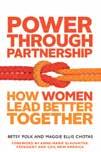
bp & mec We want partnership to be an accessible, viable solution for women to consider as they explore ways of working. In Lean In, Sheryl Sandberg implored women to step forward at work to make their voices and their presences known. We want partnership to be women’s Lean In solution. To do that, we need to shine the light on the female partner role models that are out there and the benefits they are achieving: the freedom to bring their full selves to work; the flexibility to balance work and life; the steady support that comes from working with a trusted ally; the confidence that stems from that support; and the happiness that results from it all.
ws What should women who want to build a successful trust-based professional relationship do?


bp & mec Find a partner! Potential partners are everywhere – she might be your best friend from childhood or a colleague at work, someone you’ve known your whole life or someone you haven’t even met yet. What matters is that you are equally prepared to share the heavy lifting it takes to make a partnership succeed.•
Rob-Jan de Jong Anticipate [AMACOM, 288pp, $27.95]
Business schools, leadership gurus and strategy guides agree – leaders must have a vision. But the sad truth is that most don’t...or at least not one that compels, inspires and energizes their people. How can something so essential be practiced so little in real life? Vision may sound like a rare quality – unattainable by all but a select few – but nothing could be further from the truth.
ws What stops leaders from developing a vision?
rd The value of a vision has depreciated. Some even make a mockery out of it, considering it something for dreamers and idealists, not for hard-nosed, results-oriented realists. So “vision” has developed an image problem. For a “vision” to become something powerful, it needs to be emotionally engaging: people need to feel something in order to persuade them. And it needs to be credible and authentic, which implies people need to see it back in how the leader behaves.
ws Do you think the ability to inspire people at work is a rare quality? If so, why?
rd It often seems more the exception than the rule. Most people focus on their managerial responsibilities of getting the immediate work done in an efficient way. That’s important, no doubt, but if you aspire to lead, you’ll want to go beyond merely managing the day job. Your people will eventually expect you to provide meaning to their efforts.
ws How can people expand their visionary capacity?
rd First, with content. You need refreshing ideas to form a powerful vision, and this requires that you learn to tap in to your imagination. Second, there are practices to integrate into your day-to-day to continuously nurture your visionary capacity. Third, self-awareness is key. You should be clear on what you stand for, what values you live by, and how you enact those things in your day-to-day leadership behavior. And lastly, you will need to work on how you communicate your vision most powerfully.
ws What are the key skills in anticipating changes?
rd There are two skills: the ability to see change early and to connect the dots. Visionaries are in tune with what’s happening at the edge of their industries and responsibly integrate the early insights into a more coherent perspective. Obviously, since we’re dealing with the future, we can never have a guarantee to get it right, but we can in a significant way increase our chances.
76 Work Style — #14.14 Work Style — #14.14 77
Betsy Polk & Maggie Ellis Chotas
Jane
Mike Roarty & Kathy Toogood
BooKS for work
oUR CHoICE for Work
Last King of Scotland01
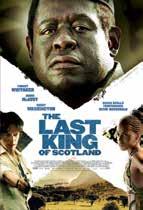
A Beautiful Mind02
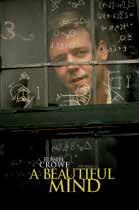
The Business Model Navigator

[Pearson, 360pp, $33.86]
Ninety percent of the world’s strongest business innovations spring from just 55 different business models – and here they are in one book. A strong business model is the key to business success and winning innovations. Based on groundbreaking original research, this book shares these 55 recipes for success, providing practical templates to help readers build new business models from scratch and supercharge their existing models.
Philip Webb
Leading Constant Change [Pearson, 300pp, $42.19]

Leading Constant Change provides a clear 15-step framework for managing change. Engage teams and stakeholders, map the change strategy, implement a change plan and deliver results fast. Leading Constant Change shows managers how to plan, share and execute change. It contains practical advice and is illustrated with case studies from companies who have effectively used the framework
Graham Shaw
The Art of Business Communication [Pearson, 224pp, $25.31]

It is well recognized that people remember more of what they see than what they hear. The Art of Business
Communication is a highly visual and entertaining guide that brings life to a subject routinely considered dry and dull. In these pages, professionals will find interesting, fresh and memorable ways to improve the effectiveness and stickiness of their messages, documents and meetings.
White Boards That Excel
[Berrett-Koehler, 288pp, $34.95]
Author B. Joseph White – a successful corporate executive, a veteran of many boards and a distinguished academic –argues that boards enable organizations to excel only when directors go beyond their standard duties of oversight and monitoring management. Directors, he says, must set high aspirations, serve as stewards who know the organization in all its dimensions, and make decisions that create value for all stakeholdersowners, employees, customers and society.

The Discomfort Zone

[Berrett-Koheler, 192pp, $22.95]
Leaders, managers and coaches are charged with getting people to stretch their limits but are often unsuccessful.
Top leadership coach Marcia Reynolds says the problem is that, when incorrectly handled, difficult conversations create more resistance than growth.
Reynolds offers a model and methods for discovering what to say so people change their own minds.
Susan Fowler
Laura Stack
Steve Arneson
Shantaram by Gregory David Roberts
Vintage Peugeot racing bike and two vintage Bollywood posters
KLM Hotel Kura Hulanda, Curacao
Alice’s Adventures in Wonderland by Lewis Carroll
12 Years a Slave by Steve McQueen
The Door of Everything by Ruby Nelson
Before Midnight – the last part of Linklater's trilogy. Beautifully real dialogue03

The Four Agreements by Don Miguel Ruiz – a classic for interpersonal relationships
Watches (Tissot) and jewelry (Tiffany)
Emirates and Russian airline Transaero
Breakers Hotel in Palm Beach
My 1916 Ford Model T Touring
Delta Stella Maris Punta Chiappa Marine Reserve at Camogli, Italy
Guitalele (cross between a guitar and a ukelele), Yamaha
British Airways Sheraton, Brussels –swimming pool on top floor
Vegetarian mezzes at Gokyuzu on Green Lanes (aka London’s “Little Istanbul”)
An experience – theater, restaurant, gallery, little trip away Sri Lanka
Uilliam’s Restaurant and Pushkin in Moscow
Scarves, Gucci and Salvatore Ferragamo accessories
South Florida or Dubai in the United Arab Emirates
Plant – A restaurant with roots (Vegan), 165 Merrimon Avenue Asheville, NC 28801
The Nomadic Creations by me
Tulum, Mexico
Le Maharajah, Besançon – simple and tasty, friendly service
Write a dedicated song US, west coast road trip (California, Nevada, Arizona)
Why
Motivating People Doesn’t Work…and What Does
[Berrett-Koheler, 216pp, $29.95]
Motivating people is frustrating for everyone involved, and it just doesn’t work. You can’t motivate people – they are already motivated but generally in superficial and short-term ways. Applying recent, often surprising, psychological discoveries, Fowler lays out a tested model and course of action that will help leaders guide their people toward motivation.
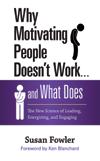
Execution is the Strategy [Berrett-Koheler, 240pp, $19.95]

Laura Stack’s breakthrough is to show leaders how execution – think of it as organizational productivity – can drive strategy, rather than the other way around. Using her L-E-A-D Formula™ to leverage resources, create supportive environments, align operations with strategic priorities, and drive forward quickly, leaders can work with their people to adjust strategies in real time and get things done.
What Your Boss Really Wants From You
[Berrett-Koheler, 112pp, $15.95]
This book offers a concise, practical guide to improving the most important work relationship. It uses fifteen straightforward questions to help employees uncover what drives a boss and use what they learn to take charge of the relationship. In addition, it features real-world examples of people who have used these techniques to improve their relationships with even the most difficult bosses.

Sicilian Nero d’Avola or Montepulciano Producer Ca’Botta
Martin Ray Merlot Oak Knoll Reserve, 201105

Pouilly-Fuissé (Burgundy white) 04
* for one’s spouse or significant other

78 Work Style — #14.14 Work Style — #14.14 79
Oliver Gassmann, Karolin Frankenberger & Michaela Csik
Marcia Reynolds
B. Joseph
Dinner
Wine
05
Anything fizzy Movie Book Object Airline Hotel
Gift* Vacation
Alice Anna Kenneth Luke 01 04
02 03
Alice McCool — Communication officer at Transparency International UK, Anna Guschina — Business trainer at Awara Eduhouse Training, Kenneth Bridger — Artist, sculptor and creator of the Nomadic Adornations jewelry line, Luke Archer — Director of coaching company Betterflyfrance and TED speaker
faSHIoN for Work
Opticals Are the New Black
Wood? Carbon? Acetate? Plastic? Glasses can be made in a variety of materials, which means that they can also have very different production cycles.

THE PRODUCTION
Mark Truss, sales director at Norville Group, explains: “The process is long. It takes around 9 months from the initial concept to deliver a product.” Norville Group works with brands such as Barbour. They receive a design brief that is discussed internally to come up with designs that are “…both appropriate and functional,” says Truss. Once the design is agreed, it is presented to Barbour, where the team will chip in and eventually sign off. “We then pass it over for pre-production samples, which are all handmade prototypes,” concludes Truss. The process is completed when agreed samples go into production. Quality checks are also extensively run throughout the process. The brand Oi, licensee for Borsalino, concentrates its production entirely in Italy. Piera Salvador, product manager, explains: “From design to manufacture, everything is done in Italy,” and adds, “The most striking aspect is the numbering of each pair to guarantee total traceabil-
ity; from the beginning of production to the user.” All of Borsalino’s eyewear is made using state-of-the-art machinery, and all components are then hand finished. The brand Esprit operates under the Charmant Group, and as for all of its brands the group keeps an attentive eye on their entire production process, which goes hand in hand with its sales and marketing process. It all starts with planning the right product through extensive research and development.
“Then once that’s done,” explains Elena Celeghini, brand manager, Esprit, “we move to the design phase, followed by prototype testing.” When the product is tested and working, the actual production starts.
MODERNIZING THE TRADITION
The fashion world’s fascination with all things vintage has been fun and interesting to watch; however, there are legendary companies that have always made their glasses the "old-fashioned way," staying true to their values, and creating timeless classics that remain in demand, regardless of current trends. Jessica Penzari, PR manager, MOSCOT, claims, “All of our frames contain the same DNA: authentic, riveted hinges,
01
01 JOHN VARVATOS, MODEL V201BLA53 02 TIMBERLAND, MODEL TB1289 049 03 BAUMVISION, MODEL ARISTOTLE
Italian-made acetate, and quality glass or gradient lenses.” MOSCOT is known for its Caliber Green-Glass Lenses, which are quite scarce today in the eyewear industry. In fact, as Penzari asserts, “We choose not to stray from the quality design and hardware construction of the past that we feel has best stood the test of time.” The design of all MOSCOT frames is done in their studio in NYC. Penzari explains, “We start our design process with paper and pencil, and several design meetings later we create a digital interpretation.” She adds: “At that point, we take a look at our acetate wall (an old-fashioned peg board filled with color swatches) and start putting together a color palette. We pay close attention to the cohesion of a collection, making sure the shapes and colors speak the MOSCOT language. Next we begin the prototype and handcrafted production/manufacturing process, which can take up to six months. And finally, we have our lab professionals in NYC test the durability and strength of our frames through a variety of familysecret tests and techniques.”
INNOVATING TAKES TIME
are tested. Trends in pattern and color are closely studied to stay relevant to demand. We narrow each frame down to four color choices for the final selection.”
At the Italian eyewear giant Marcolin, production areas include metal frame manufacturing, acetate frame manufacturing, and finishing. These process steps are carried out using automated machines with numeric controls, fiveaxle machines for the milling of acetate fronts, and semi-automated machines, as well as fully manual processes and operations where the operator’s knowhow is the key factor. The team at Marcolin explains, “Eyewear manufacturing requires a large number of manual operations, for example the soldering of metal details, the circles in which the lenses are mounted, the nose pad arms and the temples.
“In manufacturing acetate frames, the decorations are applied using special presses built in our workshops by skilled operators. The temples and fronts are processed and assembled by hand using abrasive fabric to obtain perfect couplings between metal and acetate.”
NEW TRENDS
Thanks
We at Work Style want to thank all the brands that have taken part in the article:
• Argyle Culture argyleculture.com
• Barbour barbour.com
• Baumvision baumvision.com
• Borsalino borsalino.com
• Carrera carreraworld.com
• Cartier cartier.it
• Cazal cazal-eyewear.com

• Diesel diesel.com
• D Squared 2 dsquared2.com
• Esprit esprit.com
• Evatik evatik.com
• Face à Face faceaface-paris.com
• Guess Eyewear guess.com
• Italia Independent italiaindependent.com
• John Varvatos johnvarvatos.com
• L.G.R. lgrworld.com
• Linda Farrow lindafarrow.com
• Montblanc montblanc.com
Our Choice Work Style Selection
We researched producers and designers of men’s opticals. We then selected 33 brands. Our jury, including fashion aficionados, managers and professionals, voted on models from the final 33 brands to elect our top 3. The jury was composed of Nadir Sinis finance manager, Edelman, London (UK) • Dom Bailey creative director, Baxter & Bailey, London (UK) • Matthew Seminara, lawyer, Epstein Becker & Green, New York (USA) •
Gary Prell, vice president, Centerplate, San Francisco (USA) • Filippo De Bortoli, freelance consultant and journalist, Milan (Italy) • Ana Weber, founder, 360° of Success, Orange County (USA) • Valeria Querini, UX designer, Iconmobile, Berlin (Germany) • Jennifer Loftus, owner, Astron Solutions, New York (USA) • Karolina Nurkowska PR specialist, ENNBOW, Warsaw (Poland) • Manuela Heinzel marketing localization manager, UFUUD, Milan (Italy) [W barbour.com borsalino.com brands-oi.biz charmant.com esprit.com iwantproof.com lgr-sunglasses.com moscot.com norville.co.uk treespectacles.com]
In the Italian company Tree Spectacles, the production cycle consists of three phases: bonding (the assembly of wood and carbon), milling and polishing, as described by the CEO, Marco Barp. The production cycle at Ogi is labor-intensive. Katy Verbrugge, graphic designer, Ogi Eyewear, asserts: “It takes many months for a frame to be produced. It starts with a hand-drawn sketch on graph paper, which is developed into a technical drawing on the computer to confirm size, shape and other special features. From that technical drawing a prototype is created and sample colors
According to Vierra Reid, marketing manager, Proof Eyewear: “Wood prescription frames are making a huge push right now into the optical industry, and the trends going into next season have a classy but edgy feel. Everyone wants to stand out without being obnoxious, so next season will consist of bold colors and thicker frames.” Colors truly seem to be the new trend for opticals, as Penzari confirms: “We see a lot of playfulness and color in the coming months. For example, MOSCOT has been exploring with jewel-tone colors, different material combinations, and
• Moscot moscot.com
• Mykita mykita.com
• Ogi ogieyewear.com

• Oxydo oxydo.net
• Polaroid polaroid.com
• Proof Eyewear iwantproof.com
• Safilo safilo.com
• Timberland timberland.it
• Tod’s tods.com
• Tom Ford tomford.com
• Tree Spectacles treespectacles.com
• Web Eyewear it.marcolin.com
• Marcolin marcolin.com
• WooDone woodone.it
80 Work Style — #14.14 Work Style — #14.14 81
The production of eyewear, the trends, the designs and the choice – some ideas for professional men who want to make a statement with their specs.
oUR ToP 3
02 03
2 5
3 6
other fun wearable fashion statements for Fall 2014.” Darren Dela Cruz, creative director, Leisure Society by Shane Baum, says: “We see the industry moving toward thinner silhouettes and lightweight materials with classically inspired shapes that are enhanced through modern manufacturing methods using materials like hollowed titanium. We also see combination frames becoming more common, acetate-metal combos will inherently have a twotone effect, which leads to more acceptance of multicolor frames.” Alexis Nyro, product manager, Evatik, thinks that round shapes as well as modified rectangular shapes are what we’ll see trending next season. He says: “Profiles are becoming thinner and less clunky, and men are also becoming more daring with their color choices.”
MEN WANT TO LOOK GOOD TOO Today’s look for men is clean and contemporary. Also, mirrored lenses are very popular right now, and that trend will continue. Nicolas Roseillier, creative director, Rem Eyewear, says: “I also believe that fashion is a continuity of reverting the past into the present –what goes around comes around – and most styles or trends come full circle,” and adds, “One trend that’s come full
circle is 90s eyewear silhouettes. They’re very much in style now, and probably will continue to be.” For the optical customer of brands such as Barbour, classic styling is essential. Truss explains: “Not geek chic, but tailored and styled. Colors are gunmetals, hues of mixed tortoiseshell, with discreet branding on either temple or inner lug.”
GOOD AND BAD
Quality is a very important asset in a pair of glasses and doesn’t necessarily translate into an expensive product. In the field of eyewear, quality is a key element – especially for the technical features of the lenses – and the materials used for realizing the frame have to be long lasting and light, guaranteeing comfort at the same time. There are also health and safety standards to maintain. Frames should enhance facial features in the same way a picture frame does a piece of art. It’s both a functional and fashionable decision, so fit is just as important as looks. “If the consumer doesn’t know what ‘look’ they are trying to achieve, the need for an experienced optician becomes more important as they will need to fill the role of the stylist to make sure the right shapes complement their facial features. When one of these factors isn’t considered, the

chance of a poor result becomes more likely,” explains Dela Cruz. Along the same lines, Reid says: “One can distinguish the quality of a pair of specs by the way the frame fits on the face. If it feels unstable, it is a poor model. The frame should be unnoticeable to the person wearing them while standing out to everyone passing by.”
ALWAYS GO FOR QUALITY
Both legendary and newer companies strive for quality in both the choice of material and production technology, Barp confirms: “We’ve always wanted to create a pair of glasses that was totally lightweight – this is why we chose wood – but we wanted to raise the quality level of the collections of wood spectacles that were on the market at the time so we developed a frame made out of wood and carbon fiber, which we have patented.” Great frames must also mean quality and feel, as Verbrugge asserts: “The hinges are not loose and provide a nice smooth movement when the temples are opened and closed. The finish on a quality handmade frame is polished and has a smooth texture.” Other key factors to distinguish a great pair of glasses are material and durability. Nyro says: “As people keep their eyewear for a few years, they need a pair of good qual-
Eyeglasses Become Symbols




His work famous eyeglasses is a project he did for fun. It is a minimalist collection. Mauro’s clean, simple designs include the trademark lenses of people such as Woody Allen, Harry Potter, Steve Jobs and Malcom X.





Federico Mauro is an Italian multimedia designer and art director born in 1980 in Avellino, in the South of Italy. He has worked with Fandango, Universal Pictures Italy, Warner Bros Italy, Nanni Moretti and Ferzan Ozpetek among others. He has won several awards both nationally and internationally.
All images are by and courtesy of Federico Mauro.
ity spectacles that will last.” Anyone can tell a good optical frame from a poor one by taking a close look at its appearance, Roseillier asserts: “Examine it for smooth surfaces and transitions, clean solder and welding points, and polishing around the hinges; not to mention the obvious – fit and feel.”
PICKING THE RIGHT PAIR

People choose their style of glasses for a myriad of reasons including personal fashion preferences, favoring a certain look or aesthetic, outside influences such as fashion trends, or how they believe they are perceived, or want to be perceived, by others. Penzari explains: “For instance, a person may wear a bolder frame because they want to make a fashion statement and draw attention to their accessories; on the other hand, some people are looking for something that whispers and subtly disappears on the face. There is no simple formula.”
Reid agrees, saying: “The choice varies quite a bit from one man to the next, but generally they like to be fashionably acceptable while maintaining functionality; this is why comfort paired with a crisp look does wonders in today's market.” She adds: “Men want to communicate that they have good taste in the eye-
wear they choose; it should complement their facial features without taking all the attention away from the man himself.” Men tend to be a bit more subtle than women when selecting their glasses as they normally don’t purchase many pairs to accessorize with. “Brand names don’t seem to matter
as much as the quality and feel of the product. Everyday wearability is important, plus the longevity of the look you are going for. Your glasses sit on your face so they are your first style statement. They should be an extension of what you want to portray – whether that be intellectual, playful or glamorous,” says Dela Cruz. According to Verbrugge, there are two kinds of men: “One is more subtle with his selection, choosing classic, darker colors with more versatile, simple shapes. The other tends to be more adventurous and wild, and is open to more stand-out thicker frames in bold colors and patterns.” According to Roseillier, men tend to be very invested in materials, so for eyewear that means quality and artisanship. He adds: “Men also value fit, comfort and feel during our decision-making process. And ultimately we choose eyewear that complements our look and personality.”
SOMETIMES BRAND LOSES OVER FIT AND FEEL
Some people prefer to invest their money buying high-quality, well-made and branded eyewear for both functional and aspirational characteristics; for this the brand name is a kind of guarantee. When buyers purchase a product they enter into the brand values’ universe. It’s like selling a lifestyle. Other people, however, are definitely value-formoney oriented and don’t care about quality or brand values; they’re only interested in saving money, buying something that, in style, is similar to what has been created by the trend-setter brands. Nowadays different and opposite consumer behaviors coexist and are the reason that it’s very important for a company to analyze the markets, offer the right product for the specific target group, and have a wide portfolio that can meet different consumers’ needs.•
82 Work Style — #14.14 Work Style — #14.14 83
We take a look inside the manufacturing plant of Marcolin in Northeast Italy.1 Works on pad arms, bridge and nose pads are entirely handmade.
2 The pad arms receive final touches. These are very important parts in eyeglasses as they are those parts who risk to create discomfort.
3 The hinges are placed in the corners of the front frames. After this phase, the first part of the temples are placed on the hinges and connected to the frame.
4 The first part of the temples is fixed on the hinges. 5 The frame rims where the lenses will be placed are carved by hand.
1
6Final decorations are applied to the glasses by hand. All photos are courtesy of Marcolin.
4
[W federicomauro.eu]
Work
faSHIoN for
Analytics Training Performance Recruitment Technology







01 Amsterdam, The Netherlands. 3 – 4 March 2015 02 Bangalore, India. 12 – 13 December 2014 03 Birmingham, UK. 3 – 4 February 2015 04 Brazil, TBD. 18 – 20 March, 2015 05 Dallas, TX, USA. 23 – 25 February 2015
06 Frankfurt, Germany. 29 – 30 January 2015 07 Hermanus, South Africa. 12 – 14 May 2015 08 Lake Buena Vista, FL, USA. 11 – 13 February 2015


09 Las Vegas, NV, USA. 16 – 18 March 2015

10 London, UK. 25 – 26 February 2015
11 London, UK. 20 May 2015 12 Manchester, UK. 12 February 2015 13 Minneapolis, MN, USA. 18 - 20 May 2015 14 Oakland, CA, USA. 2 – 5 March 2015 15 Orlando, FL, USA. 31 March – 2 April 2015 16 Ottawa, ON, Canada. 9 – 10 December 2014 17 Pasadena, CA, USA. February 2015 18 Pasadena, Ca, USA. February 2015 19 Scottsdale, AZ, USA. 16 – 19 March 2015 20 St. Louis, MO, USA. 19 – 21 February 2015 21 Tampa, FL, USA. 26 – 28 April 2015 22 Washington, DC, USA. 23 – 25 March 2015
West Palm Beach, FL, USA. 4 – 5 March 2015
84 Work Style — #14.14 Work Style — #14.14 85
TalentManagement Future Leadership Behavior Compliance Compensation Engagement Diversity
23
Planning 18 14 20 13 16 01 11 06 12 03 10 17 09 19 05 08 15 21 04 07 02 22 23 SAVE THE DATE for Upcoming iQpc ExchangEs Maria ElEna Sanz Head of Sustainability & People Compañía de Acero del Pacífico (CAP) Claudio MEndonça SantoS VP Human Resources Grupo andrade Gutierrez Brad SaMarGya Chief Learning Officer Ericsson rita GonçalvES Head of Human Resources Latin America Genzyme, a Sanofi Company aMEriCo GarBuio VP Human Development and Organization Brazil Kirin KatE day VP, Workforce Enablement Global Technology & Operations Metlife, inc. danthE ESCaMilla HR Director Grupo Elektra GuStavo ManCanarES Head of HR Grupo Baumgart KEE MEnG yEo Chief Learning Officer amway fEbrUary 11-13, 2015 | orlando, florida, Usa www.HrlEADErSl ATinA mEric A.com m arch 18-20, 2015 | brazil www.HrlEADErSbrAzil.com april 26-28, 2015 | Tampa, fl www.cHiEflEArningofficErExcHAngE.com HR Events: 2015, first 6 months
HR EVENTS for Work
a half years at JP Morgan where he held a series of HR roles of increasing responsibility.
Milan’s ideas:
• HR professionals should be leaders and leaders should be teachers
• HR business partners should focus on process improvement, and should always wonder what is the best position for a new manager
• HR should look for trends in exit interviews, throughout questions to new joiners and to employees
[W moodys.com]
Where: Istanbul, Turkey
What: Talent in Emerging & Growth Markets
When: 4 – 5 June 2014
Who: Tucana Global Web: tucana-global.com
REPoRT
Where: Vienna, Austria
What: HR Minds Forum 2014
When: 15 – 16 May 2014
Who: GLC
Web: globalleadingconferences.com
Taking training into the 21st Century
Maria Schoenauer is the HR director at Xerox. At the conference she spoke with icrunchdata about the changes in Xerox’s recruiting process, how they’ve adapted with the rapid increase of social and mobile, and what recruiting tools that she can’t live without.
Her keynote speech focused on:
• Workforce owns responsibility for development
• Development is continuous and work driven
• Focus is on enabling high performance by integrating learning with work
Maria’s ideas:
• Build practice of workforce knowledge-sharing
• Cultivate workforce engagement – individual ownership for learning
• Reduce time out of the field for learning
• Drive global workforce capability
• Deliver higher quality and lower cost learning solutions
• Enable mobility, mobile access to content
[W xerox.com]
Where: Luxembourg, Luxembourg
What: HR Factory
When: 3 June 2014
Who: Farvest Web: farvest.com
Balancing Operational Vs Strategic Workloads and Demand
Milan Makwana leads human resources in Europe, the Middle East and Africa (EMEA) for Moody’s Corporation. Prior to joining Moody’s, Milan spent twelve and
Managing Workplace Diversity and Culture Transformation in Emerging and Growth Markets
Rajesh heads the human resources and communications function for ING Investment Management
India. With over 19 years of intense HR leadership experience in managing matrix organizational structures, cross-cultural staff and driving innovative best practices in India and the Asia Pacific region, Rajesh is known for his passion for people engagement.
The challenges in understanding workplace diversity:
•Intercontinental working culture diversity in a global multinational company
•The need to manage employees across different countries
•The need to managie international workers
Overcoming those challenges:
• Referred to the employee engagement model: say (employees will speak positively of the company), stay (employees wish to remain in the organization), strive (employees will go the extra mile)
• Keep in consideration the questions that could affect engagement
• Adopt engagement drivers that the best global employers implement such as caring, fun at work, integrity, collaboration, innovation and recognition
• Align the engagement drivers with core people practices such as listening, speaking, inspiring, developing, thanking, celebrating and sharing
• Shift power to employees, so that teams and employees feel empowered and an important part of the organization and its decision making
[W ingim.com]
Where: Brussels, Belgium
What: People Innovation Europe 2014
When: 23 – 24 September 2014
Who: Stamford Global Web: peopleinnovationeurope.com
Challenges of Succession Management Planning in Europe: Empowering Talents Internally or Picking in the Global Talent Pool?
Kaisa Tuuliainen is an experienced people development professional. She has worked for Finnair for over ten years. Finnair is a legacy airline carrier in the middle of deep business transformation.
In the past four years her key responsibilities have reflected the versatile world of people development: i.e. talent management, leadership and strategic competence development, change management support for MWB projects, recruitment, succession planning and wellbeing.
Her keynote speech focused on:
• Smart long term resource planning to support sustainable growth
• Focusing on leadership development as a key factor of a successful succession strategy
• Visiting the cost-effectiveness of internal training and promotion vs. recruitment strategies
Here a few ideas from Kaisa:
• Build bench strength – support strategic resource planning and successor planning for key positions
• Build stronger talent pipeline – ensure career opportunities, job rotation and development action
• Create a performance-driven culture
• Identify and develop future potential and leadership talent
• Place the right people in the right jobs at the right time
• Create a consistent message around Finnair talent management
[W finnair.com]
Where: London, UK
What: HR Change & Transformation When: 15 – 16 October 2014 Who: Tucana Global Web: tucana-global.com
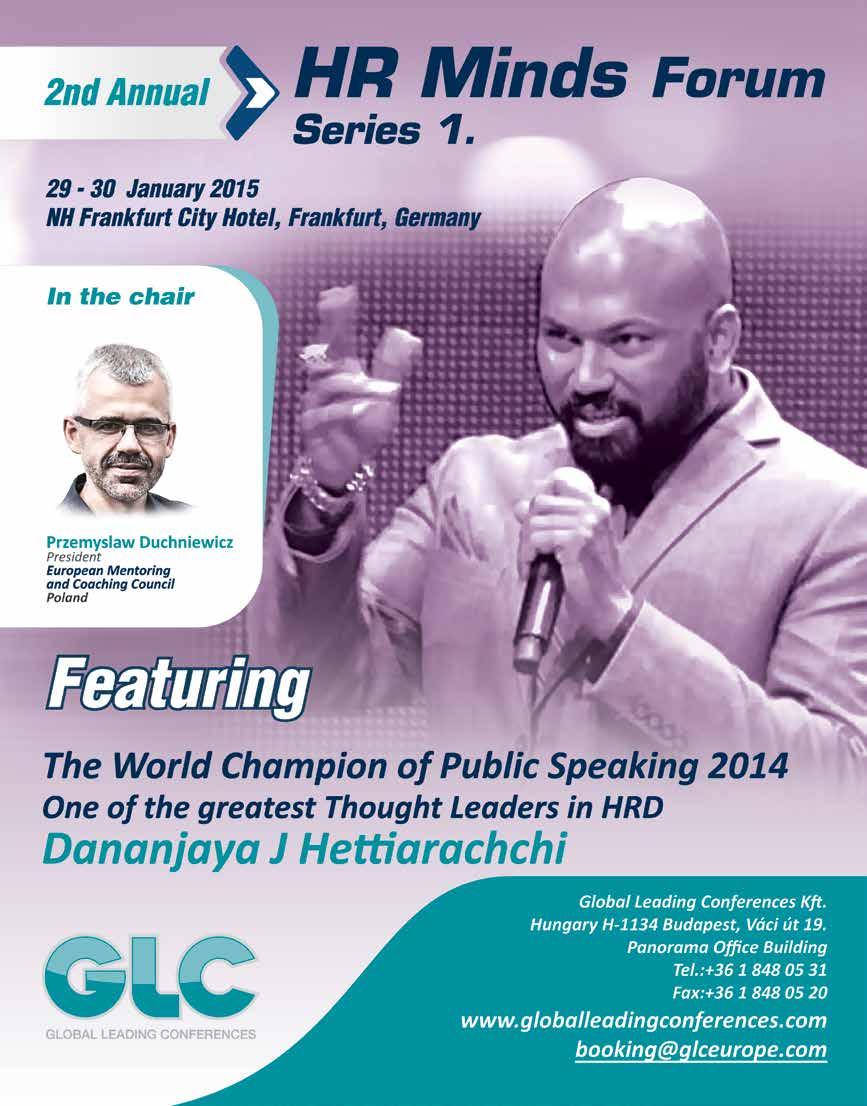
Building a Connected HR, and Making it Work for All Our Employees
Stephan Münch is vice president for HR transformation management for Deutsche Post DHL, responsible for the roll-out of the HR strategy to more than 5,000 HR employees in over 100 countries. He was previously partner and head of global in-house consulting practice, supervising lean improvement programs, where he achieved a number of great results, including 29% productivity gains in European warehouses and 13% in back offices. He previously spent 4 years leading the APAC office in Singapore.
The challenge DHL faced:
• Managing 5,000 HR employees spread across different HR organizations reporting into different corporate board members saw the need to increase collaboration
How DHL faced the challenges:
• Create a more connected HR
• Increased effectiveness of HR through intensified cross-divisional collaboration
• Used synergies of existent HR units
• Developed an internal social media platform and communication for over 450,000 employees
86 Work Style — #14.14
aGENDa 2014/2015
What we obtained:
• Saved 40 million euros by year end 2014
• Created a culture of collaboration on a global scale
[W dpdhl.com]
Where: Amsterdam, The Netherlands
What: HR TECH EUROPE
When: 23 – 24 October 2014
Who: HRN Europe Web: hrtecheurope.com
Using Technology To Transform the Health, Wealth and Wellbeing of Your Employees
Since Charline joined Danone in 1997, she has held ten different roles, in both human resources and communications, at the French head office and then in the UK. In April 2014 she became HR Director of DanTrade based in the Netherlands, a brand-new Danone company that provides its services to all 4 divisions in Danone, where she also has group responsibility for the overall SSD function. Prior to joining Danone, Charline was relocation manager at Europ Assistance.
Her keynote speech focused on:
• How technology can help companies reach their ambitions through a shared services model
The challenges Charline faced in her company were:
• The need to attract and retain talent for longer
• Danone employer brand wasn’t widely known
• High engagement, yet a high employee turnover

What Charline did and wants to share:
• Choose a partner to help deliver your vision
• Adopt themed branding across the diverse range of online and offline media in line with your ambitions (Danone’s ambition was to become a great place to grow, which made them go for a garden-themed branding)
• Choose a representative "face" of the scheme (Danone’s was Norman the Gnome)
• Create a viral campaign where employees share photos of the face and create games (Norman the Gnome was once kidnapped and a ransom demanded)
Danone won in two ways, both in engagement and in retention. Here’s some data:
• Employees rated their reward scheme 24.6% higher than before
• 7% more employees felt that they mattered in the company and management was interested in them
• 67% of vacancies were filled internally, showing people wanted to stay
• On average staff turnover in UK companies is 2 years, in Danone it increased to 5 years
[W danone.com
UPCoMING EVENTS
Where: Ottawa, ON, Canada
What: Public Sector Transformation 2014
When: 9 – 10 December 2014
Who: The Conference Board Canada Web: conferenceboard.ca
This event attracts leaders from all levels of government, to connect with public sector change experts and their peers, and learn from insightful examples and informative case studies.
This ensures the agenda addresses the public sector’s specific change management needs.
Where: Bangalore, India
What: Bangalore HR Summit 2014 When: 12 – 13 December 2014
Who: HR Summit India Web: hrsummit.in
At this event over 200 HR professionals from India, Asia Pacific, Africa and the Middle East are expected to participate and deliberate on the theme of Strategic HR and Business Performance. HR has over the years changed according to the needs and requirements of the organization. Seen decades ago as an admin function and now as a business function it’s important to consider how HR will be positioned in the future. How will various HR functions work towards fulfilling the business goals of an organization.
Where: Frankfurt, Germany
What: 2nd Annual HR Minds Forum When: 29 – 30 January 2015 Who: GLC Web: globalleadingconferences.com
Facing many obstacles in all business areas, HR also faces its own demands to work out how to cope with today’s fast-paced environment. At this forum, we will unearth the answers for all recruitment, training and organizational development challenges among a wide range of other innovative subjects such as Generation Y, Neuroscientific HR Approach, Social Media Usage, Gamification, Women in Leadership and Incentivizing.
Where: Pasadena, CA, USA
What: Training & Development Summit When: February 2015 Who: Forum Events USA Web: forumevents.com
The Training & Development Summit is an event specifically designed for senior level training, learning and development professionals looking to source new and innovative solutions. Like all summits by this organizer, the meeting is tailored to meet organizations’ requirements.
Where: Pasadena, CA, USA
What: HR & Employee Benefits Summit
When: February 2015
Who: Forum Events USA Web: forumevents.com
The HR & Employee Benefits Summit is an event specifically designed for senior level HR and employee benefit professionals looking to source new and innovative solutions. Throughout the event you will have a series of one-on-one meetings with a whole variety of vendors that you choose to meet, as well as attending thought-provoking seminars. In addition there are many networking opportunities, including an icebreaker drink reception the night before the event.
Where: Manchester, UK What: Manchester HR Summit When: 12 February 2015 Who: Forum Events Web: forumevents.co.uk
The Manchester HR Summit is an event specifically for those senior HR executives and managers looking to find innovative, leading HR service and product suppliers. The event, focusing on the HR challenges that practictioners face on a day-to-day basis, aims to offer attendees an efficient and stress-free way to see what’s new in the industry and make profitable connections and partnerships.
Where: Birmingham, UK
What: 2015 HR Directors Summit When: 3 – 4 February 2015 Who: WTG Events Web: hrevent.com
This year’s theme is all about “Reshaping the present, reimagining the future” and we love nothing more than finding you the most inspiring projects and speakers. Tailor your learning experience from seven dedicated break-out tracks focusing on talent for tomorrow, organisational development and change, the art of engagement, future HR, inspiring great leadership and the future of work.
Where: Lake Buena Vista, FL, USA
What: HR Leaders Latin America Exchange When: 11 – 13 February 2015 Who: IQPC Web: hrleaderslatinamerica.com
The HR Leaders Latin America Exchange provides one of the most credible forums for HR leaders in the region to share ideas and the real-world solutions to many of the challenges that they are facing. The Exchange continues its ongoing tradition of offering cutting-edge, interactive and tailor-made learning opportunities for pre-qualified practitioners to gain actionable insights and stay ahead in this ever-changing environment.
Where: St. Louis, MO, USA
What: 2015 AHRD Conference in the Americas When: 19 – 21 February 2015 Who: AHRD Web: ahrd.org Conference participants will come together to engage in their own discovery and exploration of the frontiers of HRD. It will offer attendees the opportunity to move beyond traditional constraints and towards creativity and generativity.
Where: Dallas, Tx, USA
What: 2015 Workforce Planning and Talent Strategy Conference



When: 23 – 25 February 2015
Who: HCI Web: hci.org
The HCI Workforce Planning and Talent Strategy Conference is the industry leader in executing your business-driven people strategy in 2015 and beyond. In our seventh year, we are again connecting you with the smartest planners and most capable doers to actualize your strategic workforce plan.
88 Work Style — #14.14 Work Style — #14.14 89
Produced by 3 - 4 February 2015 | Birmingham, UK | hrevent.com
the Present, Reimagining the Future Speakers include: Lord John Browne Former CEO BP Dave
Business
Michigan
Chief
Royal
By attending the HR Directors Business Summit, you will gain invaluable insights to fuel your strategy and drive bottom-line HR success from 2015 with multi-streamed sessions in: • Talent for tomorrow • OD & Change management • The art of engagement • Future HR • Inspiring great leadership • Future of work • Showcase theatre - Award winners • Tech & Demo zone • Learning hub *The offer expires on 17.10.2014 and excludes current delegates, consultants and solution providers. Book your place at the HR Directors Summit for £795* (Usually £1495) hrevent.com/palgrave | #hrevent15 | +44 (0)20 7202 7690 | enquire@wtgevents.com
Reshaping
Ulrich Professor at the Ross School of
University of
Hugh Mitchell
Human Resources & Corporate Officer
Dutch Shell Dame Carol Black Expert Adviser on Health and Work Department of Health England
Where: London, UK
What: Engagement Innovation Summit 2015
When: 25 – 26 February 2015

Who: Syncota

Web: engagementinnovationsummit.com
The event is the product of a demand-driven HR engagement research and development which took into account research with 100+ senior HR professionals. This ensures all the content for the conference is relevant, innovative, and desirable. This event is aimed at expanding awareness of some of the modern strategies employed by the world’s biggest industry leaders such as Google, Mars, HP, Hertz and Barclays.
Where: Oakland, CA, USA
What: HR West 2015
When: 2 – 5 March 2015
Who: NCHRA Web: nchra.org
The conference aims at helping organizations and HR practictioners to hone their skills, build their network of resources with colleagues and discover practical solutions to real-time business challenges. Main speakers include Sarah Lewis, a faculty member of the Yale School of Art, Peter Schwartz, an innovator and author, and Alan Fine, founder and president of InsideOut Development.
Where: West Palm Beach, FL, USA
What: The World Leaders Conference
When: 4 – 5 March 2015
Who: World LEADERS Group Web: worldleadersconference.com
Designed to provide participants with a uniquely personal experience in an intimate setting, the World LEADERS Conference brings together top executives in business and ministry with prominent leadership experts from around the world. The two-day conference provides opportunities for interacting and networking with other business and church leaders, and focuses on the critical issues and trends that are shaping business and the church today.
Where: Amsterdam, The Netherlands
What: Workforce Analytics Summit

When: 3 – 4 March 2015
Who: Stamford Global Web: workforceanalyticssummit.com
The event brings together HR analytics experts, business leaders and sponsoring strategists with intelligence initiatives to address practical challenges on the development of a credible high-impact analytics functionality. Topics range from the role
of workforce analytics in organizational effectiveness to the challenges related to making "people management culture" perceptive to data.
Where: Las Vegas, NV, USA
What: National HR & Hospitality Conf. and Expo When: 16 – 18 March 2015
Who: HR in Hospitality Web: hrinhospitality.com


HR in Hospitality provides 100% hospitality-focused HR and legal guidance in sessions presented by senior HR executives in the industry or seasoned hospitality law attorneys.
In addition, HR in Hospitality hosts the only expo of its kind showcasing HR products and services for the hospitality industry. The expo isn’t just literature collecting and comparison shopping as it also offers attendees numerous opportunities to connect and share ideas with other industry professionals during dedicated networking events.
Where: Scottsdale, AZ, USA
What: The I4CP 2015 Conference When: 16 – 19 March 2015


Who: Institute for Corporate Productivity Web: i4cp.com

The conference addresses topics ranging from workforce analytics to leadership development and the business impact of diversity and inclusion. Every session delivers empirical research, thought-leader insights, and real-world examples of how highperformance organizations employ people practices that drive organizational strategy.
Where: TBD, Brazil
What: HR Leaders Exchange Brazil When: 18 – 20 March 2015
Who: IQPC Web: hrleadersbrazil.com
The 3rd edition brings new formats, and new innovative topics in HR. Discussions of the main challenges of HR and the strategies developed by leading companies follow one another, for "tailormade" advice and learning.
Where: Washington, DC, USA
What: Employment Law & Legislative Conference



When: 23 – 25 March 2015
Who: SHRM Web: shrm.org
The event will give attendees the information needed to understand the complex legal landscape that affects business. The conference sessions will focus on the new employment realities that organizations need to be aware of to prepare for the future.
Where: Orlando, FL, USA
What: 2015 Human Capital Summit


When: 31 March – 2 April 2015
Who: HCI Web: hci.org
The 2015 Human Capital Summit is focused on helping business partners and strategic HR executives increase both personal and organizational per-
formance. Through war-tested and successful case studies from senior-level practitioners, attendees will learn what drives workforce performance and agility, and how they can personally maximize their influence and leadership to achieve business goals.
Where: London, UK
What: European HR Inspired Conference When: 20 May 2015 Who: C/BEx Media Limited Web: hrinspired.co.uk
The Conference will see 200 senior heads and directors engage in an advanced workshop program to share knowledge from within their organizations and to solve problems by meeting leading service providers.
Where: Tampa, FL, USA
What: Chief Learning Officer Exchange When: 26 – 28 April 2015 Who: IQPC Web: chieflearningofficerexchange.com

It's no longer just about training. It's about enabling the workforce to compete and be productive in a new world of constant change precipitated by rapid globalization, economic interdependence and innovation in telecommunications. The themes of IQPC's 3rd annual Chief Learning Officer Exchange are built around the need to re-think and adapt L&D strategy to meet the business needs for skills.
Where: Hermanus, South Africa
What: CIO Summit When: 12 – 14 May 2015 Who: GDS International Web: gdsinternational.com
In an ever more rapidly changing landscape, become a technology differentiator for your organization, and securely deliver improved colleague and customer satisfaction. The event aims to solve key business challenges, in particular, the ability to network and learn from industry peers through essential business conversation.
Where: Minneapolis, MN, USA
What: WorldatWork Total Rewards Conference & Exhibition When: 18 - 20 May 2015
Who: WorldAtWork Web: worldatwork.org HR leaders’ responsibilities are expanding. Compensation, business strategies, communications, system administration. This event will provide the ideas, inspiration and innovation organizations need to succeed in a fast-moving, ever-changing environment. We have the solutions, strategies and connections companies are looking for.
90 Work Style — #14.14 Work Style — #14.14 91
EVENTS
Work HR ONE GALA 27 NOVEMBER 2014 HR FACTORY 11 JUNE 2015 LUXEMBOURG HR AWARDS THEMATIC BREAKFASTS CREATED IN 2002 MORE THAN 6000 HR PROFESSIONAL SUSCRIBERS 2014 DOUGLAS BAILLIE Chief Human Resources Officer, Unilever 2013 THOMAS EDIG dep. Chairman of the Executive Board, Member of the Executive Board Human Resources, Porsche 2012 DOROTHÉE BURKEL People Operations Director, Southern, Eastern Europe, Middle East and Africa, Google 2012 CAROLE WAINAINA Executive Vice President, Chief HR Officer and Member of the Executive Committee, Philips 2014 MILAN MAKWANA Managing Director, Human Resources, Moody’sCorporation 2014 STEFANO MASTROGIACOMO Management Researcher Faculty of Business and Economics HEC 2013 CYRIL BARTH Director, Saint-Cyr Foundation 2013 DAVIDE SOLA Professor of Strategy & Management, ESCP Europe WE WERE THERE! WE WERE THERE! VISIT OUR NEW WEBSITE ! GALA.HRONE.LU WWW.HRFACTORY.LU NEW! HR COMMUNITY LUXEMBOURG
HR
for
Manchester HR Summit is a platform for HR Managers and Directors to source new solution providers, network with fellow peers and attend complimentary on-trend seminars held by industry experts. Being held next February, HR professionals are able to gain essential industry knowledge and valuable contacts that will provide them with endless benefits for future HR development. “ ” A great event to see several new suppliers & network with other HR professionals under one roof LateRooms “ ” Excellent event, great opportunity to network and meet suppliers in a brilliantly organised event Daisy Communications






Media Partner:

















12th February 2015
The Midland, Manchester
@ManchesterHR




fooD for work
Lunchbox Cooking Test 2014
Four temerarious lawyers test their culinary abilities with these recipes by chef Moreno Cedroni, who holds two Michelin stars.

Four recipes created by Moreno Cedroni exclusively for Work Style, interpreted by four business lawyers.

1FISH SOUP WITH STAR ANISE SCENTS
2WHITE SEA LASAGNA
3OCTOPUS WITH GREEN SALSA AND BOILED VEG ETABLES IN TOMATO WATER
4MINESTRONE SOUP WITH PANSIES
THE CHALLENGE
To create a healthy packed lunch in a matter of minutes at home to enjoy later at the office.
MORENO CEDRONI an Italian chef who holds two Michelin stars, has brought an avant-garde spirit to Italian cuisine. Born in Ancona in 1964, he opened his first restaurant, La Madonnina del Pescatore (regarded as one of the top 10 fish restaurants in Europe) in Senigallia, when he was only 20 years old.•
EMANUELE. THE CHALLENGE. Cooking the fish soup with star anise scents. Emanuele Padilarco consults in banking and financial intermediaries law. After graduating in Law from the University of Pavia in 2003, he earned a doctorate in Comparative Public Law in 2006 from the University of Siena. He became a member of the Milan bar in 2006. He is the author of numerous publications in the field of banking and finance law.
PIERANTONIO. THE CHALLENGE. Cooking white sea lasagna, parsley sauce and grated lime. Pierantonio Musso focuses on commercial, corporate and insolvency law. He’s an expert in restructuring, reorganization and turnaround matters including restructuring of capital structures, reorganization plans, composition with creditors, distressed M&A, DIP finance and illiquid assets trading.
He’s currently working at Lombardi Molinari Segni. He has been a member of the Milan bar since 2006.
SILVA. THE CHALLENGE. Cooking the octopus with green salsa and boiled vegetables in tomato water. Silva Annovazzi has extensive experience in corporate governance regulations and measures relating to anti-money laundering, as well as data protection and anti-corruption programs, with reference to American and British jurisdictions. She graduated in Law in 1997, and then took a master’s degree at LL.M. Boston University School of Law in 1999 and finally a Renato Treves International Doctorate in Law and Society in 2009.
Supported by:
01

She’s been a member of the Milan bar since 2003.
SILVIA. THE CHALLENGE. Cooking the minestrone soup with pansies. Silvia Beccio deals with banking and financial law, with particular attention to project operations and acquisition finance. She’s starting to gain experience in the field of corporate law. Silvia graduated from Bocconi University and has been visiting research fellow at Columbia University School of Law in New York. Prior to joining Grimaldi law firm she worked for illustrious firms such as Tonucci & Partners and Macchi di Cellere – Gangemi.
THE PROJECT

Moreno Cedroni prepared eight recipes for Work Style (12/2013 issue) aimed at bringing tasty and healthy Italian cooking to the office. We wanted to put eight business lawyers from Milan to the test. They opened their kitchen doors to us. The final four are presented in the following pages, and the previous four were featured in the 13/2014 issue.
THE OBJECTIVE

We often forget that lunch is a fundamental appointment of the day, even when we work. Too many people eat a sandwich at the office or have a meal in the street. Only a few people take the necessary time to have a good meal. Taste starts with preparation, and this is where the idea of the eight recipes by Moreno Cedroni started. We wanted to encourage readers to deal with this important issue.•

Work Style — #14.14 Work Style — #14.14 93
[W morenocedroni.it]
THE CHEf 01 Moreno Cedroni
All photos are by Francesco (Chicco) Di Loreto a photographer and director for the advertising and publishing industry. As well as shooting photographic images for a number of national and international brands, he has directed both commercials and documentaries, and is currently working on a documentary about Japanese musician Damo Suzuki.
fooD for work
Emanuele Pedilarco Fish Soup With Star Anise Scents
01 Our chef-for-a-day has accurately chosen the fish and is checking how it is cleaned by the shop owners. Fish is the main ingredient of the recipe he will have to reproduce
02 Emanuele leaves the fishmonger with all of his shopping done. The fish shop where he went and regularly visits is an instituion for fish lovers in the city

03 The lawyer enters his home after his food shopping. He is getting ready to rock with this fish soup with star anise scents

For the broth, put 5 grams of grated garlic and 20 grams of grated white onion with 50 grams of extra virgin olive oil in a pan. Sprinkle over 20 grams of vinegar and simmer. Add 300 grams of hand-crumbled San Marzano tomatoes and add a star anise berry. Boil it for about 15 minutes and add salt to taste. Take a terracotta or a similar container, pour a drop of oil and place inside pieces (around 20 grams each) of anchovies, mantis shrimp, calamari, sole, cuttlefish, some mussels and clams. Once this is done, add a couple of spoons of broth and add a little bit of salt. Cover with aluminum foil and put into an oven at 180 degrees for 10 minutes. Take it out of the oven and add a slice of sea bass, parsley and a sprinkle of white pepper. For the sushi rice, soak 100 grams of carnaroli rice in 250 grams of water for an hour, and then bring it to boil in a small saucepan and cover it with aluminum foil and place it in the oven for 12 minutes at 180 degrees. Then season it with 20 grams of vinegar and 3 grams of salt.
04 Emanuele’s hands carefully cut a white onion with a sharp ceramic knife



05 Illicium verum, commonly called star anise, is a spice that closely resembles anise in flavor. It is obtained from a medium-sized native evergreen tree of northeast Vietnam and southwest China

06 Emanuele is boiling the San Marzano tomatoes and the star anice to make the sauce that will complete the dish

07 Emanuele Pedilarco proudly showing his dish. The smile on his face says it all
08 Emanuele’s intepration of the fish soup with star aniseed scents. At the bottom of the soup there is sushi rice

94 Work Style — #14.14 Work Style — #14.14 95
05 06 04 01 07 08 02 03
fooD for work
Piero Musso White Sea
Lasagna, Parsley Sauce And Grated Lime
09 Our chef-for-a-day is at the fishmonger to pick up the products for his seafood recipe



10 After his food shopping he walks back home through the streets of Milan

11 The lawyer gets home, it's showtime
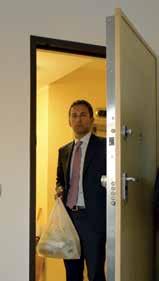
12 Piero has chosen a stylish outfit for his cooking challenge, a white and red striped apron on a white shirt 13 Cooking the prawns that will later be used in the dish 14 The lawyers finely cuts the prawns after having shelled them 15 A bowl of prawns, they are large swimming crustaceans 16 Challenge completed! Piero seems proud and happy with what the result, and shows his interpretation of the dish
Make a soffritto with 50 grams of extra virgin olive oil and 20 grams of grated garlic. Add 300 grams of grated cuttlefish and boil for about 20 minutes. Add grated parsley and salt to taste. Whisk half and add to the rest, together with 100 grams of grated and shelled prawns. Next, cook 200 grams of egg pasta in salted water for 4 minutes and briefly cool it down in water and ice and then drain.


Grease a small plate, place a layer of pasta and fill with cuttlefish and prawns sauce, place another layer of pasta and add the fish sauce. To finish, add a last layer of pasta. Place it in the oven and bake for 15 minutes at 180 degrees. For the salsa, boil the parsley for a minute and briefly cool it down. Whisk it with water, salt and some drops of lime. Cut and season 50 grams of uncooked red prawns with oil and salt, and place them on the top of the hot lasagna. Put the parsley sauce, on the sides with grated lime. Finally garnish with cuttlefish ink.

96 Work Style — #14.14 Work Style — #14.14 97
10 14 13 12 09 11 15 16
fooD for work
Silva Annovazzi
Octopus With Green Salsa And Boiled Vegetables In Tomato Water

Take an octopus of about 1 kg, rub it with salt, wash it, and prepare a quart of bouillon with 5 liters of water, 25 grams of salt, 20 grams of celery and bring to the boil. Add the octopus and boil for about 2 hours. Once done, cool it down in the same liquid. Then drain and keep it in the fridge for a couple of hours to keep the skin in place. For the green salsa, chop 30 grams celery, 10 grams onion, 20 grams zucchini, 20 grams carrots, 2 grams parsley. Add 30 grams of extra virgin olive oil, 3 grams of white wine vinegar, 5 grams of desalted capers. Whisk with an electric mixer and add salt to taste. Dice 50 grams zucchini, 50 grams carrots, 50 grams green beans, 50 grams celery and boil in a liter of water with 7 grams of salt. Stew the vegetables until “al dente.” Drain them and cool in the fridge to halt the cooking. For the tomato water whip 100 grams of tomato with 2 spoons of water, a pinch of salt and 10 grams of extra virgin olive oil. Place the green sauce at the bottom, add the boiled vegetables, tomato water and finish with an octopus tentacle and a bread croutons on top.
17 Our chef-for-aday picked one of the most famous fishmongers in town for her foodshopping. She is listening to the expertise of the shop owner to buy the best octopus, the main ingredient of the recipe


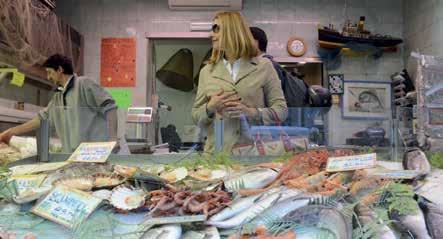
18 Silva has done all of her food shopping and is now heading home for the preparation


19 The lawyer is home, leaving the bags on the table to prepare the ingredients. When cooking it is important to have all ingredients ready and carefully divided
20 Carrots are cut in small dices.

The carrots will then be used for the green salsa, the base of this dish
21 Silva is cutting zucchini. Zucchini are part of the mix that, once boiled will be blended and turned into a green salsa
22 The mix of green beans, carrots and zucchini are place in a pan of hot water. Once boiled they’ll be blended to make the green salsa

23 The challenge is completed and she proudly shows her dish, octopus with green salsa and boiled vegetables in tomato water
20 21 22 19
17
98 Work Style — #14.14 Work Style — #14.14 99
23
24 The interpretation of the recipe created for us by starred Chef Moreno Cedroni made by Silva 24
18
fooD for work
Silvia Beccio Minestrone Soup With Pansies
Dice 200 grams of potatoes, 200 grams of carrots, 100 grams of zucchini. Then cut 30 grams of white onion, 20 grams of leek, 20 grams of celery, 5 grams of basil, 5 grams of parsley, 50 grams of cherry tomatoes and 30 grams of chard into julienne strips.
Put 20 grams of extra virgin olive oil in a pan with sliced onion and leek. Once these are golden, add the celery and then the potatoes and carrots. Add 300 grams of water to the pan, cover it and boil for 10 minutes. Then add the rest of the ingredients and add salt to taste. Make sure to leave the vegetables “al dente.” Then cool down, decorate with pansies and drizzle with olive oil.

25 Our chef-for-a-day checks her shopping list. She has chosen to visit a famous grocery store in the South of Milan whose vegetables are all of prime quality and carefully chosen 26 Finished all of her shopping, she heads home to start cooking 27 The lawyer enters her kitchen with the vegetables she bought and the pansies that will be used to garnish the dish



28 The vegetables are slowly cooking in a pan while she stirs them

29 Silvia cuts a fine white onion with a ceramic-blade knife on a wooden cutting board

30 The potato will be mixed with other vegetables for the minestrone soup with pansies
31 Silvia has completed the challenge and shows the result with pride

32 Challenge completed. A close-up on the final result, with pansies decorating the dish

100 Work Style — #14.14 Work Style — #14.14 101
25 28 29 31 32 30 27
26
By MARTA SCETTA
Slingshots, It Ain’t Easy
Often when we become passionate about something, we hope it will become a job; other times we like it because it’s a hobby or a way of meditating and relaxing. One thing is certain, however – the common denominator is passion.
For many, passions are sparked at an early age, often passed on from generation to generation. For Nathan Masters, aka FlippingOut, the 38-year-old CEO of SimpleShot from Asheville, USA, the passion started with his great grandpa. He recalls: “I spent most of my days with my great grandfather rambling about the farm. He always had a slingshot in his pocket to dispatch rats in the chicken house or keep the crows out of the garden,” and adds, “He made me my very first slingshot from an apple-tree fork.” Others develop a passion thanks to their peers or siblings and cousins.
José Muciño, aka Chepo, a 45-year-old former pharmaceutical factory employee and now photographer, recounts:
“I have been shooting slingshots since I was a child and always made them with a natural fork that I would try to get in any way I could,” and adds, “Together with my cousins and brother, we started building catapults as my village tradition taught, but one day when I saw a slingshot that an older cousin of mine had, I felt the need to go back to my origins, find a natural fork and work it myself. I still have that one slingshot.”
For still others, the love of slingshots started from functionality, as is the case for Lee Silva, a 38-year-old metalsmith from Visalia, USA: “I built my first slingshot four years ago. It wasn’t great but it served its function well, which at the time was to keep the sheep on the ranch
from devouring a small island of grass and olive trees where I would rest and entertain visitors. None of the animals were injured.” For others it’s a childhood passion that was only recently brought to life again, such as for Roberto Benzi, aka Bob Fionda, a 57-year-old professional photographer from Milan, Italy, who claims: “My passion for slingshooting dates back to when I was a kid. I remember my days in the countryside shooting at old cans with my friends.” He adds: “This love came back a few years ago, mainly because of my great love for wood and as an alternative to archery.”
“I shot my slingshot a lot when I was a boy, and rediscovered the hobby in 2008
when I found a slingshot subthread on a German gun forum, and got the bug,” says Jörg Sprave, a 49-year-old executive manager in consumer electronics from Burgkunstadt, Germany.

SLINGSHOTS 101
A functional slingshot can be made with little more than a tree fork, a pocket knife, a handful of rubber bands and a scrap of leather in less than 10 minutes. “However, we also seek true beauty, so some slingshots might take weeks to complete,” says Masters. “I can make a very functional slingshot from any kind of wood within maybe five minutes, but my most excessive construction (the car-sized winch-operated slingshot cannon) took four full days to make,” says Sprave, who adds, “A conventional handmade slingshot with a top-notch finish takes about four hours.” It really depends on many factors, such as the quality you’re after and the material used – for example, slings made out of metal need to be done really quickly as the material doesn’t stay hot forever and the time frame for forging is short. “Forging steel slingshots is
a fast-paced process, and when everything goes right a simple shooter may be done in as little as two hours, but if I’m forging something new or working in a direct manner they can often take as long as one or two days,” says Silva. Starting from the classic bifurcation Y in natural wood, they can be built with plywood and plastic materials as well as iron, aluminum, brass and titanium. They are generally broken down by type of handle and mounting rubber bands: a hammer grip, grip thumbindex, gangster-style and handle with wrist support. Fantasy, technical testing and materials exploration – there is no limit. “I have seen small and powerful catapults built using bottle openers, old wooden ladles, slings made with parts of old metal hangers, and classic resorteras from South America,” says Benzi.
THE PASSION THAT SOMETIMES BECOMES INCOME
Slingshots are an example of how a hobby or passion can sometimes become a full-time career as well as an interesting, fun and amusing form of income, while still remaining a hob-

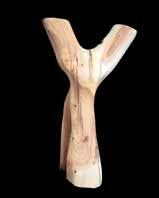



by. For example, Sprave makes money from YouTube commercials and from his products. “I also designed a commercial model, the Rambone, which is made from plastic and is sold by a professional store from which I get a share,” confirms Sprave. Masters has started a company related to slingshots, he confesses: “As a business from which I make a living, I build slingshots to provide others with shooting tools of the highest quality and value.”
“I sold some slingshots in the past three years, mostly to American and European collectors, but I prefer it as a hobby rather than making it a real job. My slings are made entirely by hand with simple tools such as knives, rasps and sandpaper, nothing else, so the time taken is disproportionately exaggerated compared to the price for sale on the market,” says Bob Fionda. For others it remains recreational, a simple hobby, although Michael McClure, aka MJ, a 37-year-old father from Otterebein, USA, who participates in shooting contests, says he’s looking for ways “…to turn it into a career.”•
01 Natural yew (Taxus baccata) bifurcation, cut and left to dry for approximately one year. Glue is applied on the top of the three edges of the fork so to avoid ruptures caused by the natural strains of drying wood.
02 The bark is removed from the fork. The darker stains of the phloem become visible. Once started, the entire process will take 12 hours spread over 3 days.
03 The fork is roughly modelled and carved with a knife and blots so to outline an ergonomic shape for the new slingshot. In this phase the sapwood and heartwood come into play.



04 The carving phase continues in the heartwood with blades and blots. Knots start to appear as the carving goes deeper, the color changes and the veining of the yew start to appear.
06 In this phase rasps of different grits are used to further model the fork. In this case, Japanese rasps of 3 different pitting degrees.
07 Once the shape wanted is obtained, the wood polishing process starts with sandpaper. In this case we started with a 240grit sandpaper and finished with a 1,000-grit one.
08 The last steps were done with 2,500-grit sandpaper. The pores of the wood are closed and the slingshot feels almost like velvet to the touch. Finish is achieved by applying a few layers of camellia oil, an alternative to beeswax. The wood is not treated with paint so it stays natural and alive.
09 Here is a complete slingshot made of hazel. The rubberbands are branded gold Theraband and are mounted on a leather pouch. The making of this slingshot was very similar to the one described in the pictures above.
102 Work Style — #14.14 Work Style — #14.14 103 Special
Report Rules and Passion
[W simple-shot.com slingshotchannel.com]
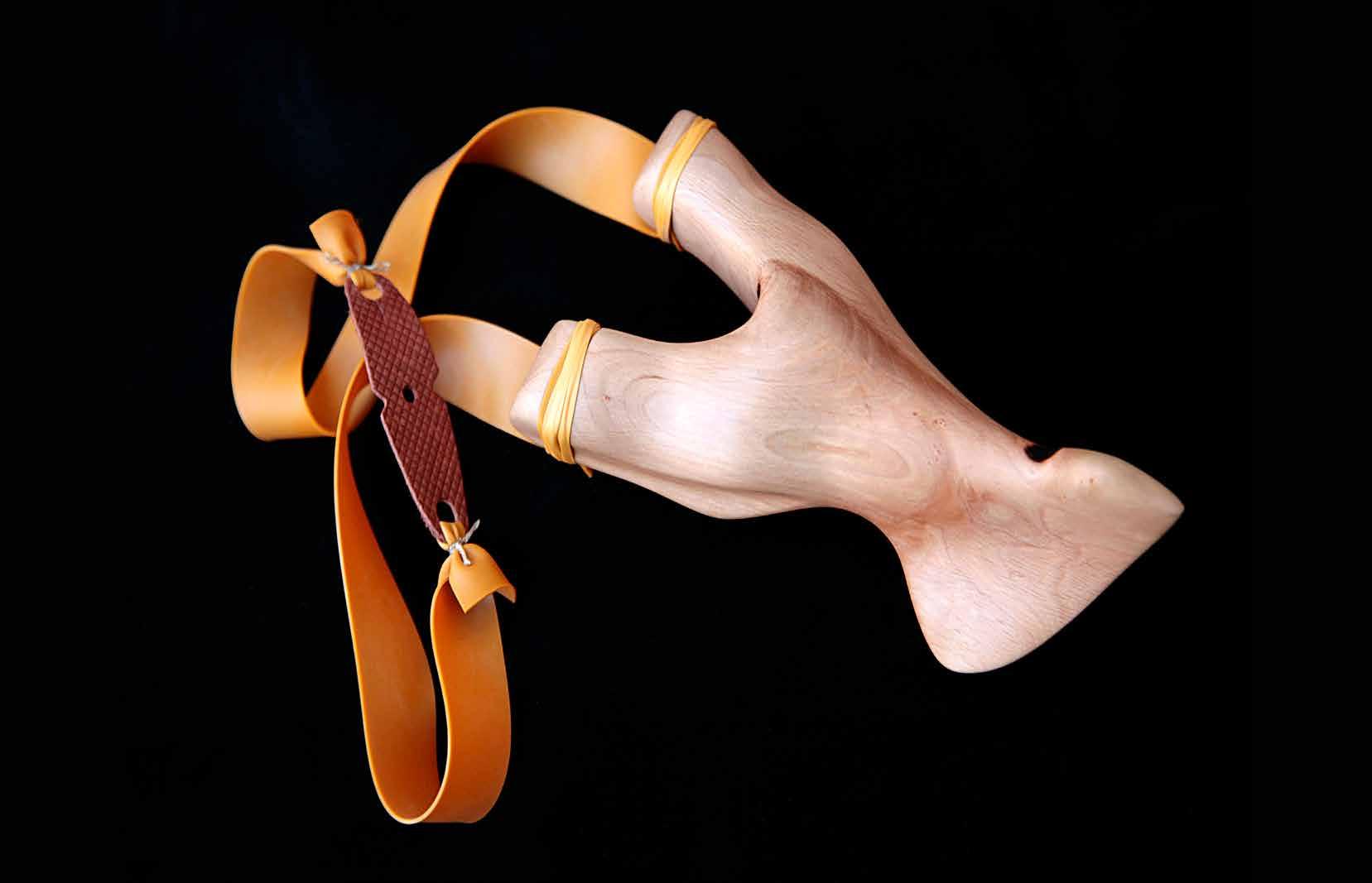
Facts & Figures
• Total horticultural production: € 8.6 billion
• Horticulture accounts for 39 percent of Dutch agricultural production
• The Dutch produce 4.32 billion tulip bulbs each year, some 53% of which (2.3 billion) are grown into cut flowers.
•The horticulture sector in the Netherlands is concentrated in so-called greenports. In the Netherlands there are 6 greenports employing a total of 130,000 employees.
01 Start with a waterbomb base for the flower
The Netherlands The Bulb Fiction
Ireland United Kingdom
06 Blow into the flower to inflate 07 Carefully peel back the petals 08 The finished flower
02 03 04 05 Tuck inside
Denmark The Netherlands Belgium Germany Switzerland France
106 Work Style — #14.14 Work Style — #14.14 107
Country Guide
By EMMANUEL MAINDRON
"The Bulb Fiction": The Art of Dreaming Naturally

"I could be blue, I could be violet sky, I could be purple, I could be anything you like…!” goes one of Mika’s songs, which could be used as a description for the country’s flower industry. There is a tremendous variety of species and the Netherlands is the biggest flower market in the world (about 50% of the world’s flowers pass through Aalsmeer Market).
If you are invited to dinner you bring some flowers. When it’s someone’s birthday you give flowers. If you want to create an atmosphere at home you decorate it with flowers (some hotels hire special flower designers), and so on. Flowers are everywhere and we are all sensitive to their beauty, their scent … and the messages they convey.
THE NETHERLANDS : THE GARDEN OF THE WORLD Walk through Amsterdam and you will soon understand that nature is all around you. There are cut-flower and bulb sellers in the markets, people use bikes, canals cover the whole city. There is an interesting and lovely mix of nature and architecture in Amsterdam. With slightly fewer than 800,000 inhabitants, Amsterdam is perfectly located in the center of Europe and has very useful transport facilities. So take your time, ride through the city, enjoy an amazing beer and smell an awesome rose, then take a car and drive to the Amsterdam “suburbs” to discover a fantastic place where greenhouses stand alongside canals or flower fields. Welcome to the Netherlands, where floriculture is a tradition, an art, a creation, a way of life.
With 16,838,413 inhabitants and a density of 403.9 people per km2, the Netherlands is today the fifth-largest exporter. The Netherlands has faced a crisis in recent years because of the importance of exports to its economy. Its GDP decreased to 0.8% in 2013. However, the European Commission predicts GDP growth in 2014 of +1.2% and the IMF predicts +1.6% for the same period.
Rotterdam’s port and Schiphol Airport make this country one of the most important European hubs for trade. The
country can also count on large companies such Shell, Unilever, Heineken, ING and Phillips.
If the Netherlands is known globally, it is for its floriculture activity. This is an old tradition; for a long time people have liked to grow things (both vegetables and flowers). In the last century, the Netherlands has increased its knowledge in this sector.
In this way, flowers and the Netherlands are inextricably linked. First, it remains one of the biggest producers of flowers in Europe, and second, this activity attracts a very large number of tourists to the country (11,680,000 visitors in 2012). Although the Netherlands is known as the biggest flower produc-
er, this sector is very competitive and some other countries, such as Ecuador, Kenya and Ethiopia, are becoming important producers.
GREENHOUSES AND FIELDS AS WORK TOOLS
A few kilometers outside Amsterdam city center, the countryside changes. The highway ends and little roads emerge. There are fields, and in spring it’s a perfect place for tourists to visit as the fields are full of different colors and varieties of flowers. In this environment, competitors are numerous. In the previous century, many people had fields and decided to create their own flower plantation. This is the sto-
ry of W.A.M. Pennings. The company is based near Amsterdam. Entering the meeting room feels like going back in time. There’s a tiny old work table with a weak light. Everything reminds one of the history of this company.
Sixty years ago, Wim Pennings started his company in Noordwijkerhout. He sold tulips. The company was growing quickly so he focused his activity on the cultivation and trade of garden tulips.
Another step in the company’s development took place at the end of World War II. Business became easier with the USA (although you really had to be motivated because, initially, it took about six weeks by boat to reach America with your products) and competitors also became more important due to the size of the market.
The 90s brought new development opportunities with the creation of the European Union. Trade was easier and eventually the common currency (the euro) transformed Europe into a huge single market. It’s a really important issue for Pennings because they sell their products globally.
Today they cultivate more than 600 spe-
cies and trade in about 1,000 species of bulbs. “Every day we develop new species. It generally takes about seven years to imagine, create, develop and trade one new species,” explains Sjaak Verkade, in charge of communications for W.A.M. Pennings. You need to be patient with flowers. Floriculture is like fashion. Needs change depending on the season, on fashion … so it’s hard to predict a new trend when it takes seven years to launch it! They have also decided, like many companies in this sector, to minimize pesticide use to enhance environmental protection. Today they are exploring emerging flower markets such as Romania, Poland and Russia.
FROM THE FIELD TO YOUR GARDEN
In this way, you can buy their bulbs in your corner florist (and maybe in the florist you visit during your holiday in another part of the world). In order to understand how they got from the field to your garden, here are the steps in the cultivation of tulip bulbs. They are planted and covered in straw from mid October until mid November. Bulbs are planted mechanically and covered with
straw to protect them from frost. “In March the first tulips come out. The flowering period runs from late March to mid May. When a tulip flowers depends on the species (there are early species and late varieties) and on the weather conditions. With a mild winter and a warm spring, the tulips will emerge earlier than with a harsh winter and a cold spring,” says Verkade. After this, it’s time to check that the bulbs are okay and whether they have any viruses or diseases. If there’s any doubt, the bulb is removed (to limit transmission of diseases). After this check-up, employees remove the flower heads. This means that all the energy is kept in the bulb instead of the head of the flower, and so bulbs can grow again to form new bulbs in order to be planted next year or to be sold. In mid June they start to harvest the bulbs. They are stripped of dirt, sand and soil. Once dry, they go to a peeling machine and are classified before being stored and readied (some of them need additional preparation) for export. After this whole process, you will finally find your bulb in the flower store.
01
FloraHolland is a cooperative flower auction offering growers and customers a network of national and international marketplaces and an internationally active import department.

[W floraholland.com]

01 Esther Bodde, HR manager

108 Work Style — #14.14 Work Style — #14.14 109
Where to Work Country Guide The Netherlands
Where to Work Country Guide The Netherlands
02 Lex Van Horssen, press officer 03 The auction is finished and the trolleys empty 03 02
FASHION FLOWERS
Choosing a flower is not an easy decision. As with clothes, flowers are fashion. Fashion changes every day. In every new season you see new clothes in different colors and different materials. You see stripes or floral patterns, and so on. Each country, each age, has a unique need at a particular moment. For floriculture, it’s the same. Fashion is changing, and if one day big flowers are on trend, the next day they’re not anymore. It’s complicated to adapt one’s offering because of the long process to introduce a new species to the market. But we can observe general trends. For example, France loves flowers in pastel colors whereas America loves flowers with strong colors, and Russia and Italy love big flowers. So each country prefers a different kind of flower (trends are often based on the size and color of the flowers). Anyway, there is a flower for everybody and producers, breeders and traders can share their thoughts about coming trends or new species at international fairs. Each November, one of the biggest fairs takes place in Amsterdam.
Van Haaster Nevada also deals in bulbs. “We are exporting all over the world,” says Doesjka Van Haaster-Hoveling, financial director of the company. She tells us the story of the company, explaining that her husband learned about flowers in France and then found his clients using the phone book, looking for clients interested in flower bulbs. Today they use “new” marketing tools to sell their products and they export all over the world. “We found a new market in the Middle East,” she explains. Their job today is more focused on trading in bulbs than producing them. “To be a grower you have to be very big because prices are the same as 50 years ago while costs have gone up,” the executive says. They sell their bulbs to two kinds of clients: ones who use bulbs to produce flowers and others who resell bulbs to the final customer/user.
INTERNATIONAL ISSUES
In this kind of trade you need to be very aware of political and/or geographical issues. Crises, embargoes and customs tolerances are differences
that can affect trade. Doesjka confides that they once traded some lilies in China. Chinese customs changed their policy on lilies and decided to apply zero tolerance of imperfections or parasites. So all containers already sent or prepared had to be thrown away. Plus, the recent crisis with Russia has affected the market. So, it is an everyday job in this sector to be aware of everything that happens outside the borders. To help them in this international context, the ANTHOS organization has been set up. Its goal is to represent companies and help them. It answers their questions and represents the interests of the sector abroad.
It’s also interesting to see that each country has his own preference about the maturity of the flowers. Thus, when flowers are sold in France they need to be open, whereas in the Netherlands people will buy flowers that are not yet open (to last longer). Doesjka explains that men and women also have different tastes in flowers. She tells an anecdote about a supplier coming to their office with a new flower variety. All the men present found the flower beautiful
while all the women though it was not very “pretty.” Taste in flowers depends on country, gender, season. That’s why there is such a big market where innovation stands alongside classic flowers. Flower bulbs are an important part of the market in the Netherlands. Some companies cultivate bulbs, others trade them, and some big companies do both.
“WHEN YOU BECOME PESSIMISTIC, JUST LOOK AT A ROSE”
The Netherlands deals in several kinds of flowers. Of these, one is well known by everybody and is often a symbol of love and passion: the rose. It is one of the oldest flowers and has many varieties. Some companies in the Netherlands breed roses and others produce them, but each company works with other countries (including Ethiopia, Kenya and Ecuador) to be more efficient.
“Breeding is the power of innovation,” explains Örjan Hulshof, international sales and marketing manager for De Ruiter Innovations. Roses, as with other flowers, try to match demand. That’s why you see lots of different species when you go to the florist to buy them.
Innovation is a big deal for the breeders. They try to create the best roses. If you are going to the Netherlands you will probably see some greenhouses on your travels. The land is full of them!
If you arrive at Amsterdam Schiphol by air at nightfall you will understand how important this culture is by the number of greenhouses with their lights on.
Breeders are crossing roses in order to create new ones, but the process is quite a long one.
First, they reproduce roses by doing the job of the bees. That is to say, they take some pollen from one rose and inject it into another one. In this way they can cross two species, hoping that the new one will be a mix. This work is done by a breeder. Next, they have to wait for a new rose to grow. Breeders have special sections in their greenhouses for this step, like a nursery. New species then grow. Lots of crossings are done this way every year. For several months, the breeders will take care of these roses and analyze the new characteristics of the species. It’s important to take into consideration the width of the leaves, the size of the rose, the number and
size of the spines, the colors … from all these details, a few roses will be chosen to go forward to the second part of the creation process. Thus, the “lucky” ones will join a new part of the greenhouse. Breeders will analyze them again and again alongside other species. At this stage the roses don’t have a name, just a number. Finally, after many tests, a few roses (maybe one or two or ten depending on the year) will be selected to be introduced on the market. This process can take between four and eight years. The company will then name them. Depending on their characteristics, they will be sent to Ecuador or Kenya or will stay in Amsterdam to be grown before being sold to producers. Breeders will choose a specific country for the rose because each country has its own particular climate, altitude and so on that permits the rose to grow in the best conditions.
In this huge market, breeders are trying to innovate, to create new rose varieties, and to find the best places to breed them. Olij Breeding is a rose company, created 30 years ago, that decided to be both a breeder, propagator and produc-


Anco Pure Vanda (formerly ANCO Orchids) is a producer of Vanda orchids, established in the Westland.
[W anco-pure-vanda.nl]
01 Steef Van Adrichem, commercial director 02 Special Vanda orchid by Anco Pure Vanda


110 Work Style — #14.14 Work Style — #14.14 111
Lex+ is a rose creating company
De
[W lex.nl]
Rokus
manager
Working
01 03
based in
Lier, with showrooms all over the world.
01
Hassefras, marketing
02
with roses
Where
to Work Country Guide The Netherlands
01 02
Where to Work Country Guide The Netherlands
er. Most of their activity is focused on breeding. They now produce flowers in the Netherlands (4 hectares), Ethiopia (12 hectares), Kenya (5 hectares) and Ecuador (2.5 hectares). Wout Oor, sales manager for Olij, confirms the need for different countries for producing roses. “Each country gives special colors to a rose.”
At Lex+, a rose creator company, Rokus Hassefras, marketing manager, explains that he loves to tell his clients the story behind the flower. “Clients like to know the story of the flower. I think it creates emotion. This is not just a product that people can buy. This is more. A rose is an emotion.” In this way, several years ago, a new rose was not growing well in the greenhouse, but the gardener found it beautiful. He decided to take the rose to his own garden and, against the odds, it flourished and was finally launched on the market. It was a commercial success and they named this rose Backyard+.
You can find flowers in many places – supermarkets, florists. Hassefras underlines the fact that buying a flower in a particular place depends on your

needs. “If you buy a flower in a supermarket, it’s an impulse purchase; conversely, when you go to a florist, it’s more related to emotion, because you want a flower for a special occasion, you want the story, you want advice from the seller.”
Several years ago, a flower appeared in florist stores – the orchid. We met Steef Van Adrichem, commercial director of Anco Pure Vanda. He visited Thailand several years ago and immediately fell in love with an orchid, Vanda. He bought some plants and started a plantation in the Netherlands. Today 60,000m2 are dedicated to Vanda and 95% of Vanda’s European production is by his company. Orchids are really popular. Each week two million are sold just in the Netherlands. Steef is passionate. He talks about Vanda as his baby. He is an artist; he creates jewelry with his flowers (his latest creation is a headband with a Vanda). But the company also works with prestigious hotels. “The market is difficult and we have to be innovative to stand out,” argues Steef. He shows us a new idea, selling cut flowers to florists so that they can in-
Olij Breeding
is a breeder and producer of roses based in De Kwakel, near Amsterdam.


[W olijrozen.nl]
01 Wout Oor, sales manager
02 Flash Eye rose, patented by Olij Breeding
03 Bouquets of roses are assembled
04 Open boxes, ready to be filled
05 An employee checks the quality of the roses
clude just one or two Vanda in a bouquet. He is full of ideas and passion. “I want to stand out. I work with fashion,” says Steef, showing us shoes with Vanda motifs. So, yes, you can work with passion, with innovation, with fashion, with jewelry to promote your flower, to face a crisis.
FLOWER TEMPLE
If the Netherlands is famous all over the world for flowers, it’s because it’s one of the biggest markets for flower trading. During your visit to Amsterdam, if you like to get up early you must visit FloraHolland in Aalsmeer. Created in 1911, FloraHolland is a cooperative where supply (growers) and demand (buyers) meet. Enter the building and you are immediately in a different world –a huge space dedicated to flowers. All kinds of flowers are present (some of them are well known and others are rare). It’s like a small village with separate areas. A village with its own code. From the afternoon until 3 a.m., growers come to Aalsmeer to deliver their flowers (generally freshly cut during the day), and at 6 a.m. the journey starts.
All the flowers are stored in cold areas. “At about the size of eight soccer fields, this is the biggest fridge in the world,” jokes Lex van Horssen, press officer of FloraHolland. During the night, inspectors check both flowers and plants to prepare for the auction. Even though the place looks a mess, everything is codified. This giant area is full of people on their little cars (trolleys to take enormous boxes of flowers from one place to another). At first sight, you will be astonished by the number of cars, of rails, of flower boxes. It’s like being on a highway. Most people work here for several hours and then go on to a second job. Approximately twenty percent of employees are women. Some of them do this job so they can easily schedule their day, as it is mostly done at the end of the night/start of the morning. Several years ago FloraHolland launched a human resources program called “Working at night.” “We make people aware of the risks of working during the night, so we speak to them about health, how to sleep well, how to eat correctly … and one consultant is dedicated to preventing risk,”
explains Esther Bodde, HR manager at FloraHolland. Today the company has approximately 3,500 employees who represent around 50 nationalities. This is a huge integration issue, but has been successful thanks to a big family culture and wide training choices to empower employees. FloraHolland offers, for the most part, long-term contracts.

FROM WALL STREET TO AALSMEER
All the trolleys are here to bring flowers from the cold area to the auction room. In order to sell the products, there is a big room in the market to present them to the buyers. This is the auction room. Let me describe this place for you. You feel like you’re in Wall Street, except you’re buying flowers rather than shares. There’s an amphitheater in the middle of the room where buyers are seated in front of their computers. Downstairs you find the “stage,” where all the products are presented. On both sides of the room, two auctioneers are engaged in live chat with the buyers. Just above them are two clocks. These are the heart of the trade. The clocks represent the sales (actual and coming).
Van Haaster Nevada, established in the flower bulb region, is a well-known exporter of flower bulbs, tubers and herbaceous perennials.

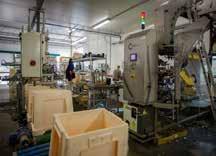

[W nevada.nl]
01 Doesjka Van Haaster-Hoveling, financial director 02 A handful of flower bulbs
112 Work Style — #14.14 Work Style — #14.14 113
01 02 05 04 03
The
Where to Work Country Guide
Netherlands
01 02
Where to Work Country Guide The Netherlands
Each screen indicates the next sale, the quality of the flowers, the producer and so on. The prices at these auctions decrease. That is to say, the auctioneer sets the highest price of the product. Then, represented by a clock, the price passes in front of the buyers. They can buy the product just by pushing a button on the table. They need to get the flowers and pay the appropriate price for them – a difficult challenge because they need to be really fast. “I never succeed in pushing the button at the right moment,” confesses Lex van Horssen. So this is an important issue. “This is a real advantage for both buyers and growers because buyers know that they will find all they need at Aalsmeer and growers know that they will sell their products among all these buyers,” argues Lex. This is an important issue for both because they have just one delivery point. All the product is in one place, reducing transport and logistics costs. FloraHolland’s turnover was 4.5 billion euros in 2013. The main export country is Germany (with about 1.5 billion euros), followed by the UK and France.
THE FUTURE IS WORLDWIDE Today FloraHolland is investing in innovations to anticipate change. Because of the internet, fewer flowers are physically present in the auction room and more and more buyers are connecting from their offices to take part in the auction. Trade is changing. In the past, all trades took place with the stock and the buyer physically in the same place, but now the internet has changed this sector and people are working from their offices on all the stock exchanges on the globe. It is exactly the same at Aalsmeer – buyers use the internet more and more to buy their flowers. Maybe it will open new markets by having buyers from around the world. This is a very important issue and all the companies in the sector are concerned. FloraHolland also need to deal with transport and logistics issues. It’s really important to preserve the freshness of the flowers; they must be delivered to the buyers as soon as possible. The trolleys are part of this process. They bring all the flowers bought by one client and deliver them to a particular place.
In this way, you can buy flowers in your florist that have been cut 24 hours earlier, even if you are far away from Amsterdam!


In 2013, each day in the auction room, 9.2 million euros of flowers were sold (that’s 29.9 million flowers every day). The bestsellers are roses (780 million euros in 2013), chrysanthemums (291 million euros) and tulips (270 million euros). It’s also interesting to note that the most important days in the flower sector are, first, March 8 (International Women’s Day), then February 14 (Valentine’s Day) and Mother’s Day.
FINAL DESTINATION: FLORIST
When all these process have been completed, florists receive the flowers and sell them to the final client – you and me. Amsterdam has lots of florist stands on the streets. Ron Abels (an employee of Klaas Timmer) has worked in the market for a long time. “We sell lots of roses, tulips and amaryllis. We receive the flowers in buckets and create bouquets,” he says. “Our biggest clients are from Amsterdam, even if there are lots of tourists,” argues Anja Rijn, own-
Working in the Netherlands
By Erik Van Riet, CEO of Great Place to Work® Netherlands

According to the IMF, the GDP of the Netherlands is 1.8%. The economy is growing more quickly than in previous years and unemployment is lower than in other European countries.
At Great Place to Work®, this year we have seen an increase in the number of companies participating in our study.
Our institute aims to highlight companies with good human resources management practices.
In 2014, 112 organizations took part and 47 have been included on the list. It was the largest Best Workplaces list from Great Place to Work® Netherlands in our history. So, that means companies are focusing on the future and are really taking their employees into consideration.
Thus, in 2014 we have decided
to give three special awards to companies excellent best practices in the areas of innovative hiring practices, community involvement and culture of fun. For example, some companies celebrate important moments (birthdays with a song and a gift, a new hiring, Christmas). They consider it to be motivational, to increase energy and to show their appreciation of their employees. Next year (in March 2015) we will dedicate our special awards to three important areas.
Our mission at the institute is to create a better society by helping organizations in their development to become great workplaces. We
really want to share this mission with all companies. We share the stories of the Best Workplaces to inspire and to acknowledge them as great workplaces.
2014 Best Workplaces in the Netherlands
Large
& Multinational Companies
1. SAS Nederland 2. Microsoft 3. Novo Nordisk BV 4. Cito Benelux BV 5. McDonald's Nederland BV 6. Call2 7. Hilti Nederland BV 8. Kindergarden 9. NetApp 10. Adecco 11. DELA 12. Nationale Postcode Loterij 13. CSU Total Care 14. Medtronic 15. EMC 16. KPN Consulting 17. QNH Consulting BV 18. Creyf's 19. AbbVie 20. Ajilon 21. Gemeente Hoorn 22. Monsanto 23. Hobij Experts in European Workforce 24. Vaillant Group Netherlands BV
Medium-sized Enterprises 1. ORMIT 2. ICM Opleidingen & Trainingen 3. Incentro 4. SecureLink 5. Tam Tam 6. Diageo 7. Festo BV 8. Sysmex 9. A.S.R. Vastgoed Ontwikkeling 10. Vermilion Oil & Gas Netherlands BV 11. Primagaz Nederland BV 12. Webasto 13. EBN BV 14. Secretary Plus
Small & Young Enterprises 1. Tony's Chocolonely 2. Het PR Bureau 3. Young Colfield 4. Motion10 5. Intermax Hosting 6. USG Finance Professionals 7. Meda Pharma 8. USG Legal Professionals 9. USG Marketing, Communication & Sales Professionals
Great Place to Work® Institute Netherlands
Herengracht 124-128 1015 BT Amsterdam T 0031 20 260 06 94 [W greatplacetowork.nl]
114 Work Style — #14.14 Work Style — #14.14 115
Vazoplant is a flower and plant shop in Amsterdam's famous Bloemenmarkt.
[W vazoplant.nl] 01 Anja Rijn, owner
01
Klaas Timmer is a flower shop in Amsterdam's famous Bloemenmarkt.
01 Ron Abels, employee
ERIK VAN RIET
01
er of Vazoplant. Ron explain that most of their sales are for home use. People buy flowers to decorate their homes.
Anja, for her part, works with some hotels and restaurants, but she obviously see the results of the crisis. “The market has been decreasing for several years.”
DO YOU SPEAK FLOWER?
Having discussed flowers, you now have more details about them. Details about breeding, creation, fashion, production, auction, exports … but what about their message?

When you give flowers to someone you send them a message. So be careful about your choice if you want to avoid mistakes or misunderstandings.
Take some examples: Chrysanthemums are related to the end of a relationship. That’s why they are generally used in the cemetery.
Violets mean that you love someone in secret. Perfect for timid people! If an olive branch symbolizes peace, palm trees symbolize victory, and so on. But choosing a flower is not enough; you also need to take care with colors. White represents purity, elegance; pink
is related to kindness (a great flower to offer people for whom you have affection). Finally red is THE color symbolizing passion. Perfect for a declaration of love!

If our words are explicit, flowers are a powerful communication tool that give you the opportunity to deliver a message, to brighten your house, to delight your host … Everybody has their own preference, but flowers are still the best way to carry a piece of nature with you.
Flowers are present in our daily life, from birth, when mothers receive flowers, to weddings to congratulate the couple, and, finally, death, when flowers are placed in the cemetery. Flowers help us to communicate. But they’re also for decoration …
Flowers are all around us and everybody has their own experience with them. “So many flowers come out without being seen.”•
for the text and Barbara Pavie for the images. We would like to thank them for their work.
Emmanuel Maindron is a communication specialist. After working for Great Place to Work France for several years, he decided to work as both a freelance consultant and a journalist.
Barbara Pavie is a French freelance photographer, based in Amsterdam. She is graduating from the Fotofactory Institute in Amsterdam. Her images have appeared in Terrascape Magazine, Permacultureprinciples. com and other pubblications. She's interested in documentary photography, mainly societal and environmental topics, looking into the influence of evolution and contemporary issues on people's traditions and the environment.
Jeroen Hofman.
De Ruiter is a developer of roses based in Amstelveen, close to Amsterdam.
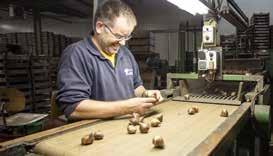
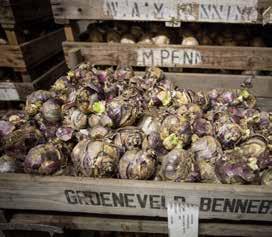
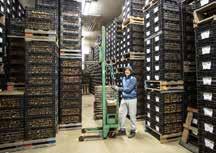


[W deruiter.com]
01 Örjan Hulshof, sales and marketing manager
02 This creation, at present still nameless, is copyright of De Ruiter
116 Work Style — #14.14 Work Style — #14.14 117
This reportage is by Emmanuel Maindron
01 02
W.A.M. Pennings / Damen Flowerbulbs, founded 60 years ago, is a producer and trader of tulips. The company has several subsidiaries and has approximately 20 permanent employees. [W wampennings.nl] 01 Sjaak Verkade, communications director 02 Bulbs in branded wooden cases 03 An employee checks the quality of the bulbs 04 Piles of branded wooden boxes 05 Working dynamics at W.A.M. 01 02 05 03 04
Guide The Netherlands A couple that has made a profession out of art:
An artist has photo-
Interviste Video Back Stage Fotografie Video Documentario book Video Backstage Photography Video Documentary Fine art exibition
Where to Work Country Guide The Netherlands
Where to Work Country
p.118 Bart Van Heesch & Emilie Kröner.
graphed people in a working context: p.120
Bart Van Heesch & Emilie Kröner
An Old School as a Creative Lab
Ten years ago, Bart met Emilie and they began their collaboration (both work and family).
In a city where bikes are used by everyone, Bart Van Heesch decided to take care of them. He recycles bikes into works of art using old Archetyp Amsterdam bicycles (instantly recognizable by their gold or copper color).





At the same time, his wife Emilie (they inspire each other) has created a whole story using animals in ceramic. Elephants are transformed into salt and pepper pots or crocodiles into candy (or cookie) jars. Both of them were doing other jobs before turning to art. Emilie was an interior designer before deciding to finally create

her own projects. They have changed their lives to become “designers” and to make their dream reality.
They moved into an old school. Bart has his lab in the school’s old gymnasium (with room for his bikes) while Emilie works in a cozy old classroom. The place is dedicated to their creations. It’s an alternative accommodation where you can never run out of ideas!
In this way, they created a wonderful project with schoolchildren, making lamps from old cans and bottles picked up in the street. It was an educational project where children learnt environmental protection and design. It was a great success. Emilie and Bart are now creating a box where you will find gloves, lamp structures and light bulbs to create your own by protecting the environment.
118 Work Style — #14.14 Work Style — #14.14 119
02 03 04 05
01
Where to Work Country Guide The Netherlands
[W
01 Emilie
02 Artist tools 03 Bike seat 04 Bike chain and pedal 05 Bike in chains 06 Bart
creations 06 Interviste Video Back Stage Fotografie Video Documentario book Video Backstage Photography Video Documentary Fine art exibition
piselliprojects.com vanheeschdesign.com]
Kröner, artist
Van Heesch, artist and gallery owner on one of his
Where to Work Country Guide The Netherlands
Where to Work Country Guide The Netherlands

Jeroen Hofman is a Dutch photographer born in 1976. He was a recent winner at the Sony Photography Awards. His work has been commissioned by advertising agencies such as HAVAS, TBWA and DDB, as well as companies including ING. His images have appeared in the Sunday Telegraph Magazine, CODE magazine and Esquire Russia among others.
Jeroen has always been fascinated by people in exclusive "clubs" and close communities; groups of people bound together by a common fate, a shared passion
or affliction. He explains, “As a photographer I explore their worlds with my camera. I can never truly become a member of their communities, however, so as an outsider am forced to find my own perspective on their microcosm. A lot of my commercial work is offered to me by people who have seen my personal work and want to incorporate my style or esthetic fingerprint in their products or projects.”
Jeroen was also granted the Amsterdam Fund for the Arts by the Amsterdam City Archives for
a documentary assignment. For this project he’s photographing Amsterdam’s parks, capturing the landscapes, the activities and the dynamics developed in the city’s green areas.
If you want to see the first images of this ongoing project and to see Jeroen’s work visit his website: jeroenhofman.com
All photos are by Jeroen Hofman. This work series was commissioned for the European EMMA Advertising Campaign.
120 Work Style — #14.14 Work Style — #14.14 121
01
Oil and gas employee on site
Backstage Photography Video Documentary Fine art exibition
Stage Fotografie Video Documentario



122 Work Style — #14.14 Work Style — #14.14 123
04 Technology and electronics lab employee
03 Food lab employee 05 Car painter
facility
Where to Work Country Guide The Netherlands
Where to Work Country Guide The Netherlands
in automotive

124 Work Style — #14.14 Work Style — #14.14 125
Where to Work Country Guide The Netherlands
02 Construction worker
Where to Work Country Guide The Netherlands
Where to Work 3 Work City Guides
Where to Work Into the City
100 Work Cities
The top 100 cities for workers over the next decade are profiled in a project put together by GWH (SA) - Work Style.
Abu Dhabi
is the capital of the United Arab Emirates (UAE). Today it houses federal government offices and its rapid development and urbanization, coupled with the relatively high average income of its population, has transformed Abu Dhabi into a more advanced metropolis. Abu Dhabi is the fourth most expensive city for expatriate employees in the region. Work opportunities are many in this oil-rich emirate. Life in Abu Dhabi tends to unfold at a slower pace than in Dubai, and the city is often characterized as more family-friendly and better suited for those looking to settle down and stay awhile. Not to mention, the UAE's capital is less built-up and boasts broader patches of greenery.
Medellín
is the secondlargest city in Colombia and it is located in the Aburrá Valley, a central region of the Andes Mountains in South America. In February 2013, Medellín was named the most innovative city in the world. With a renowned leadership in the finance, banking, services, politics, art, culture, communications, fashion and entertainment industries, the city is a true development axis. Its industries are clothing, medicine, construction and education, but also include health, tourism and sporting events. A good number of regional, national and international organizations and big corporations have chosen it as their base.
Libreville
is the capital of Gabon, with plenty of five-star hotels, malls and restaurants and a vibrant nightlife. Nearby beaches are becoming weekend getaways for city dwellers. Libreville is one of the most expensive cities in Africa. The city's livelihood is highly dependent on exporting raw materials such as wood, cocoa and rubber. With 85% rainforest land, Gabon has impressive natural resources. Being located on Gabon's north-west coast, Libreville also thrives on shipbuilding. The sawmill and brewing industries also contribute to the city's profit. Many landmarks and important structures such as universities, museums, government seats, churches and banks are conveniently clustered in Libreville.
We have already published the guides to:
Brazil: São Paulo
Canada: Quebec City
Chile: Valparaiso
China: Shenzhen
Colombia: Medellín
France: Marseille
Gabon: Libreville
Germany: Düsseldorf
Greece: Thessaloniki
Italy: Turin Japan: Kyoto Kazakhstan: Almaty Malawi: Blantyre
Malaysia: Kuala Lumpur Nigeria: Lagos Norway: Bergen Portugal: Oporto
Russia: Ekaterinburg UK: Manchester Ukraine: Mariupol USA: Denver, Albuquerque
Slovenia: Ljubljana
The Netherlands: Eindhoven
Turkey: Izmir
Naples Reviewed

Cosmopolitan, welcoming, mysterious, snobbish: an original and genuine portrait of the marvellous Mediterranean center. Three Neapolitan citizens share their vision and experiences of the city they love so much.

SAN GENNARO
SOCIETY AND LIFESTYLE
100 Work Cities
The selected 100 cities are spread throughout the 5 continents: Europe, Asia, Africa, America and Australia.
State of the Art
We have presented the 100 cities that made it on to our list. We have analyzed hundreds of cities, passed them through our strict criteria, adopted with reasonable tolerance. The selection process has closed. We continue to write our city guides and we are currently working on the magazine’s new website, which will have a dedicated section for this project.
Progress
We have now reached 29 cities. We're working on approximately 6 now and during next year we'll work on other 6, and we’ll get closer to crossing the halfway point of the project.
Write to: welcome@gwhswiss.com

Spain: Seville
Lebanon: Beirut
Venezuela: Caracas
Following in 2015: Pécs,
Tunis, Detroit
• Pécs is the fifth-largest city in Hungary. It is the natural hub of local products. There is a gradual development of modern high-tech industry.
• Tunis is the capital and Tunisia's largest city. The economic focus is on textiles, carpets and olive oil.
Tourism also provides a significant portion of the city's income.
• Detroit is the most populous city in the US state of Michigan, known worldwide as the capital of the automotive market in the US. Today its economy is troubled.
Beyond stereotypes (pizza, coffee, sun and sea) and actual downsides (traffic, corruption, bureaucracy, petty criminality), Naples is a very enjoyable and pleasant city to live in. Even though many Neapolitans decide to leave the city in order to study or work in northern Italy or abroad, many others are attracted by its immense cultural heritage, the result of different conquerors through the centuries. If, on the one hand, there are few companies and few big industries and thus not many work opportunities, on the other hand the city offers huge inspiration to painters, musicians, photographers and directors, who find in Naples a unique energy that flows into their works of art. Naples is a multi-ethnic city and, because of its history, very tolerant and welcoming to the foreigners who get to know it better than “simple” tourists, unveiling to them its most brilliant and creative sides.
“CLUBBING”
Similar to the British tradition, and still a strong and lively institution in the city, the “circoli” are private clubs usually
One of the most powerful presences in the city, San Gennaro goes beyond religious belief, being part of everyone’s tradition and life. After incessant wars, plagues and the eruptions of Vesuvius, Neapolitans made a vow to San Gennaro, asking him for help and promising in exchange a new chapel that would guard his relics, curiously in the presence of a notary. From the beginning, the Chapel of San Gennaro’s Treasure has been managed not by the Church but by the most prominent families, and still is today. The treasure has recently been shown in a traveling exhibition in Rome, Paris, Brussels and Brazil, with enormous success.
STYLE AND ELEGANCE
“The sum of small details makes a man elegant. Never wear a light blue shirt in the evening, never wear a bright red tie.” So proclaimed Eugenio Marinella, founder of the brand and one of the protagonists of the well-known Neapolitan tradition in tailoring. Refinement and good taste are part of the Neapolitan character, but true elegance is much more than buying a beautiful item of clothing. It is knowing how to wear it
with inner charm. In fact, genuine Neapolitan elegance resides in sobriety and measure, ultimately in culture and tradition, which are precious tools that direct a person in all aspects of his life, from the way he dresses to conversation, from his manners to making choices with balance and wisdom.•
01 02 03
126 Work Style — #14.14 Work Style — #14.14 127
➜
➜
➜
➜
➜
➜
WEEKEND ➜ Capri ➜
WHERE TO LIVE ➜ Positano ➜ Sorrento
City Center
Posillipo
WHAT TO SEE
Chapel & Museum of San Gennaro’s Treasure
The Cathedral
San Carlo Theatre
Riviera di Chiaia
Ischia
There is a saying in these parts: Where logic ends, Naples begins. Naples is a city of nonsense and contradictions. Placed in an amazing natural setting, but often neglected; immensely rich in historical and artistic treasures that its inhabitants almost take for granted; rooted in its past and traditions, but open and welcoming to foreigners and visitors. Tough and captivating, lazy and intriguing, complicated and charming at the same time. Once you have lived here, our three interviewees agree, you can live, work and succeed anywhere in the world.
Text by CHIARA TENTORI
Photos by PAOLO MAZZO
linked to certain sport activities, mainly watersports like swimming, sailing and rowing, but also fencing, tennis, horse riding and golf. Circolo Italia, Circolo dell’Unione, Circolo Nautico Posillipo, just to name a few. Selective in their membership, these clubs are places to get together, socialize, practice sports and promote cultural initiatives. They are probably the most explicit expression of a certain Neapolitan character and spirit: snobbish, well informed, curious, light-hearted and sarcastic.
01 Riccardo Imperiali di Francavilla
02
Giancarlo Cangiano
03
Maurizio Marinella
Contacts
Civil law specialist and founder of Gruppo Imperiali law firm, his fields of expertise are business organization, privacy and data protection, working for private companies, industrial federations and local authorities. He is a columnist and author of several publications for Il Sole 24 Ore and Giuffrè. He is a member of the committee that preserves and promotes San Gennaro’s Treasure in Italy and abroad.
Riccardo Imperiali
RICCARDO IMPERIALI DI FRANCAVILLA (with his wife). I began my career as a civil lawyer about 30 years ago, starting at my father’s law firm and working for communication, bank and insurance companies. Even before certain subjects in private and public companies were discussed, turned my interest to business organization, privacy and data protection, firmly believing that organizational models within businesses can help to prevent certain crimes and corruption. I believe that law and the respect of rules can facilitate business; I am against quibbles and bureaucracy, which sadly afflict Naples and Italy in general.
To the foreigners who move here, Naples does not provide many opportunities in terms of jobs in big companies and industries, but its vast cultural heritage attracts artists from all over the world, offering them unique inspiration and a continuous cultural exchange.
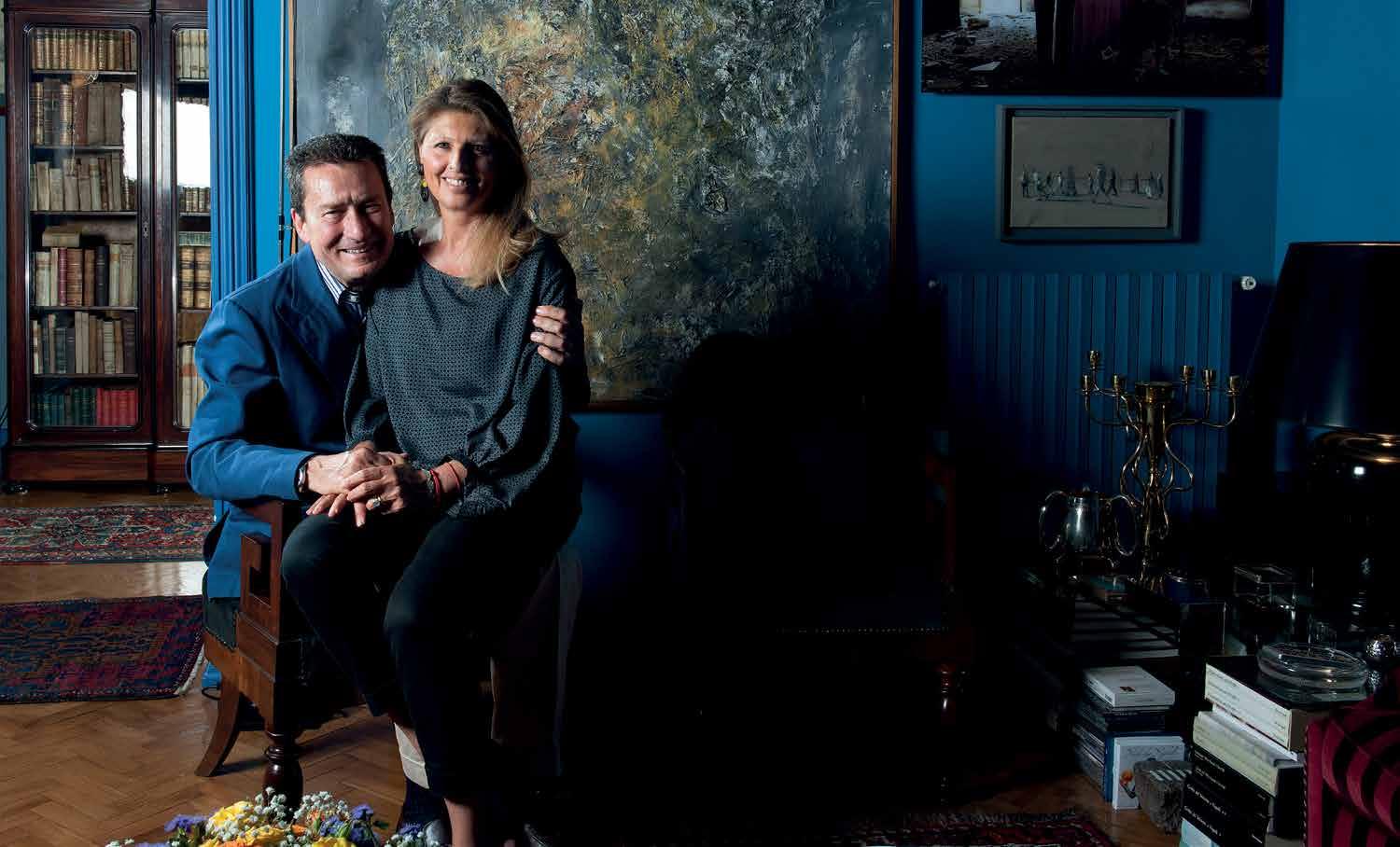
128 Work Style — #14.14 Work Style — #14.14 129
A physician for 15 years, and an entrepreneur in industries such as work safety, environment, fashion and logistics. A great sports lover, he played basketball until the age of 35, later turning to speedboat racing and offshore piloting. In 2003 he founded his team “Operazione San Gennaro,” dedicated to the patron saint of the city, which has won three world championships.
Giancarlo Cangiano
Like my father, who owned a few analysis laboratories in Naples, I chose to study medicine, specializing in blood diseases and disorders and clinical pathology. After 15 years of medical practice at my family’s clinics, decided to extend my entrepreneurial experience to different industries: work safety, environment, logistics. My passion for sport, particularly speedboat racing and offshore piloting, led me more than 10 years ago to establish my own team, “Operazione San Gennaro.” recently launched a fashion sportswear brand named after it. believe that commitment, fantasy and perseverance are the keys to success, no matter the business in which one operates. It’s not only politics but, more historically, the local middle classes that have contributed to creating a context that makes everyday living and working in Naples hard for Neapolitans themselves, and even more so for foreigners who want to move here. Nevertheless, we do have some specific centers of excellence, such as aerospace research or fashion, that attract foreigners to the town. And many others are drawn here by our immense history, culture and cheerfulness.

130 Work Style — #14.14 Work Style — #14.14 131
GIANCARLO CANGIANO.
After his father Luigi and his grandfather Don Eugenio Marinella, the founder of the first shop in 1914 on the Riviera di Chiaia, Maurizio represents the third generation of the Neapolitan brand, a symbol of sartorial tradition and Italian style. Marinella ties, “truly Neapolitan” but with a “British touch,”are nowadays renowned and sold worldwide, with boutiques in Europe, the United States and Japan.
Maurizio Marinella
MAURIzIO MARINELLA (in the center). When I was only a child, was “invited” by my grandfather, founder of the first Marinella boutique on the Riviera di Chiaia, to spend some time in the shop, in order to “breathe the atmosphere” and to learn the profession. Today I represent the third generation of the Neapolitan accessories brand, which mixes Italian style and British taste, and celebrates its 100th birthday in 2014. Passion, emotion, a convivial atmosphere and a positive message about what being Neapolitan means have made our history so successful. From Naples to all our boutiques in Europe, the United States and Japan, we always welcome our customers with a certain warmth that makes them feel at home. Naples can boast centuries of history, great craftsmanship and manual skills, exceptional environment and climate, and a peculiar wit that makes us face life in an exceptional way.
Which is, I think, the most precious baggage anyone who spends some time here takes away with him.

132 Work Style — #14.14 Work Style — #14.14 133
INTELLIGENCE AND INSIGHT GATEWAY TO MARKETING IN EUROPE
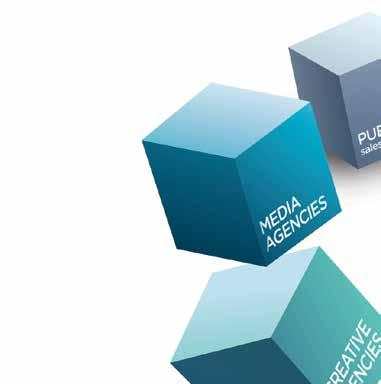
- Current postal and email addresses targeting marketing and communication decision makers

- In-depth and up to date insight and intelligence on European advertisers and agencies, brands and media (geographic location, sector participation, number of employees etc.)

- The relationships between the advertisers and their agencies (who works with whom?)
- Advertiser spend across media (e.g. who is spending most in digital media in France)
- Detailed contact information for key target people including job title and function www.tbsgroup-europe.com call:44 (0) 203 7014953
The Whispers of Kookaburra
Our journey in Australia: between New South Wales and Queensland. What impressed us the most?

The pitch darkness of the night, the sky that it seems you can touch with a finger, the lighting almost absent in smaller towns, farms surrounded by beautiful soft green carpets for spotting the terrible deadly snakes, the hysterical laughter of the kookaburra that wakes you up in the morning, the rush for dinner because the kitchens close at 19.30. The pain in the heart, for fear of running out of petrol in the middle of nowhere. The stop service interrupted by motorists who ask you: “Everything okay?” and the understanding that all our codes of order, distance, effort, work, suddenly become relative.
Narrabri NSW 2390 30°19'30.21"S 149°46'58.73"E The Australia Telescope Compact Array is a radio telescope operated by CSIRO at the Paul Wild Observatory, 25 km west of the town of Narrabri. Because of the deep darkness that distinguishes the Australian outback, and as the roads are often not lit, it is not recommended to travel at night in order to avoid terrible accidents, especially with kangaroos and koalas.
134 Work Style — #14.14 Work Style — #14.14 135
*let’s connect
05
04 Torraweenah 07 Brisbane 06 Gold Coast 03 Hunter Valley Pokolbin 01 Sydney 02 Forbes 05 Narrabri 08 Theodore
TBS
is a company of TBS Group, leading
and software provider for Marketing
UK
intelligence solution
From 01 to 02
Katoomba NSW 2780

(from Sydney to Forbes)
33°42'51.32"S 150°18'29.85"E
Typical Australian landscape, characterized by huge, flat, often desert lands punctuated by rare vegetation, and immense skies.

From 07 to 08
Bunya QLD (from Brisbane to Theodore)
27°21'59.12"S 152°55'51.28"E
Scattered small villages with architectural features reminiscent of the old Wild West. Places where the clouds seem to touch the ground, and if you stretch your hand out you have the impression of being able to touch them.
136 Work Style — #14.14 Work Style — #14.14 137
06 Gold Coast QLD 28°1'2.14"S 153°25'32.52"E

Around 90% of the Australian population live on the coast. The Gold Coast region grew significantly after the establishment of the Surfers Paradise hotel in the late 1920s.
The area boomed in the 1980s as a leading tourist destination and in 1994 the Gold Coast city local government area became the second most populous local government area in Australia, only after Brisbane.
02 Forbes NSW 2871 33°23'7.33"S 148°0'28.89"E
A wooden house lit up at night within the Vast Solar headquarters area, an Australian company active in renewable energies. Nocturnal insects are definitely a presence during Australian nights and can be very noisy, almost scary too.

138 Work Style — #14.14 Work Style — #14.14 139
01 Sydney NSW 33°52'2.95"S 151°12'25.16"E

Overnight staying in camp tents at Sydney Observatory.
04 Tooraweenah NSW 2831 (on the way to Theodore) 31°26'26.15"S 148°54'38.98"E
The nation is highly dependent on road transport. Australia has the second highest level of car ownership in the world. An extensive passenger rail network connects many rural areas to major cities. The mining sector is reliant on rail in order to transport its products to Australian ports for export.

140 Work Style — #14.14
A series of floods hit Queensland at the beginning of December 2010.
At least 70 towns and over 200,000 people were affected. Damage was estimated by US$ 2.38 billion. Three-quarters of the council areas within the state of Queensland were declared disaster zones.


Work Style — #14.14 143
03 Pokolbin NSW 2320 32°46'21.49"S 151°18'10.91"E
The Australian mainland has a total coastline length of 35,876 km with an additional 23,859 km of island coastlines. Deserts cover 18% of the Australian mainland. However, other areas are also considered to have a desert climate based on their rainfall and high temperature. While Australian farmers and grazers own 61% of the land, across the country there is a mix of irrigation and dryland farming.

144 Work Style — #14.14 Work Style — #14.14 145
From 07 to 08 On the way to Theodore QLD 4719 24°56'45.35"S 150°4'32.18"E
From 08 to 07 On the way to Brisbane QLD 27°28'15.64"S 153°1'24.42"E
There are three different categories of Australian roads: federal highways, state highways and local roads. The road network comprises a total of 913,000 km. Victoria has the largest network, with thousands of smaller arterials.

Work Style — #14.14 147
Where to Work Discovering the Cities
Australia: Untamed Nature
Huge spaces getting smaller through connectivity.
• AlpTransit Ceneri Railway Base Tunnel (15.4 km)
• BLS AlpTransit Loetschberg Railway Base Tunnel (34.6 km)
• AxPO Kraftwerke Linth-Limmern AG Linth-Limmern Hydroelectric Power Plant (1,480 MW)

• Swiss Federal Railways Refurbishment of the 4-metre corridor tunnels Basel-Chiasso
• Swiss Federal Roads Office (FEDRO) Motorway refurbishment (40.5 km)
• BBT Brennero Railway Base Tunnel (55km)
Compared to New Zealand and the U.S, there isn’t as much scenic diversity in Australia, so it’s possible to drive over 600 kilometers a day without getting worn out. Wildlife is fascinating and there are a lot of weird things, some of which are hazardous to health, like saltwater crocs or snakes. The thing that may impress you most is the night: you will hear to an indeterminable number of different sounds, sometimes really strange, like the cry of a bird that sounds like a angry cat. The food in Australia is rich in influences from all over the world, but a special mention goes to a strange nourishment that Australians love: ‘Vegemite’. Vegemite is a spread that looks like tar, smells like yeast, and tastes like salt, and many Aussies smear it on crackers or bread.
HIGH LABOR COSTS

In general, Australia is quite expensive, especially if you stay in Sydney. For example, we paid AUD$70 for 4 hours car parking in the city. Labor costs in Australia increased from 101.10 index points in the first quarter of 2014 to 101.90 index points in the second. This is not good for production and the di-
rect consequence is a huge manufacturing labor cost. Companies such as Ford and Holden have already closed assembly lines, and Electrolux have closed their refrigerator factory in Orange. The quarterly employment data from the ABS clearly show an industry in contraction, with the total number of people employed in manufacturing and the industry’s employment share falling sharply over the past 30 years, from nearly 17% of total employment in 1984 to just 8% as at November 2013.
BUSH? NO, THANKS
Most of the Aussies we met during our journey were really friendly, honest, open and trusting. Some might consider them to be "naïve." It seems that they generally don’t like pretension and class barriers. Compared to America, there’s more emphasis on personal responsibility and independence, and less on litigation, and didn't hear anyone bragging about their own personal success reciting data one after the other, and this is refreshing and allows me to think that they are also less focused on competition, in all fields.
AFTER SPENDING THREE WEEKS AND TRAVELLING 4,000 KM WHAT DID I BRING BACK?
Australia is a great country, still being an island, so we tend to think that insulation is the most appropriate term and the greatest fear of Australians. But it is not. I could use a similarity to define the business realities we encountered as platforms on land. Autonomous and isolated, but it is not. Australians have been able to build over time a close relationship with nature. A symbiosis characterized by simplicity, from no frills and a strong awareness of what is happening around them. The vast outdoors are greatly reduced due to the strong sense of belonging to a community that is revealed through persistent connections. The few distractions push them to concentrate on creativity and innovation, which generate motivated young people, while isolation from the rest of the world is mitigated by technology.
Australia is therefore a country based on technological, social and innovative connectivity; and this is what makes it a great country.•
INTERCONNECTIVITY
We went to Australia to meet several companies operating in different sectors, such as breeding, farming, wine production, technology, robotics, astronomy, research, renewable energy and marine. We discovered that these companies, although from very diverse industries, have one thing in common: interconnectivity. What does it mean to be interconnected? It means to be able to build a relationship with
your own territory as well as the rest of the world even though physically located in extremely remote areas. The text is by Cristina Milani, Swiss born, now lives and works in Milan. She’s the founder and chairwoman of Gentletude, an international notfor-profit organization promoting kindness. She’s recently been appointed vice-chairwoman of the World Kindness Movement. She also works as a freelance journalist for Work Style magazine [W australia.com australia.gov.au immi.gov.au]

and other publications. The photos are by Paolo Mazzo. He was born in Padua in 1961. Paolo has been a professional photographer since 1988. He’s the author of various reportages on a number of topics, including the urbanistic analysis of the cities where he has lived. Paolo is partner of F38F photographers, a company that specializes in advertising, editorial and architectural photography. He currently lives and works in Milan.
THE COMPANIES
• Australia Telescope Compact Array
• CSIRO
• De Bortoli Wines
• Emu Logic
• Gold Coast City Marina & Shipyard
• The Sydney Institute of Marine Science
• Tyrrell’s Wines
• Vast Solar
• Willtony Brahman & Performance Horse Stud
Work Style — #14.14 Work Style — #14.14 149
Work Style Troupe in Australia
Journalist CRISTINA MILANI and Photographer PAOLO MAZZO
If you feel like a mole, this is the place to work for you: come and plan tunnels with us! Our
Major Projects
www.piniswiss.com
The Sydney Institute of Marine Science Sydney.

By the end of this century, the world’s oceans will have a much higher concentration of carbon dioxide and will be several degrees warmer than they are today. Many species that live in Australia’s coastal waters will have to adapt to these harsh conditions in order to survive. It is known that such adaptation is possible, but it is still unknown which inherited genes can protect marine animals from the effects of climate change. Finding these genes will be crucial to manage the impact of climate change on important marine industries, such as oyster farming, which are worth hundreds of millions of dollars to the Australian economy every year. Australia is the center of temperature increases, far more than other countries, and for this reason a hub that includes the US, China and Europe is being created to analyze the effects of climate change on the coastal environment, for a global understanding.•
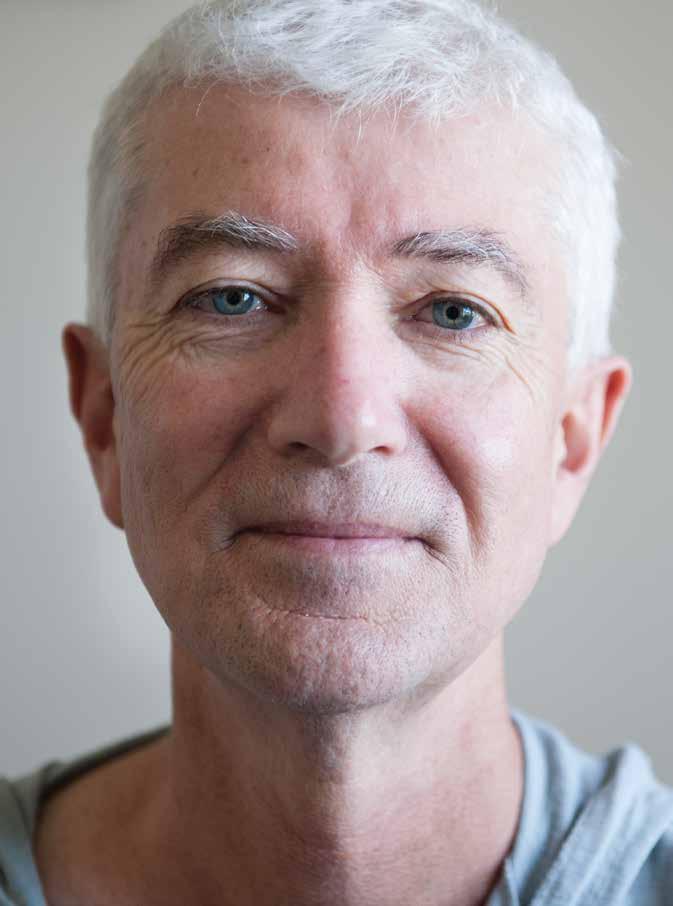
150 Work Style — #14.14 Work Style — #14.14 151 01 Associate Professor David Raftos, Macquarie University
[W sims.org.au/research/current-projects/climate-proofing-the-sydney-rock-oyster-industry]
02 Oyster-breeding tanks
Vast Solar, Solar Energy Forbes.
The Australian solar thermal power innovation company announced the construction of a 6MWth (1.1MWe) concentrating solar thermal (CST) power pilot plant near Forbes, New South Wales.
The project, which will demonstrate Vast Solar’s low-cost, high-efficiency CST generation system, is mostly funded by private investment, with significant support from the Australian Renewable Energy Agency (ARENA). The first-of-a kind project, which includes three hours of thermal storage that will enable the plant to generate electricity day or night on demand, is expected to be operating to supply electricity into the national energy market by the end of the year.

Forbes is the ideal place for the production of energy as it’s easy to connect to the line to spread energy throughout Australia. Not only that, the model chosen, focused on two elements, technology provider and know-how, puts them in contact with European, African and Asian business partners.•
 James Fisher, founder and Chief Technical Officer
James Fisher, founder and Chief Technical Officer
152 Work Style — #14.14
[W vastsolar.com]
04
03 Engineer working at his desk on the porch
Tyrrell's and De Bortoli Wines Pokolbin Hunter Valley.

Established in 1858 by English immigrant Edward Tyrrell, Tyrrell’s Wines is one of Australia’s pre-eminent family-owned wine companies, with vineyards extending from their historic home in the Hunter Valley to the Limestone Coast (SA) and Heathcote (VIC). De Bortoli Wines is a third-generation family wine company established by Vittorio and Giuseppina De Bortoli in 1928. The couple emigrated to Australia from a mountain village at the foothills of the Italian Alps, near the historic town of Asolo. Bruce Tyrrell, owner, Andrew Pengilly, vineyard manager, and Marcus Bridges, cellar door manager, contribute to the success of the company today. The cost of maintaining the vineyards in the Hunter Valley is very high, considering that De Bortoli Wines spent over AUD$35,000 just for water in 2014. Notwithstanding, the company offers more than 200 different products. Hunter Valley is in fact a mega mall of fine wines, which allows manufacturers to connect directly with the end customer and to increase their visibility and therefore their prestige and the reputation of the brands and the wines produced. Consequently, the actual gain derives also from the sale of less prestigious wines.•

Work Style — #14.14 155
[W
]
05 Blackboard celebrating the company’s 150th anniversary
tyrrells.com.au debortoli.com.au
06 Marcus Bridges, cellar door manager at De Bortoli Wines, sitting on a barrel
Emu Logic Tooraweenah.
07 Emu egg storage

Penny Henley is the owner of a farm that has chosen to focus on breeding emus, offering a wide range of top quality products, including oils, soaps and lip balms, and also providing the region of Victoria with meat and eggs. Although 800 km from Sidney, the activity is growing due to the use of technology, particularly internet, which allows them not only to sell their products all over Australia but also to communicate with customers in Malaysia and in other parts of the world.•

156 Work Style — #14.14 Work Style — #14.14 157
[W emulogic.com.au]
08 Example of a grown up emu, weighing approximately 55 kg
Australia Telescope Compact Array, Astronomy Culgoora, Narrabri.
The Australian Telescope Compact Array is one of the world’s most advanced radio telescope centers. It is used for more than 100 different observing projects each year. The subjects studied include: the early stages of star formation, the late stages of the lives of stars' molecules in space supernovas (exploding stars) and supernova remnants (the radio-emitting debris left by the explosions), magnetic fields in galaxies radio-emitting jets of material from black holes, and how hydrogen gas (the raw material from stars) is distributed in the local universe. As the sun and the black holes produce a lot of noise, the researches done at the observatory allow the better management of earth communications. Wireless is definitely one of the findings from these researches. Every year, the observatory welcomes researchers from all over the world, including the USA, Japan, Italy and Switzerland. The center bases its fundraising strategy on intensive public relations activity, so each year thousands of interested and curious people visit it. This allows it to increase its own prestige and therefore to receive research grants.•


Work Style — #14.14 159
[W narrabri.atnf.csiro.au]
09 Radio telescopes situated in the park
10 Glen Nagle, CASS visitor center
Gold Coast City Marina & Shipyard Coomera.

The company, run by Steve Sammes, general manager, offers facilities for berthing, maintaining and refitting boats of all sizes. Since its development in 2000, the purpose-designed marina, factories, showrooms and offices at the expansive facility are ideally located to serve the needs of all types of boat owners, ranging from jet skis to super yachts. Its rapid growth is due to the proximity to the Pacific, its competitive costs, and the creation of an area offering all services/products dedicated to the shipping industry. This has allowed the Gold Coast City Marina & Shipyard to become, in only a few years, the biggest spot in the southern hemisphere and the largest in Australia for the services offered. While maintaining company's main focus on domestic business, it is also part of larger organizations such as Super Yachts that have a presence in, for example,Thailand and Singapore.•

160 Work Style — #14.14
[W gccm.com.au]
12 One of the 150 artisans working on leather coverings
11 Yachts being prepared before launch
CSIRO Commonwealth Scientific and Industrial Research Organization Brisbane.
This lightweight mobile device can generate real-time precise 3D models of objects or scenes, overlaid with accurate temperature information. Currently a research prototype, HeatWave is expected to have applications in industries such as energy, building, manufacturing, construction, emergency services and health. The basic concept is that human plus machine gives a high performance workplace, going beyond the concept of the machine replacing man. Now the machine removes man from dangerous situations. This is the case of the HeatWave project, which allows the reading of data through an object’s thermal uniting vision 3D RGB to give a 3D image detail. So it gives humans the ability to carry out remote analysis, diagnosis and repairs, even in dangerous situations.•


Work Style — #14.14 163
[W csiro.au/Outcomes/ICT-and-Services/HeatWave-technology.aspx]
13 Emeli Hernández checking his own invention
14 Peyman Moghadam, research scientist, working on the project HeatWave: Mobile 3D Thermal Mapping in Real Time
Willtony Brahman & Performance Horse Stud Theodore.

Stud breeders have focused on the use of artificial intelligence to gain the best access to genetics and strengthen bloodlines. AI also helps to maintain a high standard of quality and to keep up to date with the new genetics available to breeders. In a huge space, where life is punctuated by animals far away from the cities, the entrepreneurial skill is in the attention to detail. In this case the selection of DNA through technology, the qualified staff and especially the volunteers from all over the world that the Pelling family, thanks to the internet, welcomes to the farm for various lengths of time throughout the year.•

164 Work Style — #14.14 Work Style — #14.14 165
[W willtony.com.au]
08 Brahman cattle
15 Mary-Lou Pelling, owner, with one of her purebred horses
Where to Work Focus on Africa
By SAM NALLEN COPLEY
Why Libreville Works
Gabon is a country that could have gone horribly wrong. Investors have been wary of Africa since decolonization. Gabon, however is a strong economic power that has been able to make it work.
MPONGWE TRADE
Libreville is the capital city of the tiny West African oil-rich nation of Gabon. With a population of around 600,000, the Atlantic port town is roughly the size of Genoa and houses almost half the nation’s citizens. Situated on the north bank of the Gabon River estuary, the region was home to the Mpongwe people, who were the first to set up international business in the area in the late 18th century, trading ebony, rubber, ivory and even slaves for firearms, alcohol and iron with visiting Europeans. Two hundred and fifty years on, the city continues to shine as one of Africa’s most business-friendly and livable cities. Considering the country’s 40-plus ethnic groups and the volatility of the centralwest African coast, Libreville’s story is truly remarkable.
VOLATILITY OF AFRICA
With wars of independence in Algeria, Sudan, Nigeria, Namibia, Mozambique and many other countries in the continent, breaking from European powers was a strenuous and bloodthirsty process. The US and the Soviet Union used many African nations to wage proxy battles during the Cold War, notably in Angola, Guinea-Bissau, the Congo and Namibia. The Second Congo War (1998-2003) was the deadliest conflict worldwide since the end of the Second World War, and destabilized a region already plagued by intertribal bloodshed and ethnic genocide. The Arab Spring rocked the Maghreb in 2011 and led to the ousting of two Egyptian presidents, the death of Libyan leader Muammar Gaddafi and political chaos throughout North Africa. In 2014, there are major conflicts – those causing at least 1,000 deaths per year – taking place in Soma-
lia, Nigeria, the Central African Republic and South Sudan. War hasn’t been the only obstacle to development in the continent; the existence of an apartheid government in South Africa from 1948 to 1994 hindered its economic growth in a variety of ways, notably because of the trade sanctions imposed on the country by the US, the UK and 23 other states. Natural disasters also haunt most of the continent, with drought affecting millions of Africans along the east coast, famine hitting hard just above the equator, and incidents of serious flooding all the way from Mozambique to Morocco.
WHY GABON MIGHT HAVE FAILED Gabon is a very small country, and although some African horror stories – the Democratic Republic of Congo and Su-
01
Désirey Minkoh was born in Libreville, Gabon. He graduated in photography at the Liege ISEC and then in photojournalism from Lille’s Ecole Supérieure de Journalisme. He worked as head of the photo department at the Union, Gabon’s national newspaper. Following that he worked as a freelance photojournalist for Agence France Presse, reporting from Central Africa with some operations in West Africa. His photos have appeared in the New York Times, Washington Post, Paris Match and L’Express among others. Today Désirey is the founder of Afrikimages, the biggest photo agency in Central Africa, counting 10 permanent photo reporters in Gabon, Congo, Ivory
dan, for instance – are set in vast ungovernable expanses, the inhabitants of Djibouti, Liberia and Rwanda know that living in a small country does not remove the threat of violence altogether. Similarly for business, size and reputation often go together. China, India and Brazil conjure particular images in the minds of potential investors, whereas smaller states may carry localized problems unknown to the outside world. This has traditionally scared business away from countries like Papua New Guinea. A small population also means fewer human resources, and lack of opportunities can drive the few with skills or vision away.

WHY GABON DIDN’T
Tucked in between Equatorial Guinea and Congo-Brazzaville, Gabon gained independence from France in 1960 and has enjoyed relative stability ever since, largely due to two factors. Immense oil reserves out to sea, discovered in the 1970s, pulled much of the Gabonese population out of extreme poverty. Consequently, the country enjoys relatively high wealth-per-head, with Gabon’s per capita income being roughly four times that of most sub-Saharan African nations. Although 70 percent of this comes from crude oil, there is also significant money in exporting timber, uranium and magnesium, all of which Gabon has in abundance, which may help to avoid a total dependency on oil. This may prove pivotal, as the fresh black gold reserve in the east Atlantic is starting to heat up relations with neighboring Equatorial Guinea, with both nations claiming ownership of Corisco, a tiny island thought to be enveloped by oil-rich waters. A new direction for the Gabonese economy may be eco-tourism; 85 percent of the country is covered by tropical humid rainforest in which there are thousands of gorillas, forest elephants, chimpanzees and hippopotamuses. With most of the population based around three cities, and having a relatively high stock of resources, distribution of wealth is easier in Gabon than it is in many African nations. Second, unlike certain other African nations, Gabon has – until 2010, when major reforms
took place – maintained friendly relations with its old colonial master, France.
In 1964, Lt. Jacques Mombo and Valere Essone forced President Leon M’ba out of office. The vice president requested assistance from the French, and within a few days M’ba was restored. Western intervention has caused chaos throughout the world – particularly within the last 15 years – but Gabon is small enough, and the tension was manageable enough, that even a brief flex of French muscles was sufficient to restore stability, and it hasn’t been forgotten; other than two foiled coup plots in 1990, there has been no real attempt to overthrow the Gabonese government since the early 1960s. Considering the region, this is very unusual. Eastern neighbor CongoBrazzaville, for instance, saw four successful coups between 1963 and 1997. While they have undoubtedly prevented widespread political violence, it should be noted that the French have, however, helped keep the hugely corrupt Bongo family in power for decades, who created a one-party state in 1968.
LIFE ON THE GROUND
Gerald Motumbo is a Nigerian estate agent and hotel manager who lives and works in the Mont-Bouet district of Libreville, an area famed for its enormous market. Speaking to me via Skype, he explained why Gabon is both an exciting and difficult place to be as a foreigner. “Libreville is certainly a very welcoming city. I have never really felt any danger here, unlike in Lagos where I used to work, and the locals seem to have no problem embracing me into their culture. I suppose with the mix of tribes in the area, foreign faces are relatively commonplace. The downside of trying to do international business here is that not many people outside Africa have even heard of Gabon – for that reason it’s hard to entice Europeans to do business here, as many people cannot even place the country on a map! Another drawback to living here is the price of just about everything. A typical meal at a downtown Libreville restaurant, for instance, costs around $30, which is rather pricey for an African city! We pay, I suppose, for the stability and possibili-
ties offered by this wonderful town, and having been here for several years now I cannot imagine living anywhere else.”
ALL FOR ONE, ONE FOR ALL
With this relative prosperity and stability, Libreville has become one of Africa’s most livable cities, so long as you have enough money. Traditional art museums, French wine and stunning beaches set the city apart from most West African capitals, and this vibrancy is kept alive by an extremely young population – half of all Gabonese are 19 or younger – with a remarkably high literacy rate – close to 90 percent. The important question is: as the oil reserves start to dwindle, will the country be able to shift its energy toward eco-tourism and other sectors effectively enough to maintain its state of affluence? For the moment, at least, Gabon punches well above its weight. While historical and geographic luck has undoubtedly played a role in this, the Libreville work ethic and lack of tension between its numerous ethnicities – and even workers from other countries like Mr. Motumbo – has allowed the Gabonese to overcome the hardship decolonization entails. While volatility continues to haunt most of the region, Gabon understood long ago that, “When spider webs unite, they can tie up a lion” (African proverb). •
Coast, Togo and Benin. He also trains and mentors young African photographers for his agency. His photos aim to capture everyday life in Gabon. In this series we take a look at the lives and jobs of health personnel in various medical centers in Gabon.
The photo is by and courtesy of Désirey Minkoh and Afrikimages.
01 Worker at the Oncology Institute of Angondje in Libreville
[W afrikimage.com]

166 Work Style — #14.14 Work Style — #14.14 167
[W cseaafrica.org]
Where to Work Focus on Africa
Where to Work Focus on Japan
By PETER CONRAD
Show Me Your Honne!
The elephant in the room is the “distance” between people, between things. This thin veil of fog that hides the sharp picture or defines the contours of things. Imagine a vivid HD picture with crisp colors where you can also see the imperfect granularity (the Western approach to reality), or a blurred picture where shapes are not clearly defined but where you also don’t see the imperfections, and the overall light exposure and colors create a harmonious mélange. The latter represents the Japanese way. Talking to my friends, I realized that on average the Japanese have fewer “friends” than Westerners. There are many reasons for this. Self-disclosure is limited, as are emotional displays, and the perceived benefits of telling your friends your problems and fears are probably less. People rarely reach out for help in a culture where bothering others with your issues is considered rude and selfish.
People prefer to elaborate their discomforts in loneliness and introspection. Time is another big problem. Working life basically consumes 90 percent of their adult lives, excluding sleeping time.

THE ART OF BEFRIENDING
There are basically two types of “friendships” in Japan. Those from school days, which are considered, by most, the only long-lasting and genuine friendships, and those you build in your workplace.
Your co-workers are the people you see most, the company is like a family and the boss is god. No wonder companies have created a way to incorporate private life into their structures rather than let it happen outside the workplace.
Reiko Nonaka is a Japanese photographer working and living in Paris. Her interest in photography started between 2000 and 2005.


During those years she attended a photography school in Osaka, while working at the same time. In 2002 Reiko had her first exhibitions, both group and solo shows. In order to improve her photographic work, she moved to Paris in 2005, where she studied art history at the Sorbonne - and where she obtained a master's degree in Photography and Contemporary Art at the University of Paris -.
01 02 03
About her work, Reiko explains, “Just after started studying photography, I moved to Kyoto and chose it as 'my corner' in Japan. Every day, life in Kyoto brings many small 'monogatari' (short stories). have often seen gestures and moments that we all thought today were long gone. Each monogatari developed in front of me in a blink of an eye, but it felt like they had been there for a long time,” She continues “These instants appeased me.”
01 Cherries blossom. A life starts

02 Remind me to never grow up 03 Cache, cache
04 A lifetime of childhood 05 Children on the shore All photos are by and courtesy of Reiko Nonaka [W reikononaka.com]
168 Work Style — #14.14 Work Style — #14.14 169
[W kimiko.fr pacea.fr]
Friendship might sound like a spontaneous evolution of human relationships where affinities and emotions create bonding and affection, but in Japan friendship is the result of an elaborate process.
DRINKING TOGETHER
One of the most important cultural dimensions of Japanese society is the “nomikai,” meaning “drinking to socialize.” Every company, big or small, has a lot of nomikais, usually at least once a week. A nomikai is driven by the head of the team, or an equivalent organizational unit, who invites his team members to join him for drinks after work. The term “invitation” is a euphemism, however, as participation is compulsory!

NO ExCUSES

In Japan you can’t just say, “Sorry, I’ve got plans,” “I’m playing sports,” “I have a date,” “I have a dentist’s appointment,” or “My child has a fever.” No. Company comes first, so nomikai is paramount. If you don’t attend it is considered extremely rude and disrespectful, signaling that you don’t fit into the team or into the company.
Some Japanese actually like it and some hate it. But nobody can avoid it. After work, the team goes to an inexpensive “izakaya” (a pub in Britain is the closest equivalent) to drink and eat some food, where the female staff will of course pour beer or wine for the boss (his glass can never be empty, that would be very rude) and maybe empty his ashtray, too.
After a couple of “kanpai” (toasts), you will see the whole atmosphere changing.
FROM FORMALITY TO BUDDYING UP






The magic of alcohol makes it happen again and again. The visible shift from the hyper-formal relationship of rules and expectations clears the way for private subjects and even intimate confessions about family, troubles and concerns. Also, work-related issues can be discussed with the boss in a casual way. In Japan, behavior is driven by the dichotomy between “honne” (the inner view, the real thinking) and “tatemae” (the outside view, the way to display oneself to preserve the harmony in relationships). Business relationships are normally driven by tatemae and by very formal communication. But the unwritten rule of the nomikai is, “If you show me your honne, I will show you mine.” This can sometimes be the formula for an embryonic form of friendship. Of course, the day after the nomikai, the relationship goes back to being formal, but still the bonding happened, something has been established.
WORK NEVER STOPS
For higher-level employees and executives, the weekends will be also usually be used to connect with the boss through playing golf together. Hence, work never stops.
The question is: how long will these friendships last? It’s difficult to say. Once you change company, although quite a rare event in Japan, you will most likely lose your old friends as you belong to a different team now.
Particularly for men, in Japan there can be a lot of loneliness after retirement. Most men don’t have friends or hobbies. They might join groups with similar interests in a specific area, but there’s nothing like the spontaneity of what we call friendship in Western cultures. Of course, in the countryside it’s probably very different as community life triggers friendship in a less conventional way. There, you might sometimes hear “Kyuki ni masari kagami nashi” – “There is no better mirror than an old friend.”•


170 Work Style — #14.14 Work Style — #14.14 171 05
04 EIS 2015 | ENGAGEMENT INNOVATION SUMMIT DELIVER EFFECTIVE ENGAGEMENT: INNOVATIVE STRATEGIES IN A CHANGING HR WORLD. 25TH & 26TH FEBRUARY 2015 LONDON HEATHROW MARRIOTT, UK • Discover the top 3 innovative methods of succession planning to improve the long-term success of your organisation • Understand how the most successful HR departments structure their reward systems to maximise engagement and deal with the changing unconventional working • Build your global employer brand to build brand advocacy internally and externally 20+ SPEAKERS FROM WORLD WIDE BRANDS BOOK YOUR PLACE TODAY: WWW.EIS2015.COM EARLY TICKETSBIRDNOW AVAILABLE BOOK NOW: EIS2015.COM















































































































































 by LIZ WISEMAN
by LIZ WISEMAN









 By FRANCESCA MORELLI
By FRANCESCA MORELLI















 By ALEX DI MARTINO
By ALEX DI MARTINO













































 TONEGUTTI
TONEGUTTI




















































































































































































































 James Fisher, founder and Chief Technical Officer
James Fisher, founder and Chief Technical Officer






















